


The Concert Choir, directed by Susan Chrzanowski, performs in the Winter Choral Concert in January in Hubbard Performance Hall. The program featured songs from around the world and across the centuries, including the West African Yoruba song “Ise Oluwa” and the 17th-century Italian aria “Cangia, cangia tue voglie.”
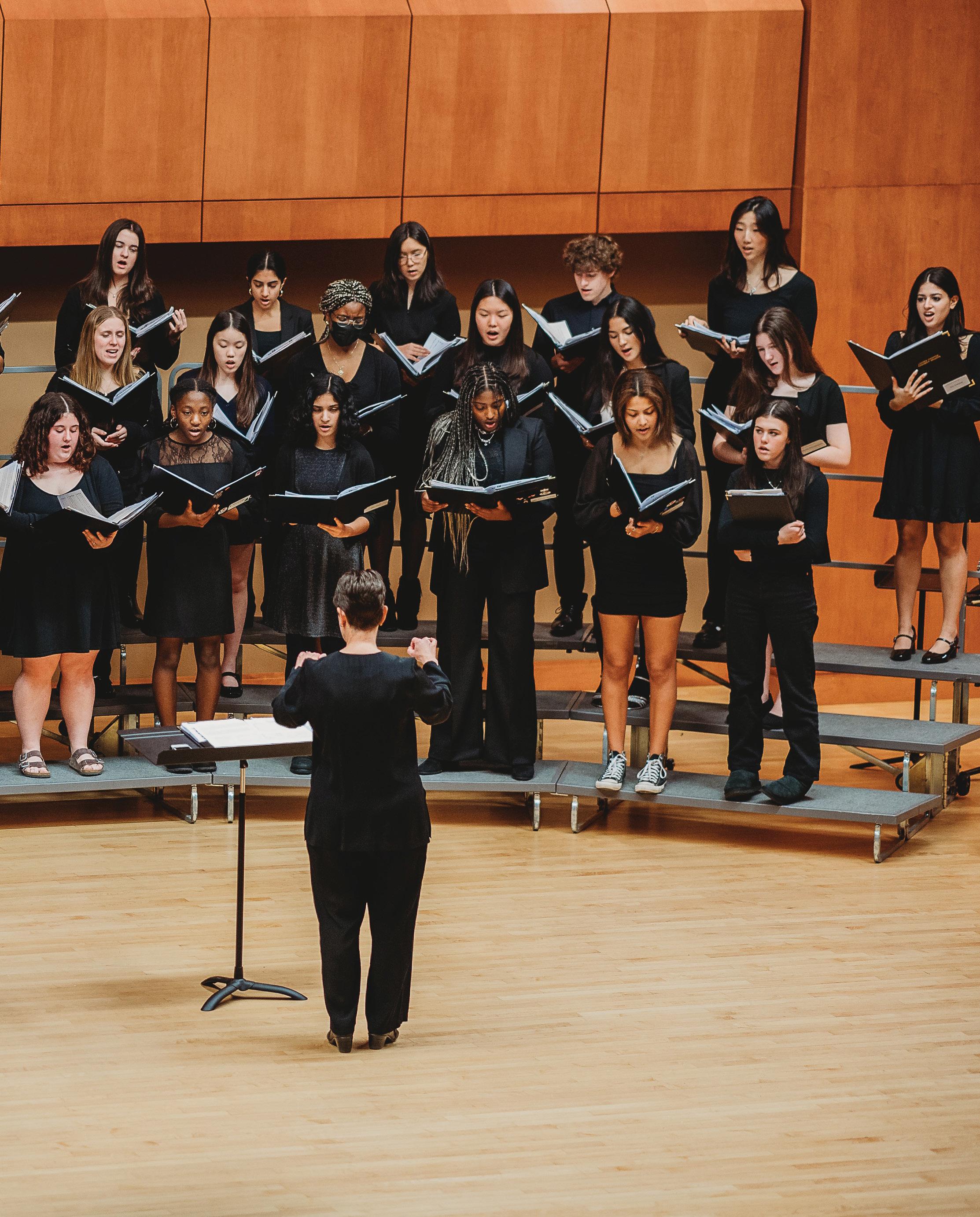
loomischaffee.org 1
ChatGPT



2 Loomis Chaffee Magazine Spring 2023 38
Cover: Aaron Civale ’13 pitches for the Cleveland Guardians. This page: James Lowenstein ’45, Anna Rachminov, and former U.S. Secretary of State Henry Kissinger at the French American Foundation 40th Anniversary Gala Dinner in 2016. • Author Heidi Erdmann Vance McCann ’93 • Cleveland Guardians pitcher Aaron Civale ’13 in bobblehead form
34 26
36
Complete Game
Major league pitcher Aaron Civale ’13 has an eye on the greater good, not just the strike zone.
Alumni Writers
For author Heidi Erdmann Vance McCann ’93, life provided the material, journaling brought clarity, and a memoir emerged over the course of 22 years.
Artificial Intelligence and Education
Does the arrival of artificial intelligence chatbots like ChatGPT present a conundrum for educators or an opportunity to reimagine the learning process?
Fact Finder
The course of the Vietnam War changed after the U.S. Senate Foreign Relations Committee sent staff consultants James G. Lowenstein ’45 and a colleague on a fact-finding mission to the war zone in 1969.
EDITORIAL & DESIGN TEAM
Lynn A. Petrillo ’86
Director of Strategic Communications & Marketing
Becky Purdy
Managing Editor
Kelley Albert
Senior Graphic Designer
Jeff Otterbein Obituaries Editor
CONTRIBUTORS
Jeff Otterbein
Paige Abrams
Heidi E.V. McCann ’93
Deidre Swords
Lisa Salinetti Ross
PHOTOGRAPHY
Courtesy of the Cleveland Guardians
Catherine Johanna Photography
Cassandra Hamer
Jessica Ravenelle
Lynn A. Petrillo ’86
Mary Coleman Forrester
Kelley Albert
Megan Du Plessis
Defining Studios
Jeff Otterbein
Stan Godlewski
The James Lowenstein Collection
Tony Dejack/AP/Shutterstock
Parker Harrington
Keith Allison
Teresa Hnat
U.S. Information Agency
U.S. Marine Corp/PFC G.Durbin
Cecil W. Stoughton
E.W. Pacil
Courtesy of the Franklin D. Roosevelt Presidential Library and Museum
Loomis Chaffee Archives
John Groo
Visit
• Windsor, CT 06095
social networking communities. For an online version of the magazine, go to www.loomischaffee.org/magazine.
loomischaffee.org 3
Loomis Chaffee online at
for the latest school
Printed at Lane Press Burlington, VT Printed on Sterling Ultra Matte Contents Spring 2023 | Volume 86 | No. 2 26 34 36 FEATURES
www.loomischaffee.org
news, sports scores, and galleries of recent photos. You also will find direct links to all of our
DEPARTMENTS 4 From the Head 5 Island News 21 Faculty & Staff News 22 Pelican Sports 44 Object Lesson 47 News from the Alumni/Development Office 54 Obituaries 65 Reflections SUBMISSIONS/STORIES & NEWS
contribute
interest
Loomis Chaffee Editors The Loomis
School
860.687.6811
magazine@loomis.org facebook.com/loomischaffee twitter.com/loomischaffee instagram.com/loomischaffee 38
School community members may
items of
to:
Chaffee
• 4 Batchelder Rd
•
Learning in Pandemic’s Wake
by Sheila Culbert
As I am writing this column, our admission team is getting ready to send out acceptances for the 2023–24 school year. The school has experienced a 26 percent increase in applications in the past couple of years with a corresponding decrease in the admit rate and an increase in yield. One explanation for the increase in applications is the way in which Loomis Chaffee, as well as similar peer boarding schools, handled COVID-19. Our admission results are one of the few positive outcomes for the school from the pandemic.
A June 2020 report1 by McKinsey & Company, “COVID-19 and student learning in the United States: The hurt could last a lifetime,” suggested that school closings, online learning, and the disruption caused by the virus exacerbated existing achievement gaps and increased student anxiety. The McKinsey report predicts that the virus will result in an average learning deficit of between seven and 12 months. The Department of Education’s 2022 Nation’s Report Card2, which looked at fourth and eighth grade achievement, found declines in reading and mathematics even for high-achieving students.

Unlike many day schools—both public and private—Loomis was able to adjust operations at key points during the pandemic in order to keep the school open and minimize interruptions in student learning. While we went online for the spring term of 2020, by the start of fall 2020 we were able to operate as an in-person day school with online options for boarders who couldn’t commute, and soon thereafter reopened our residence halls safely to resume boarding life. We created our bubble and had most students on campus throughout the pandemic. We are nonetheless seeing the sort of negative consequences that McKinsey reported. The students whom we admitted over the past two years, as well as this year, saw significant disruptions to
their middle school education. Many did not attend in-person school for a year or more, and others bounced back and forth between online and in-person—all of which has had an impact on our students in terms of mental health, social and emotional development, academic preparation, and self-discipline.
In the academic realm, we are seeing a wider range and disparity in academic preparation of incoming students, especially with regard to content mastery within mathematics and modern and classical language studies. Tim Lawrence, our director of studies, notes that “it is not just that more students have come to Loomis having covered less content typical of a given subject level, it is also that more of them have less confidence in that knowledge and how to apply it flexibly.” Perhaps even more concerning than the content gaps are the deficits in the sort of soft skills and habits of mind that are so critical for academic success, including time management, ability to work independently as well as collaboratively, and communication skills.
Outside of the classroom, the negative impact of COVID-19 is equally concerning. The Centers for Disease Control reports3 that 37 percent of high school students experienced poor mental health during the pandemic and 44 percent reported experiencing persistent
feelings of sadness or hopelessness. The pandemic significantly exacerbated what was already a nationwide problem with adolescent anxiety. The JED survey that Loomis undertook in the fall of 2021 confirmed that our students are more anxious than ever, and we have increased programming and resources aimed at mental health and wellness. In addition, many of our younger students missed the important socialization of middle school and, consequently, are less developed socially and emotionally. This is something we continue to address on a number of fronts as we help students build strong social and interpersonal connections.
I am confident that we have the faculty and the resources to address these needs, but we have needed to recalibrate expectations and provide additional supports for students to ensure that they can handle the rigorous academic curriculum that we provide, and, again as McKinsey noted, we will be managing these effects for years to come. The wonderful thing about boarding school is that it provides an immersive environment where students are surrounded by caring faculty as well as bright and talented peers and there is a heavy emphasis on collaboration, which will undoubtedly help our students respond particularly well to the ongoing consequences of the pandemic. If nothing else, the pandemic made us all appreciate the value of face-toface interactions and the power of an actual (as opposed to virtual) community.
1. https://www.mckinsey.com/industries/education/ our-insights/covid-19-and-student-learning-in-theunited-states-the-hurt-could-last-a-lifetime
2. https://www.nationsreportcard.gov/highlights/ ltt/2022/
3. https://www.cdc.gov/media/releases/2022/p0331youth-mental-health-covid-19.html
4 Loomis Chaffee Magazine Spring 2023
FROM THE HEAD
ISLAND NEWS
 Photo by Cassandra Hamer
Photo by Cassandra Hamer
$15 Million Gift Advances Three Loomis Chaffee Priorities
Inspired by conversations at the October 2022 Board of Trustees meeting, Mary Bucksbaum Scanlan ’87 has made a $15 million commitment to Loomis Chaffee to support three of the school’s ongoing priorities: student housing, financial aid, and teaching faculty salaries. She is joined in doing so by her husband, Patrick J. Scanlan.
“We are fortunate enough to be able to give in support of all three initiatives,” shared Mary, who serves as a vice-chair of the Board of Trustees and chair of the Board’s Development Committee. “I am particularly excited to help further the school’s continuing focuses on financial aid and on support for our teaching faculty. We need to compensate our teachers in a manner that reflects our strong belief in them and the mission of the school.”
From the $15 million gift, $3 million will go toward a challenge to raise a total of $5 million for teaching faculty salaries from current and former Trustees.
Another $4.5 million will fund a financial aid initiative during which Mary will match gifts 50 cents on the dollar of $50,000 or more to existing endowed scholarship funds and $100,000 or more for the creation of new endowed scholarship funds. The goal of this initiative is to challenge donors to think like the Founders in supporting
accessibility to Loomis Chaffee’s superb education.
Mary and Pat also created the Patrick J. Scanlan Scholarship and will endow the scholarship fund with $500,000 of their overall gift. The scholarship will be awarded to the child of an active or retired military service member.
The final $7 million of their gift will be directed to the renovation of Warham Hall and the construction of a new residence hall behind it, where the Business Office currently stands. The new dormitory will house 25 or 26 students, include two faculty apartments,
have its own common room, and have a physical connection to Warham, even though it will have a different name. With this residence hall project, the goal is to move all boarding students onto or close to the three main quadrangles, to have Longman Hall no longer serve as a dormitory, and to remove the temporary modular additions to Palmer and Harman halls.
“Through her service as an alumna and Trustee and her incredible financial support, Mary has transformed the Loomis Chaffee experience both in and out of the classroom,” commented Head of School Sheila Culbert. “We are so grateful for her generosity and commitment to the mission, vision, and direction of the school.”

Prior to this most recent commitment, Mary and Pat gave $15 million to Our Time Is Now: The Centennial Campaign for Loomis Chaffee. Their gift, along with the support of several other donors, facilitated the construction of the Scanlan Campus Center, which opened in 2018. The Scanlan Center, located in the middle of campus, has become a hub for community life and houses Loomis Chaffee’s dining facilities, including the Tisch Family Dining Hall and Wilbur Food Court, the student lounge and Lese Grill (the SNUG), the Alexander Bookstore, the Pearse Hub for Innovation (PHI), the Lyons Den, the Junyan Classroom, a faculty lounge, and the mailroom.
— SHEILA CULBERT
6 Loomis Chaffee Magazine Spring 2023
ISLAND NEWS
“Through her service as an alumna and Trustee and her incredible financial support, Mary has transformed the Loomis Chaffee experience both in and out of the classroom. We are so grateful for her generosity and commitment to the mission, vision, and direction of the school.”
Above:
and
at the
in
Pat
Mary
dedication of the Scanlan Campus Center
2018.
Fred Seebeck to Return as 2023 Commencement Speaker
Retired longtime Loomis Chaffee faculty member R. Frederick Seebeck will deliver the 2023 Commencement address on May 28.

Fred, or “Seebs” as he was fondly called on the Island, taught English and, at various times in his 37-year tenure, he was English Department head, a dean of students, an admission associate, a dorm head in Batchelder and Taylor Halls, an affiliate in Flagg and Warham Halls, a trusted and valued advisor to students, and a faculty advisor to the Student Council. He also coached swimming, water polo, and track.
“I regard my Loomis years as the best of my life: most of my close friends are fellow faculty members, the professional challenges and opportunities were broadening and fulfilling, and I was blessed to teach and coach hundreds of motivated, interesting, diverse, engaged, and devoted students over the years,” Fred says.
“I eagerly unwrapped every new day in anticipation of the variety of little challenges and rewards ahead of me, all precious gifts. Never a dull moment. The energy, humor, and genuine investment of Loomis students in the learning process kept me young and kept me motivated. And I am eternally grateful for, and indebted to, my wonderful colleagues and friends. Returning to the Island to honor the Class of ’23 will also allow me to express my deep gratitude to Loomis Chaffee for enriching my life beyond measure.”
After graduating from Brown University, Fred taught at St. George’s School in Rhode Island before taking an admission associate role at Loomis in 1983 in order to coach water polo, a sport not offered at St. George’s. He began teaching English full time at Loomis during his third year on the Island.
If Fred was a force of nature on the Island for so many years, so too were the events at the start and end of his career at Loomis.
— R. FREDERICK SEEBECK
In 1984, during his first year, spring flood waters rose so high that the campus truly became an island. Fred and fellow faculty member James “Grim” Wilson stayed in Flagg Hall with several boys who were unable to evacuate. Undaunted, Fred, Grim, and the boys paddled in canoes over the causeway one night to reach the school vans parked at the public library. They made their way to dinner and paddled back by canoe to the dorms.
COVID-19 caused its own version of widespread disruption in 2019–20, Fred’s final school year before he retired. The pandemic forced the shut-down of all schools in Connecticut, including Loomis, in March
2020. That spring Fred taught his English classes via Zoom video conference.
“I’m grateful that no one I love — let alone no one I know — perished during the pandemic,” Fred says. “Needless to say, it was a profoundly miserable stretch for all of humanity.
“During that final spring, I missed my students and my many faculty friends more than I can say. Lots of lonely walks to my classroom in Chaffee and around the Loop, through the Meadows at lunchtime breaks. And, along with the graduates of 2020, I missed out on my own ‘graduation’ from Loomis, missed the joyful and celebratory atmosphere of my own ‘final’ Commencement, so I eagerly anticipate sharing the excitement and emotion of the Class of ’23 on May 28.”
Fred’s many passions included his Loomis swimming and diving teams, which consistently were near the top of the New England Prep School Swimming Association and won 18 Founders League titles. He could be spotted around campus wearing one of his signature bow ties.
“I can’t recall when the bow tie tradition began, but it stretches back 25 years or more,” Fred says. “I wore a tie to my classroom nearly every day of my career (except occasionally during that final COVID-compromised term) to demonstrate respect for my profession, my students, and my colleagues.”
Fred was born in New Jersey, but his family moved to Chicago when he entered high school, which explains his family’s allegiance to the Chicago Cubs. Fred, who now lives in Rhode Island, has turned into a true New Englander — and is a longtime Boston Red Sox fan. One of his best Loomis memories is of a crowded Batchelder social room where Fred and the students cheered on the Red Sox as Boston won the 2004 World Series title, the team’s first since 1918.
loomischaffee.org 7
ISLAND NEWS
“Returning to the Island to honor the Class of ’23 will also allow me to express my deep gratitude to Loomis Chaffee for enriching my life beyond measure.”
New Committee Launches Search for Next Head of School
Anew committee of Trustees, faculty members, alumni, and parents has begun its search for Loomis Chaffee’s next head of school.
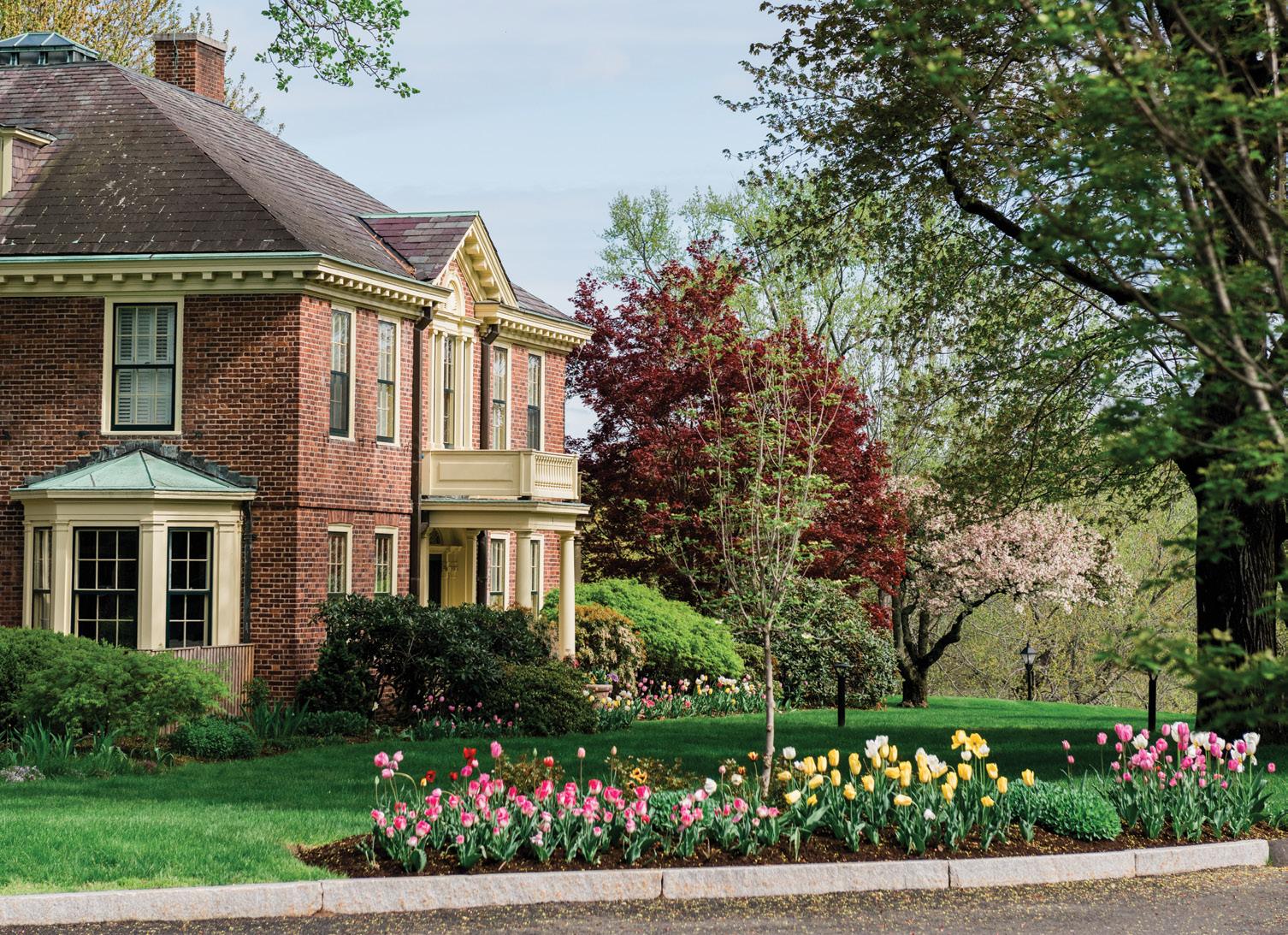
Chair of the Loomis Chaffee Board of Trustees
Duncan MacLean ’90, P’24 announced the formation of the new Head of School Search Committee on February 27. The 12-member committee comprises Trustees and faculty members, many of whom also are alumni and/or current or past parents and is led by Trustees Rachel Kort ’98 and David Rogan ’76, P’04.
“David and I are honored to serve the school in this capacity and look forward to working with our colleagues on the Search Committee and with the Loomis Chaffee community as a whole in this important endeavor,” shared Rachel.
The Board of Trustees reopened the search for a new head of school following a decision by an earlier finalist, who was named Loomis
Chaffee’s next head of school in August 2022, to reconsider his appointment in November. Current Head of School Sheila Culbert, who was slated to retire in June 2023, agreed to extend her tenure through June 2024 to give the school the time needed to conduct a new search.
The committee membership was selected by Duncan and the Board’s vice-chairs — Mary Bucksbaum Scanlan ’87; Harvey Struthers Jr. ’60, P’85, ’96; and Jamie Widdoes ’72 — in consultation with Sheila and Associate Head for External Relations Nat Follansbee. Their collective goal was to form a Search Committee whose membership “represents the diversity of experiences, identities, and perspectives” in the Loomis Chaffee community as well as “demonstrated advocacy for the school and its mission.” The committee includes a mix of members who served on the 2022 Search Committee and new members.
The charge to the Search Committee is to recommend to the Board of Trustees the single best candidate to lead the school
starting in July 2024. It is the responsibility of the Board to appoint the new head of school.
“One of the most important responsibilities of the Board is appointing a new head of school,” David shared. “The Search Committee is humbled by its role in this process and enthusiastically commenced its work on March 1.”
In his email, Duncan thanked the members of the last Search Committee and Bruce Alexander ’61, who served as chair. “My partnership with Bruce in the last search showed me his deep devotion and love for Loomis Chaffee,” wrote Duncan. “I very much appreciate the thoughtful process he chaired as the embodiment of ‘our best selves for the common good.’”
The Board of Trustees and the Search Committee invites the Loomis Chaffee community and general public to visit the Head of School Search web page often for the latest search news and updates at www.loomischaffee.org/about-us/head-ofschool-search.
Members of the Head of School Search Committee
Rachel Kort ’98, Trustee (Co-Chair)
David Rogan ’76, P ’04, Trustee (Co-Chair)
Courtney Ackeifi ’06, Trustee
Lori Caligiuri P’21, ’24, Faculty
Pauline Chen ’82, P’20, ’20, Trustee
Lance Hall, Administrative Faculty
Courtney Jackson, Faculty
Jonathan Kelly ’81, Trustee
Elizabeth Leyden, Faculty
Mary Bucksbaum Scanlan ’87, Trustee
Martin Vulliez ’90, P’23, ’24, Trustee
Duncan MacLean ’90, P’24, Trustee (ex officio)
Lynn Petrillo ’86, Administrative Faculty (Secretary)
8 Loomis Chaffee Magazine Spring 2023
ISLAND NEWS
For Sandy Hook Families, Chris Mattei ’96 Fights Against the Lies
Empathy plays an important part in Chris Mattei’s ’96 work as a trial lawyer, never more so than when Chris presented a case last fall on behalf of Sandy Hook families against conspiracy theorist Alex Jones, who spread lies to his millions of followers about the 2012 mass shooting.
The Connecticut jury in October returned a $1 billion judgment against Mr. Jones and the parent company of his Infowars website, and the court later added $473 million in punitive damages.
In a forum for Loomis students and faculty in the Norton Family Center for the Common Good in December, Chris, a lawyer with the firm Koskoff Koskoff & Bieder, discussed the case, his career, and the importance of Loomis Chaffee in his life. Woven throughout the discussion was the concept of empathy, this year’s school theme.
As lead counsel for the Sandy Hook families and first responders, Chris said he spent 80
percent to 90 percent of his work time over the last two to three years on the case, much of it with families of the children and staff members who were killed in the shooting at Sandy Hook Elementary School in Newtown, Connecticut. Getting to know the families and reflecting on what it must have been like for them to lose a child or other loved one in this violent attack had a profound effect on Chris, he said. “I internalized their stories deeply,” he said. “It changed me.”
As a result, Chris felt an enormous responsibility to present the case in a way that respected the families, their stories, and their grief. He also felt that the jurors would perceive his genuine empathy and compassion for the families, giving him credibility with the people who would decide the case.
Credibility was especially important because Chris and the other attorneys for the plaintiffs would ask the jury to award a billion dollars in damages — monetary compensation for the suffering caused by Mr. Jones’s lies. Through his media channels, Mr. Jones purported for years that the shooting never happened, that the parents of the victims were actors, and that the massacre was just
a ruse to enable the U.S. government to take away citizens’ guns. Mr. Jones later acknowledged that the shooting did happen, but by then, the plaintiffs’ lawyers argued, he had made millions of dollars from the lies.
“We wanted to make sure [the jurors] understood how this lie that the children didn’t die and that the parents were actors spread online and through social media” to hundreds of millions of people, Chris said. The magnitude of the lie’s dissemination meant the damage it inflicted was immense as well, he explained.
Chris joined Koskoff Koskoff & Bieder in 2015 after serving for eight years in the U.S. Attorney’s Office in Connecticut, where he led the Financial Fraud & Public Corruption unit and helped to prosecute a number of government corruption cases. Chris earned his bachelor’s degree from Georgetown University and his law degree from University of Connecticut School of Law. Before attending law school, he taught English on a Navajo reservation in Arizona and worked as a union organizer for health care workers in California.
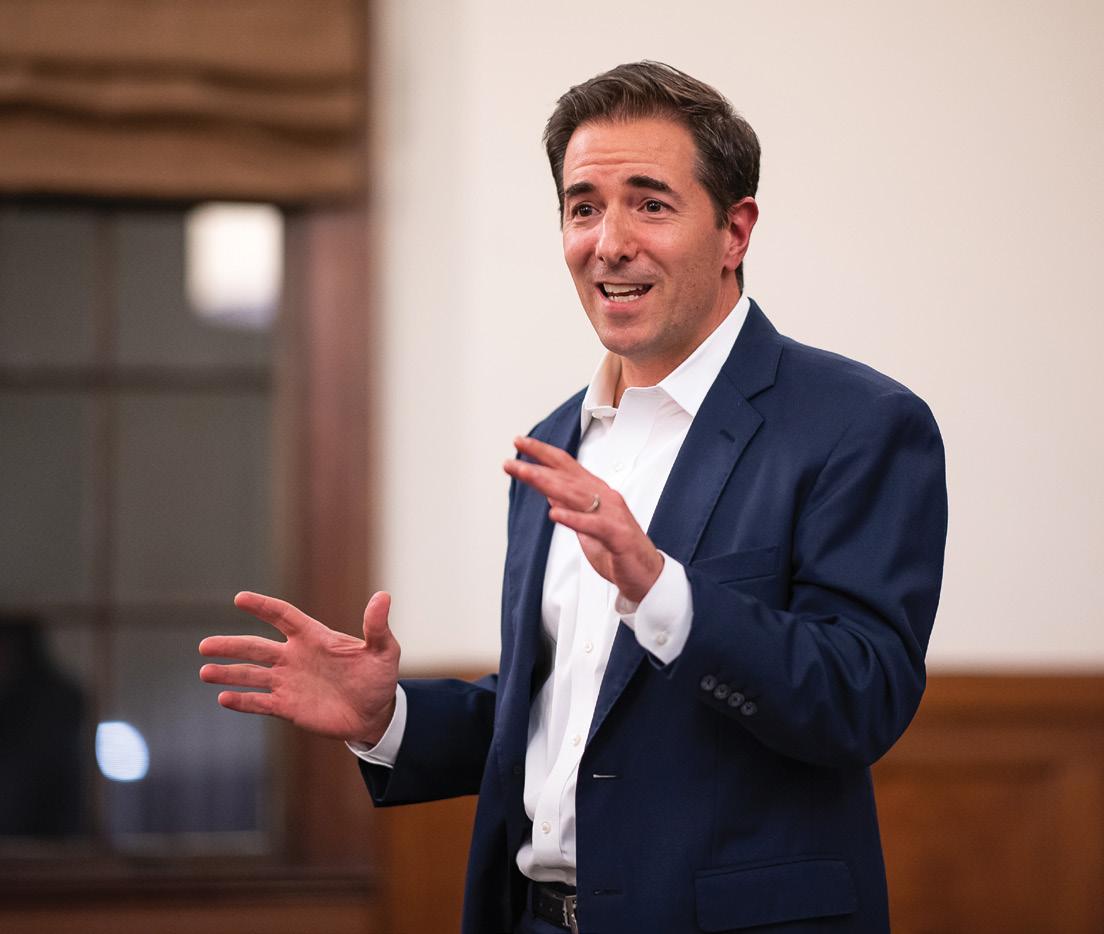
Chris, who grew up in Windsor, said attending Loomis Chaffee “was the most important decision I ever made in my life.”
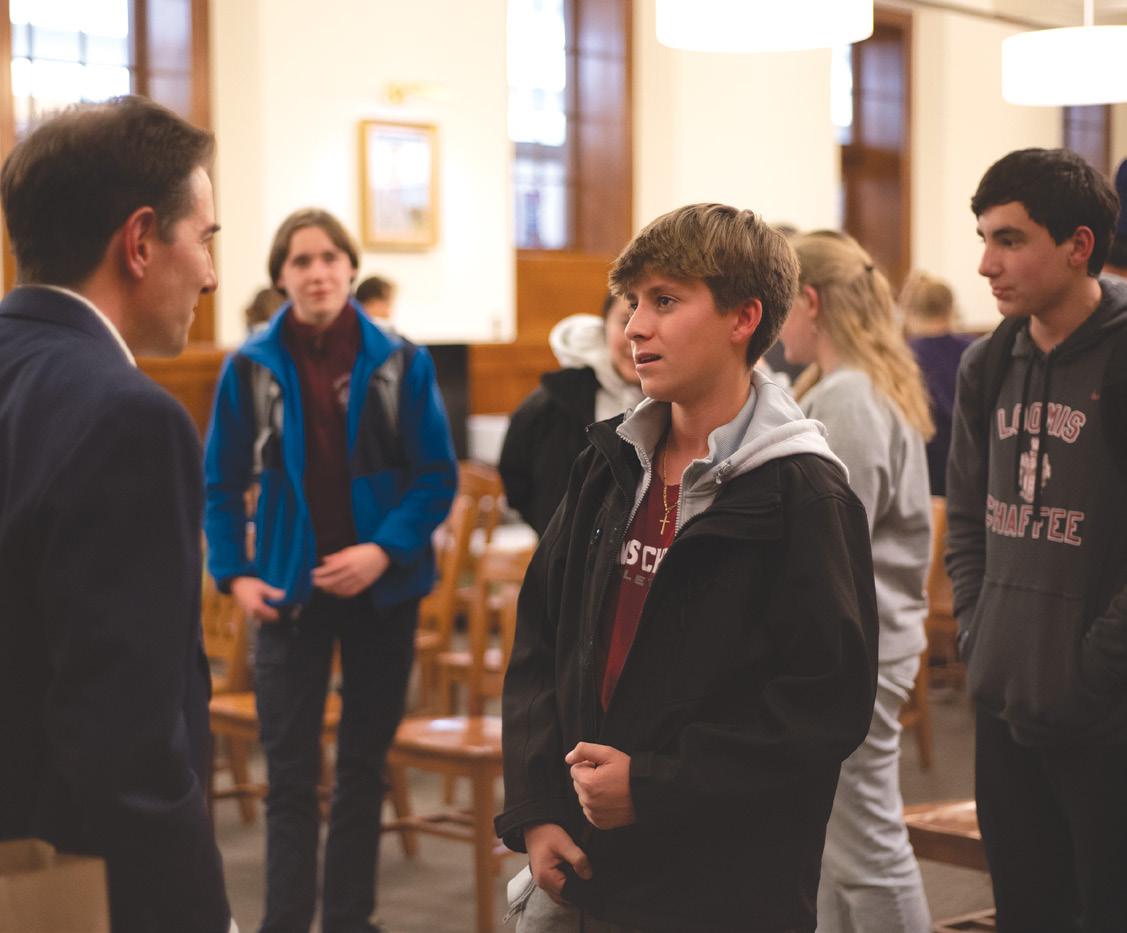
loomischaffee.org 9
ISLAND NEWS
Top: Chris speaks to students and faculty in the Norton Family Center for the Common Good and connects informally with students after the forum.
Theme of Empathy Runs Through Winter Convocations
Fighting inequalities. Working on relationships. Not letting fear stop you. Loomis Chaffee students walked away knowing more on a variety of topics as three convocations were held during the winter term in the Olcott Center.
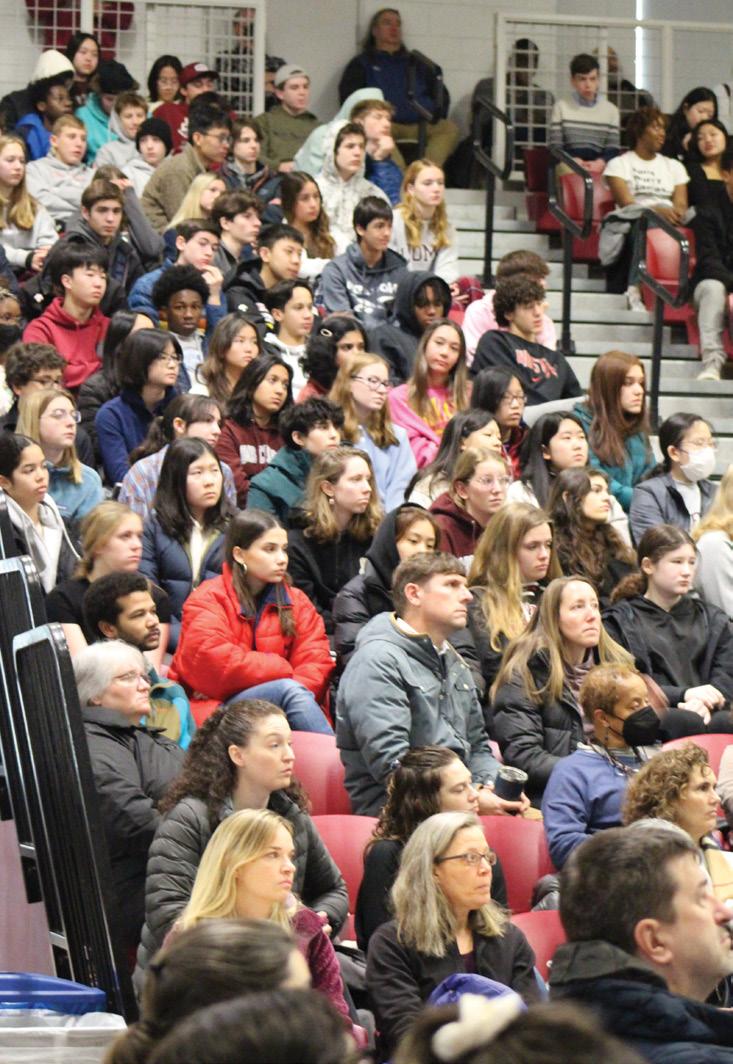

“What I hope you look for is the thing that both feeds you and energizes you.”
Ads for smoking cigarettes targeting Blacks. Denying loans for Blacks to buy houses. Building segregated neighborhoods. Running highways around and through minority neighborhoods with all the accompanying pollution. This has been some of the reality of America that Dr. Tsai pointed out during an all-school address.
As Dr. Tsai spoke about health inequality at the Martin Luther King Day convocation, a screen behind her showed these and other stats: Black and Hispanic populations have higher exposure to 13 out of 14 main pollutants; they are twice as likely to live less than two miles from toxic waste sites.
In response to a question from a student, Dr. Tsai said there are many ways to help change health inequities, and she recommended that people use the fields of study, professions, and skills that interest them to work toward change.
“What I hope you walk away with is that this is an all-hands-on-deck kind of situation,” she told the student body. “There are so many ways to fight inequality, and so many ways we need to fight inequality, so I hope you get a little upset and angry about the world
the way it is. And what I hope you look for is the thing that both feeds you and energizes you ... so that could mean policy, that could mean green spaces, that could mean writing, that could mean being a doctor, that could mean being a lawyer. That could be a hundred thousand things, so whatever feeds you and fights inequality.”
February
“Treat others the way THEY want to be treated.”
Ms. Fonte, who addressed the school community as part of Healthy Love Week at Loomis Chaffee, asked her audience to think a little deeper than usual about the golden rule.


“Treat others the way you want to be treated as an exercise for empathy,” prompted Ms. Fonte, an intersectional health educator. Applying this principle to relationships raises questions, she said. “Someone tell me what is problematic about the golden rule if we are trying to teach people about consent and asking what other people need and want?” she asked the students in the Olcott Center.
A couple of students answered, the second one allowing Ms. Fonte to echo the thought.
10 Loomis Chaffee Magazine Spring 2023
ISLAND NEWS
January 6: Dr. Jenny Tsai
“There are so many ways to fight inequality, and so many ways we need to fight inequality, so I hope you get a little upset and angry about the world the way it is.”
— JENNY TSAI
7: Justine Ang Fonte
Left: Students and faculty listen to Jenny Tsai’s convocation address. Above: Dr. Tsai at the podium Below: Junior Anuva Kolli and senior Angelina Amastal field audience questions for Dr. Tsai. Right: Justine Ang Fonte discusses healthy relationships, the subject of her convocation address in the Olcott Center.
“Someone might not be OK with the same things you are OK with. If I like anchovies on my pizza, I’m just going to assume you all do, too. That’s a big leap,” she said. “Let’s do an update, the platinum rule. Treat others the way they want to be treated. How do we figure out how someone else wants to be treated? You ask, you communicate, you negotiate.”
She spoke to the Loomis audience about such topics as boundaries, healthy relationships, and respect for each other.
“It’s a two-way street,” Ms. Fonte said. “That’s what a relationship is.”
“Everyone around you feels [fear], everyone experiences it, but don’t let that stop you.”
Among the messages delivered by Mr. Bellamy to the Loomis Chaffee community was that fear is a normal part of the human experience but that it need not paralyze you.

Easier said than done, but when students left his presentation, they knew they were not alone with their fears.
Mr. Bellamy visited campus as part of the Hubbard Speaker Series, made possible by a gift from Robert P. Hubbard ’47.
Mr. Bellamy has spoken to thousands of students and collected more than 55,000 fears on note cards over the years. He collected many more during his time on the Island as he asked students to write down their fears. He wanted his listeners to realize that they were not isolated.
“I want students to know and understand that I want them to be fearful at times, to be nervous, to have anxiety because it usually means they are stepping up and putting themselves out of their comfort zone,” he said shortly before the students arrived in the Olcott Center. His message wasn’t for his listeners to be fearless all the time. “I want them to feel that fear and take that next step and have fearless moments. Everyone around you feels it, everyone experiences it, but don’t let that stop you.”

loomischaffee.org 11 ISLAND NEWS
Top: Junior Angela Adu-Boateng, sitting between classmates Jazmyne Ahipeaud and Nana Achiaa Donkor, asks a question of Darryl Bellamy during the convocation. Above: Mr. Bellamy sorts through Loomis Chaffee students’ notes about their fears.
February 17: Darryl Bellamy Jr.
The Inner Rewards of Reaching Out
Junior Angela Adu-Boateng traveled to Ghana last summer, setting up a mobile library and working with pre-K through sixth graders as part of her Loomis Chaffee Norton Fellowship.

Angela’s goal was to encourage the students to read books and understand that education can expand their minds and their opportunities.
Angela’s parents grew up in Ghana and then came to the United States to further their education and pursue careers. Many of their family members still live in Ghana, and Angela saw an opportunity to help further the education of children there.
To make the trip possible, Angela applied for and received a Norton Fellowship, administered by the Norton Family Center for the Common Good. The process includes submitting a project proposal to the selection committee.
To help prepare for the trip, Angela led a book drive in the spring of 2022 that was supported by students, faculty, and staff. She also received books donated by a family friend who owns a bookstore and writer support service. So when Angela arrived at Ebenezer Hill School in Ghana, she had many books in tow.
“I felt I learned more from the students than they did from me,” Angela reflects. “The effort and hard work they put into everything they do because they are not as fortunate, you can feel it. You can also feel there’s not the same pressure; they’re excited to go to school all the time. And in America, you’re feeling pressure because you need to get good grades to go to college. They’re excited they can even go to school to have the opportunity to pursue whatever dream they have.”
When Angela got back home from Ghana, it was not long before she embarked on another adventure, this one for several months. She
spent the fall semester in the Maine Coast Semester at Chewonki program in Wiscasset, Maine, which takes students out of the traditional classroom and into an experiential learning environment.
“I wanted to try something different,” Angela says. “I love Loomis and have had a lot of opportunities here to try to help other people, but I wanted to discover who I was as an individual.”
The experience certainly took her out of her comfort zone. She says she has always liked science but was not particularly passionate about environmental science.
“And on top of that I am not an outdoorsy person,” she says, laughing. “I’d never gone
Top: Angela, in orange stripes, and some of the school children with whom she worked at the Ebenezer Hill School in Ghana ham it up for the camera.
12 Loomis Chaffee Magazine Spring 2023
ISLAND NEWS
camping, I’d never gone canoeing, never just been in the outdoors all the time.”
She has fond memories of her experiences on the Maine coast. “My favorite thing about Maine was the stars … there’s no pollution,” Angela says. “You can see the stars, all the constellations.”
There also was that unforgettable backcountry trip along the Penobscot River. No personal technology was allowed.
“It was so beautiful,” she says, “being in that environment where you are just so present with the people you are with. You make genuine connections because you are not hiding behind a screen, and you’re with the people 24-7. You see them at their most vulnerable moments because there are people like me who haven’t done camping before, haven’t been in the outdoors five days straight, and we have to support each other.”
Back on campus in January, it didn’t take Angela long to display another one of talents. She played the violin in the orchestra for the student production of Cabaret.
Norton Family Center for the Common Good
Fellowship Projects Reach Students’ Hometowns
The Norton Fellowships are administered by the school’s Norton Family Center for the Common Good. Students must submit an application, two recommendations, and a project proposal (including budget needs) to the selection committee. Generally, five students are selected and awarded about $500 to $1,000 to complete their projects over the summer.
In addition to Angela Adu–Boateng’s project, there were four other Norton Fellowships in the summer of 2022:



n Senior Toby Bushley worked in his hometown of South Glastonbury, Connecticut, with families of special-needs kids planning activities in local parks and green spaces with plantings and clean-ups.
n Senior Serena Kim taught creative writing to young students in her home country of South Korea.

n Junior Preston McNulty Socha taught music classes for lower income children with limited access to musical instruments and read books aloud for the children at the Hartford Public Library.
n Senior Mattie Wright created several pollinator gardens in her hometown of Redding, Connecticut.
Faces in the RAC
loomischaffee.org 13
Student artwork exhibited in the Richmond Art Center this winter included the 2023 Annual Portrait Gallery and the Digital Collage Exhibit.
Portrait of senior Amy Song by senior Kaylie Tan
Digital Collage by sophomore Nina Cushman
Portrait of freshman Sophie Daileader by freshman Jake Paasch
continued
Left: Portrait of freshman Abdoulaye Sow by sophomore Shak Jones
Cultural Resilience and the Art and Ideas of Ukraine
Marika Kuzma ’77 describes her two-day visit to Loomis Chaffee this winter as “whirlwind,” but that could also describe her life since the Russian invasion of Ukraine on February 24, 2022.
Marika was on campus for two days this winter working with a range of students on cultural resilience and the power of music, poetry, images, ideas, and activism.
As Marika says, she is living in two worlds. Half of her is in the United States and half is in Ukraine, from which her parents fled in the middle of World War II, settling in Hartford’s Ukrainian community.
Not a day goes by when she isn’t thinking of Ukraine and what she might be able to do to help. Marika is a professional conductor, and one of the first things she did when Russia invaded was to send Ukrainian music to many of the conductors she knows.
When the Soviet Union collapsed, Ukraine declared its independence from Russia in 1991. For many in Ukraine of a certain age, they have known nothing else but freedom.
MLK Week
Loomis Chaffee celebrated Martin Luther King Jr.’s life and legacy in January with a week of forums and activities. The annual MLK Week series focused this year on health inequities.
Dr. King spoke often on this topic, including at a meeting of the Medical Committee for Human Rights 57 years ago, where he was quoted as saying, “Of all the forms of inequality, injustice in health is the most shocking and inhumane.”
But for others, they understand what it means to be under Russian rule.
“They do not want to go back,” Marika says.
Marika has always expressed herself through music, from singing to conducting and leading the choral program at the University of California, Berkeley, for 25 years. She was trained at The Hartt School before earning multiple degrees on her way to traveling the
world to perform, conduct, and teach. Ukrainian might have been her first language, but so was the language of music. And the power of words and actions.
“The career path you choose ... you can choose to live and work it in such a way that you are compassionate toward others and are affecting social change,” she told a group of students in the Alvord Center for Global & Environmental Studies.

This year’s MLK Week events included:
n A convocation address by Dr. Jenny Tsai (see page 10) followed by student discussions with their advisors about the topics Dr. Tsai raised.
n Student performances of music, song, dance, and the spoken word inspired by Dr. King’s legacy.
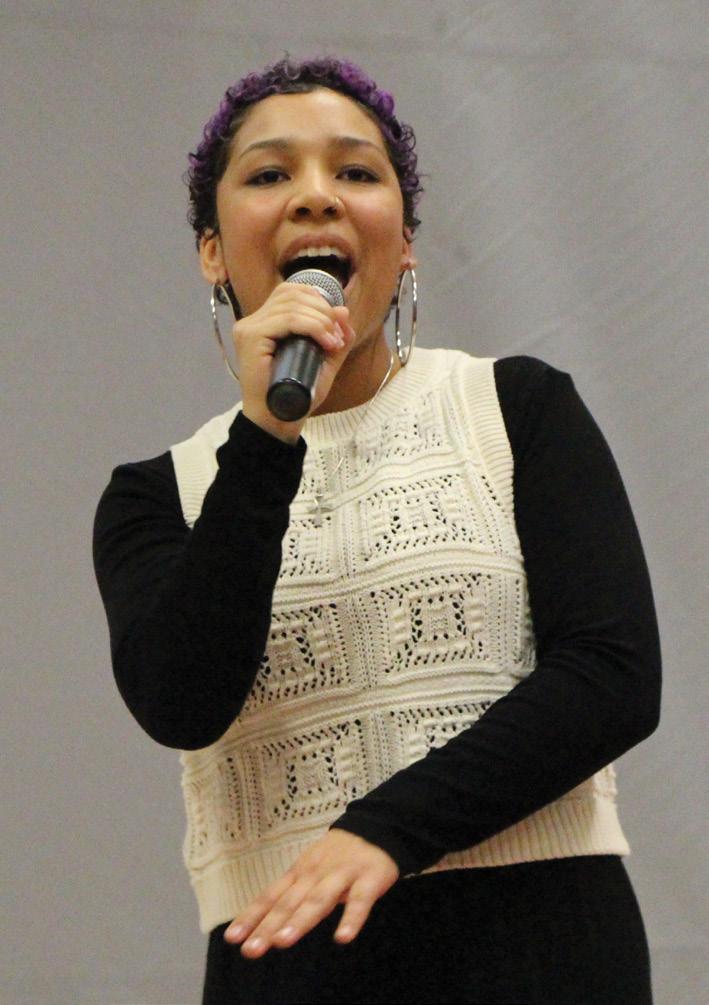
n A screening of the documentary Black Motherhood Through the Lens, produced and directed by Adeiyewunmi (Ade) Osinubi, followed by an open discussion.
n A poetry slam featuring professional artists and student poets.
14 Loomis Chaffee Magazine Spring 2023
ISLAND NEWS
As she reflects on her two days on the Island, she says, “I interacted with many students in many ways, and it was amazing for me coming full circle. … I was always proud of my identity when I was here, and then to come back years later in the context of this war and to once again show my heritage felt very moving to me. This campus embraced my ethnicity when I was a student here and embraced it again when I came all these years later.”
Music, Marika, and Ukraine are intertwined.
“Music has been a source of resilience for Ukrainians,” Marika says. “They have been known as great singers for centuries. Ever since there have been writings about the culture, it’s that the people are constantly singing in the field, singing in the churches, singing in their homes. So, it is in my DNA, and in Ukrainians’ DNA, to seek music as a source of revival. It also has been a way of preserving the culture, and a way of expressing emotions about things that are unspeakable.”
Marika also talked with students about the importance of the land to Ukrainians.
“Their connection to the land is not just about borders, not just about geography. It’s literally about the soil,” Marika says. “It has an incredibly fertile soil, and it’s a very lush environment, so there is a deep connection, and watching it get destroyed is
heartbreaking. … You see piles and piles of missile shells stacked up. Yet the people feel such a connection to the earth that it gives them strength.”
Ukraine has been known as the “bread basket of Europe,” one of the top grain exporters in the world.
Marika recalls talking to a cousin in Ukraine the spring of 2022 and asking him how he was doing. It is getting warmer, he said, and I am going to go out and plant some seeds.
“It is the feeling that the earth regenerates itself each year, and there also is a sense that there is a bigger world out there than even their own country,” Marika says.
For Marika, her time with the Loomis music students also brought back memories of when she was teaching choral groups full time at Berkeley.
“It was fun,” she says. “Working with the Loomis Chaffee students reminded me of how much I miss teaching. Those a-ha moments when suddenly a sound comes out of them that they didn’t expect, and it excites them. They recognize something special happened. I live for those moments.”
Leading up to her visit, Marika worked with faculty over Zoom and email to plan her time on campus.
“She brought so much extraordinary energy and deep thought to each aspect of our discussions that we kept adding classes and events,” says Performing Arts Department Head Susan Chrzanowski, also the choral/ vocal director. “She was exceptionally generous with her time and energy. Ultimately, over 200 students directly interacted with Dr. Kuzma.”
Marika’s two-day residency was a joint effort between the Dean of International Students Office and the Performing Arts Department, along with several other programs. Her visit was sponsored in part by the Joseph Stookins Guest Musicians Lecture Fund.

“Marika’s visit was timely, relevant, and highly inspiring,” Sue says. “Our choral repertoire and program are steeped in global relevancy. A major component of the course is an aim for meaningful vocal experiences.”
Students are scheduled to perform two Ukrainian choral works at the Spring Choral Concert on May 14.
Opposite page, top: Marika Kuzma ’77 meets with a group of seniors in the Global & Environmental Studies Certificate program. Bottom (left to right): Senior Inari Barrett sings “Golden” by Jill Scott. The Loomis Chaffee Orchestra plays “Lyric for Strings” by George Walker, the first Black composer to win the Pulitzer Prize in music. The step team, including junior Destiny Pond and freshman Aster ConwayReppert, performs for the school audience.
Throughout the month of January, an exhibit on the walls of the dining hall displayed photos and stories about activists whose efforts serve as a tribute to Dr. King as they further his vision of peaceful and collective action.
“As you engage with the installation, we encourage you to consider your connection to the work of social justice and how you can partner and collaborate with others — on and off campus — to do your part in creating a more equitable and just world,” Loomis Chaffee’s Center for Diversity, Equity & Inclusion (DEI) wrote in its introduction to the exhibit.
The exhibit and the MLK Week events were organized by the Center for DEI in collaboration with a number of other offices, departments, and student groups on campus.

loomischaffee.org 15 ISLAND NEWS

16 Loomis Chaffee Magazine Spring 2023 C
abaret
Shoes were piled on stage in the final scene of Cabaret, a lasting image depicting all that was left of those who would be murdered at Nazi death camps.

The curtain closed. The cast did not come back for a final bow in the musical that was performed over four days in February in the Norris Ely Orchard Theater to sold-out audiences.


Director David McCamish says the decision not to return to the stage was made early in the rehearsal process.
“We spent several days reading and in discussion about the script, its story, theme, characters, its history, and the points we wanted to deliver to the audience,” David says. “We discussed where the show could go and why we see bows at the end of shows, what are we bowing for, how would bowing fit into what we wanted to leave the audience with?
Opposite page: Sally (senior Jade Silverstein) sings at the Kit Kat Klub. Right, top to bottom: Lulu (senior Madison Oh), Rosie (junior Chloe Pendergrass), and Bobbi (sophomore Riley Ostroff) enjoy Berlin’s night life. The ensemble entertains revelers on New Year’s Eve 1929. Herr Schultz (junior Brigham Cooper) and Fraulein Schneider (junior Nana Achiaa Donkor) celebrate the treasure of a pineapple. The shoes of those sent to Nazi death camps fill the foreground as Emcee (sophomore Iris Sande) exits the stage.
“When suggested we not bow, the student actors and stage management unanimously agreed that bowing would not be appropriate for the story and for what we wanted the audience to think about. Our final image was powerful. To push it out of mind as the cast came out to accept its accolades seemed extremely out of place. I am very proud of how they handled the difficult material.”
David says Cabaret had been on his “short list” for a while.
“We felt it was a timely piece,” he says. “I do not think we can watch the show and not see echoes of our world today even though it is set in 1929 in Berlin, Germany, with the rise of fascism and when people are turning populism and extreme nationalism into vitriol and hate.”
Cabaret is set against the backdrop of the final days of the Weimar Republic in Germany as the Nazi Party is growing in strength. Increasingly, people are being brainwashed. Others will not let their minds consider what the Nazis might do.
Much of the story is set in the Kit Kat Club, where Sally Bowles, played by senior Jade Silverstein, is a headlining performer. Her love interest is aspiring U.S. novelist Clifford Bradshaw, played by senior Arthur

ISLAND NEWS
•
•
•
C
twenty cast members
fifteen orchestra members
five stage managers
ten tech crew members • eleven production members • four+ costume changes each
F. Beaugeard. Sally sings and dances with joy, but the viewer, knowing what is coming historically, can’t help but feel saddened by her decision to stay in Germany. Bradshaw does not stay as he becomes uneasy with what he sees.
The emcee at the Kit Kat Klub was played with energy, style, and a booming voice by sophomore Iris Sande. Another central element to the musical is the relationship between Herr Schultz (junior Brigham Cooper) and Fraulein Schneider (junior Nana Achiaa Donkor). Schultz is Jewish, and Schneider breaks off their engagement knowing the risk of marriage to a Jewish man would be too great under Nazi rule.
So much goes into a musical such as this. There were 20 cast members, 15 in the orchestra, five stage managers, 10 on the technical crew, 11 on the production team. Work on the production started before Thanksgiving break. Learning English, German, and French dialects was part of the process for some.

And the costumes. “Too many to count,” says Lisa Bebey, who has been the costume designer for Loomis Chaffee shows for nearly 30 years and loves every minute of it. Somehow, she keeps track of it all. The 20 actors had a minimum of four costume changes each.
“I am not making clothes,” Lisa adds, “I am making characters. … My clothes need to tell the story.”
A story — and an ending — that would stay in people’s minds well after leaving the performance.
“It took commitment, time, talent, hard work, and energy to pull off a production like Cabaret,” David says.


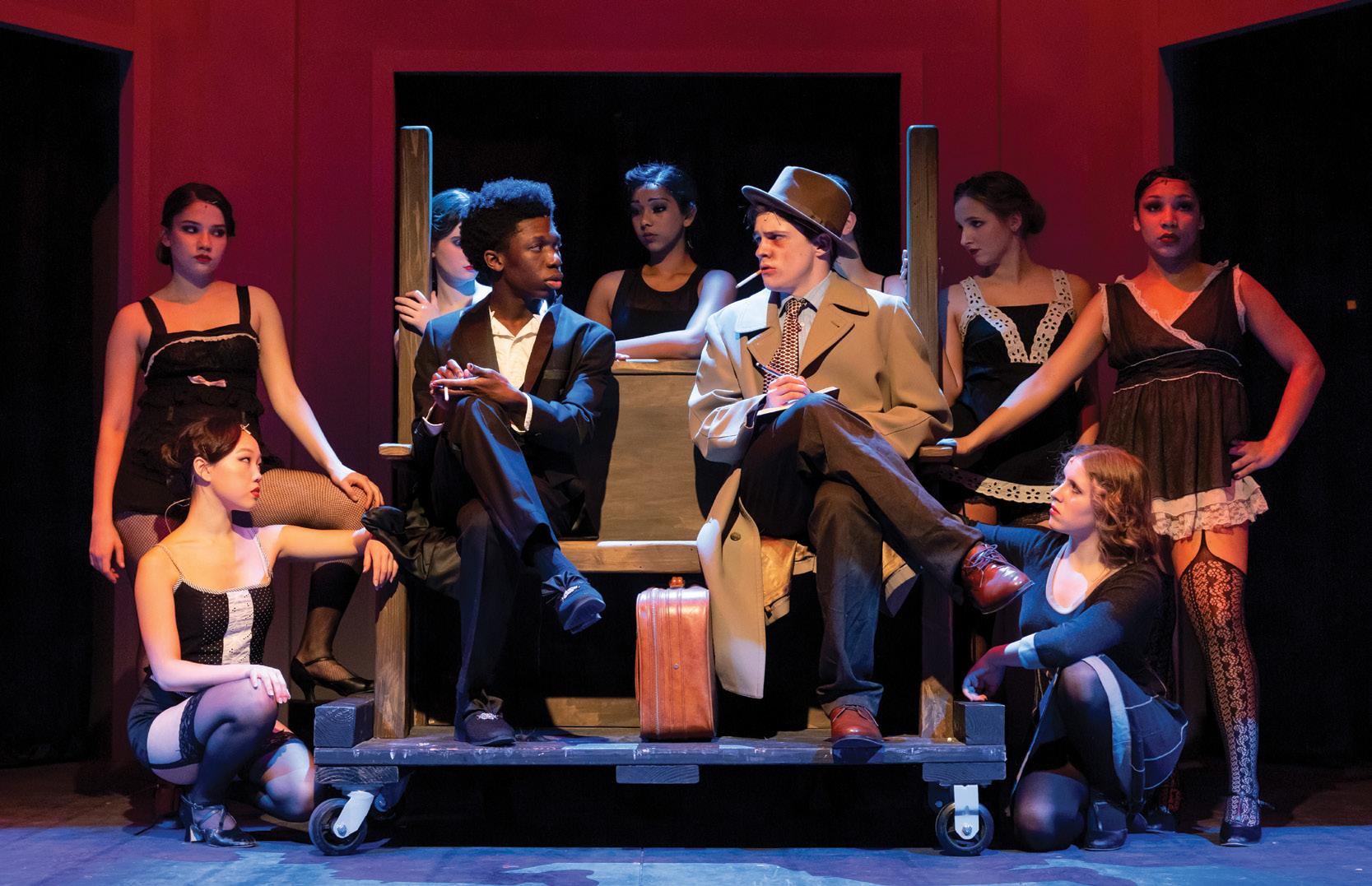
Top: Emcee and Clifford Bradshaw (senior Arthur Beaugeard) eye each other on the train. Middle left: A phonograph plays the recording of a child (faculty child Emma Hadari) singing “Tomorrow Belongs to Me,” a seemingly innocent German folk song whose reprise by the larger cast takes on ominous Nazi tones later in Act I. Middle right: The pit orchestra, including keyboardist senior Calvin Pan and violinist junior Angela Adu-Boateng, accompany the performance, projected onto a screen behind them. Bottom: The culmination of “Willkommen” (Welcome to Berlin), the musical’s opening number.
Events/Theater-Dance/Cabaret-2023
18 Loomis Chaffee Magazine Spring 2023
A gallery of photos from the production is available on SmugMug at https://www.smugmug.com/app/organize/
Money, Ethics, and the Environment
The way Ned Salter ’95 sees it, taking ethical and environmental considerations into account when investing in a company makes good financial sense.
“Sustainable investing is just investing,” said Ned, global head of investment research for Fidelity, during a video conference with the Loomis Chaffee Environmental, Social and Governance (ESG) Investment Club in February. “Anyone who invests in something, do you actually look to invest in crappy businesses or with people you don’t trust? No, you don’t. So sustainable investing is about developing an additional tool kit to make better capital deployment decisions.”
Ned, who helped Fidelity develop its own ESG rating system for investors, was invited by the club as a guest speaker. The students gathered in Gilchrist Auditorium, where Ned joined them via Zoom from England to discuss ESG investing as well as his career path.
“If you are going to be a good investor, you need to think about the non-financial risks before you make the investment, not after,” he said. “Not just because it is good for the world, but because it also is good for your clients’ money.”
Or your own money as a private investor.
Ned stressed the importance of examining a company’s supply chain. A sustainable supply chain integrates ethical and environmentally responsible practices into a successful model.
“You need to be sure you are investing soundly,” Ned said. “The revenue-generating capabilities of that company that has a sustainable supply chain will be greater than companies that pollute the environment or have some element of unfairness in their supply chain.”
Ned did not take the most conventional path from high school to his eventual role at Fidelity. After graduating from Loomis, he attended the liberal arts school Kenyon College instead of going straight to a business school.
When Ned graduated from Kenyon in 1999, the internet was starting to take off. He tried to take off with it; he and some friends started an online marketing company.
“For a short period of time, it was extremely successful,” Ned told the students. The company’s bankers told him that his share of the company was going to be worth $100 million. Six weeks later the bank would not return the company’s calls, he said. “Two weeks after that the company went bust. That is how quickly the market turned,” he said.
His entrepreneurial days were over, and that forced Ned to figure out his next steps in life. He sought a job at Putnam Investments in Boston. Ned did not have the business school pedigree that Putnam sought, but he did have persistence. After eight handwritten notes to the chief executive officer, he went through the interview process and received an offer.
He soon made his way to graduate school at Harvard, where he earned a master’s in business administration, and he eventually left Putnam for Fidelity to manage people.
He is responsible for bringing together and managing the investment research teams across Fidelity. He also helped Fidelity develop its ESG ratings system, which helps investors better understand the substance of companies’ sustainable characteristics.
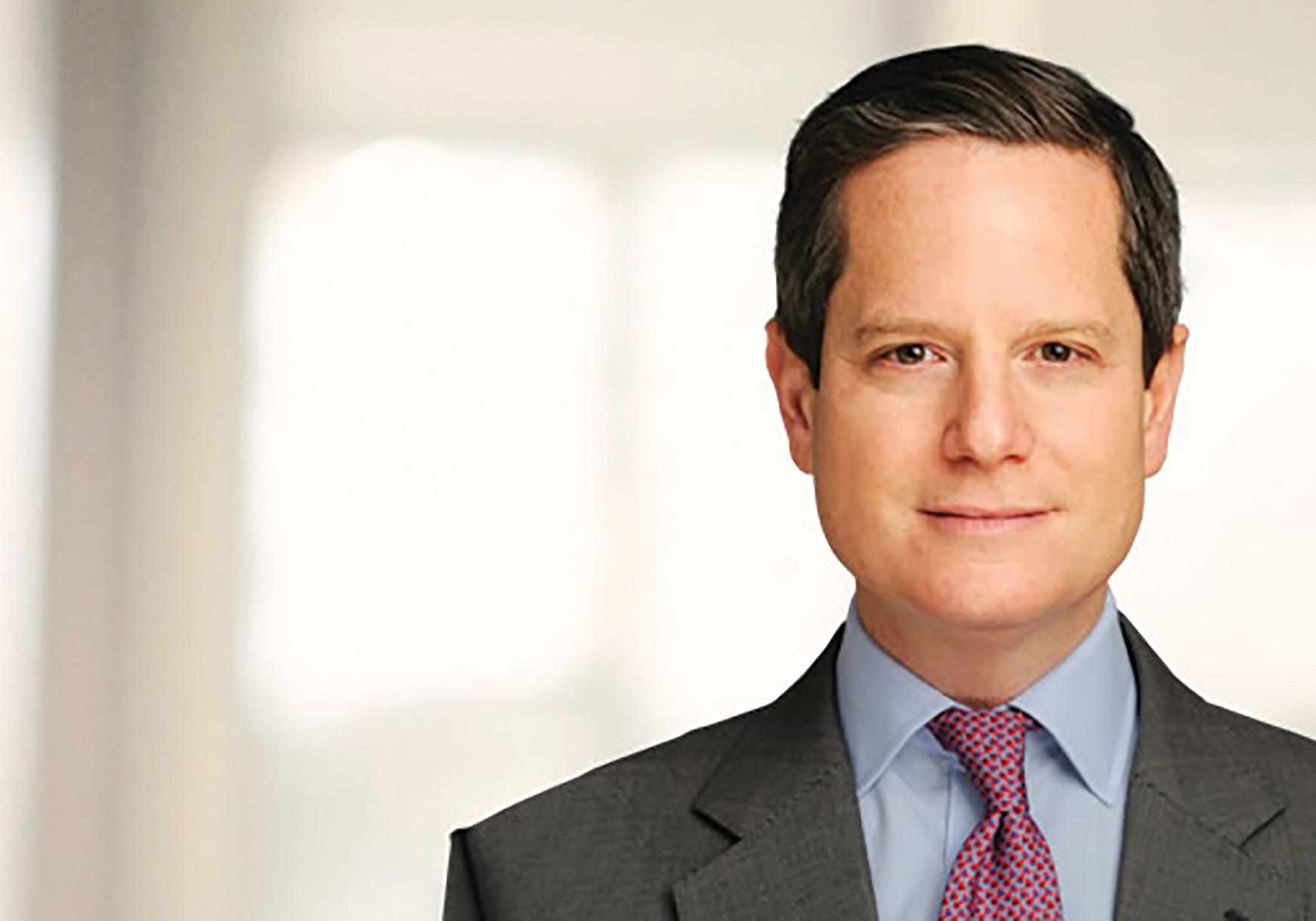
Times change, so part of Ned’s challenge is to keep up with it all. Among the changes is an emphasis on stakeholders, not just shareholders, in a company.
“We have come through a period of 40-plus years of what I would call shareholder capitalism, which is that of all the stakeholders in a particular entity, shareholder primacy was at the top of the list,” he said. “Shareholders got whatever they wanted. It was all about eking out that final element of return, of money. To a certain extent the era of shareholder primacy is over. It doesn’t mean that we have to accept lower rates of return, but I think we need to think about other stakeholders. … It’s employees, the communities in which you operate, retirees, the general public, bond holders … I think this era of stakeholder capitalism is here to stay, but I don’t think it’s at the expense of financial returns.”
loomischaffee.org 19
ISLAND NEWS
“If you are going to be a good investor, you need to think about the non-financial risks before you make the investment, not after. Not just because it is good for the world, but because it also is good for your clients’ money.”
— NED SALTER ’95
Slam Poet Workshops with English Classes
Andre Bradford, a two-time Austin Poetry Slam champion, digs deep inside himself for his poetry. Nothing seems off limits.
Mr. Bradford, whose stage name is “S.C. Says” (more on that later), visited Loomis Chaffee in December, working with English classes during the day and presenting before the wider Loomis community in the evening in Hubbard Performance Hall.
In the class workshops, his energy became the students’ energy. He opened by reading a poem called “A Box To Call Home” that revealed a bit about himself. It read, in part:
Hear him roar they did, the poem’s words spilling out with emotion and emphasis. He worked with each class for about 75 minutes. What can be done in 75 minutes? A lot more than one might expect.
The students were given a few prompts and time to write. One prompt was about facing a fear, writing a “Dear fear of …” letter. The
students opened up, digging deep for a fear just like the poetry slam champ in front of them had shared. Then they read what they had written out loud.
“Dear fear of not being perfect,” wrote one student. “Can you please let me live in peace? For 17 years I have been the cat trying to catch the laser light. You hold the little red light in front of me and snatch it away the second I am close to it. It’s exhausting. I bet it’s amusing to watch me become frustrated when I make a mistake at practice or get a bad grade on an assignment. ...”
As each student ended the reading of their work, Mr. Bradford offered praise for what that work meant to him, how it resonated with him.
“It’s important the students know I am listening, and others are, too,” he said.
As he left the second student workshop class, the Loomis students had obviously left a mark on him. “It took me six months to get on a stage, and you did it in less than an hour,” he told them.
“It’s literally you on a stage with your voice and your words trying to tell the most compelling story you can. That can be challenging. How do you get someone to resonate with your story in three minutes?”
— S.C. SAYS
Slam poetry is its own art form, Mr. Bradford explained. Pieces must be less than three minutes in length. They must be original. No music can accompany them. You can’t use a costume to help tell a story.
“It’s literally you on a stage with your voice and your words trying to tell the most compelling story you can,” he said. “That can be challenging. How do you get someone to resonate with your story in three minutes?”
His stage name has its own story. “The first place I ever heard a slam poem was at the University of Southern California: S.C.,” he said. “I thought it was a cool way to tell a story. I was studying acting at the time, so it was like that’s really cool, but not something I’m going to do.
“Then I moved to Austin and a friend invited me to a slam, and for six months I just enjoyed people being vulnerable and raw, and it was very healing and cathartic for me. Eventually I wanted to tell some of my own story, and at the time it seemed like everyone had a stage name. … I remembered the first time I heard a slam poem, and that it had started my journey. So that’s how ‘S.C.’ came to be, and I’m a sucker for alliteration, so I added the ‘Says.’”
Before long, the three-time Texas Grand Slam finalist was on his way to winning awards and traveling the country. He has performed at schools, universities, and elsewhere in 27 states. S.C. Says, and people feel the words.

20 Loomis Chaffee Magazine Spring 2023
ISLAND NEWS
Top: Poet Andre Bradford works with students in Founders Hall.
a
you
“I am the blend of two cultures rich In both history and injustice In both spice and spiciness In tradition and tribulation A Jamaican Mexican American I am Jamexican Hear me roar In
language
can only understand If you’ve ever looked in a mirror And wanted to alter your reflection. Adjust the tint The brightness Color correct the melanin
To something a little less authentic Palatable to the masses.
A one size fits all checklist for heritage …”
Faculty and Staff News
Director of Human Resources Kim Barberi and Spanish teacher and Associate Director of Diversity, Equity & Inclusion Lilian Castillo de Hutchinson received Phenomenal Women of Windsor awards this winter from the Windsor Human Relations Commission. The awards recognize and celebrate Windsor women who encourage
inclusion and diversity in the community.
Varsity girls basketball head coach Adrian Stewart was named 2022–23 Coach of the Year for Class A girls basketball by the New England Prep School Athletic Association. The award was announced in early March at the conclusion of the Class A tournament,
which Adrian’s team won for the second year in a row.
Social Science teacher Molly Giorgio ’06 and history teacher and Dean of Students Elliott Dial welcomed son Junah Anthony Dial on January 12.
CAPSTONE PROJECTS
THAT’S ABSOLUTELY BRILLIANT! DEBATE TOURNAMENT
Seniors working toward Global & Environmental Studies Certificates are engaged in an array of capstone projects this year, from measuring the carbon footprint of the school community to enhancing the turtle aquarium in the Clark Center for Science & Mathematics. Thirty-seven seniors, some solo and some in groups, are involved in the projects, and each project group works with a faculty advisor to help refine the scope and objectives of the project and develop the project vision. The certificate program recognizes coursework, co-curricular engagement, and experiential learning focused on fulfilling the mission of the Alvord Center for Global & Environmental Studies to develop “global and environmentally engaged citizens through programming that enhances understanding and teaches action-oriented skills.” The seniors who successfully complete their capstone projects and all the other certificate requirements will receive their certificates at a “take action” celebration in May.
SCHOLASTIC WRITING AWARDS
Loomis Chaffee students earned more than 40 awards across a variety of categories, from poetry to flash fiction to critical essays in this year’s Connecticut Scholastic Art & Writing Awards, presented by the Alliance for Young Artists & Writers. The works of five students that won Gold Key awards advanced to the national competition in March. They are sophomore Cara Dai in the Personal Essay & Memoir category, junior Fanou Zhang and senior Xiyuan Lin in the Critical Essay category, and seniors Serena Kim and Eric Sun in Poetry.
Debate teams from 14 schools descended on the campus on a Sunday in January for the annual Loomis Chaffee Debate Tournament, the first time in three years that Loomis held a debate event in person. Competitors debated both sides of a policy resolution released that morning along with a packet of articles offering perspectives from both sides of the issue. The resolution was a timely one: “AI [artificial intelligence]-generated writing like ChatGPT and other dialogue-based AI chatbots should be banned in schools.”
The Pelicans took third place in the novice two-person team category and second and third place in the novice four-person team category. The Loomis event was one of approximately 20 tournaments in which members of the school’s 55-strong debate team participated during the winter term.
ROBOTICS
The HAX Robotics team earned the Think Award at a competition in Southington, Connecticut, in February. The Think Award is given to the team that best reflects the journey the team took as they experienced the engineering design process during the build season. The team also placed third at the event in competition for the Inspire Award, presented to the team that best embodies the “challenge” of the FIRST Tech Challenge Program. Teams that place in this category share team members’ experiences, enthusiasm, and knowledge with other teams and have shown success in designing and building robots.
BLACK JOY
This year’s Black History Month celebrations at Loomis Chaffee centered on a common theme — Black joy. “A lot of what we have been hearing in the media around Black individuals or leaders is around trauma,” explains Ashley Augustin, chief diversity officer and director of the Loomis Chaffee Center for Diversity, Equity & Inclusion (DEI). “We want to change the narrative and center more on joy, and that Black joy exists.” Among the many events celebrating Black History Month in February was a trip to the Wadsworth Atheneum in Hartford to hear author and educator Jelani Cobb speak about the complex dynamics of race and racism in America; a “Bring Back the ’90s” dance; presentations and events in each residence hall; a screening of the movie Moonlight, which explores the intersection of race and sexuality; a monthlong game, informational series, and posters on campus about historical Black figures who are often overlooked, Black innovators and pioneers in medicine, and Black history at Loomis Chaffee; the LC Black Joy Project, which invited student submissions of photos of Black joy for display on campus; and a design challenge for teachers, sponsored by the Kravis Center for Excellence in Teaching, to create academic assessments and activities that celebrate the lives and contributions of Black Americans. An LC Black Excellence Reception that was planned for the end of the month at the home of Head of School Sheila Culbert was postponed because of snowy weather until after Spring Break.
ISLAND NEWS
loomischaffee.org 21
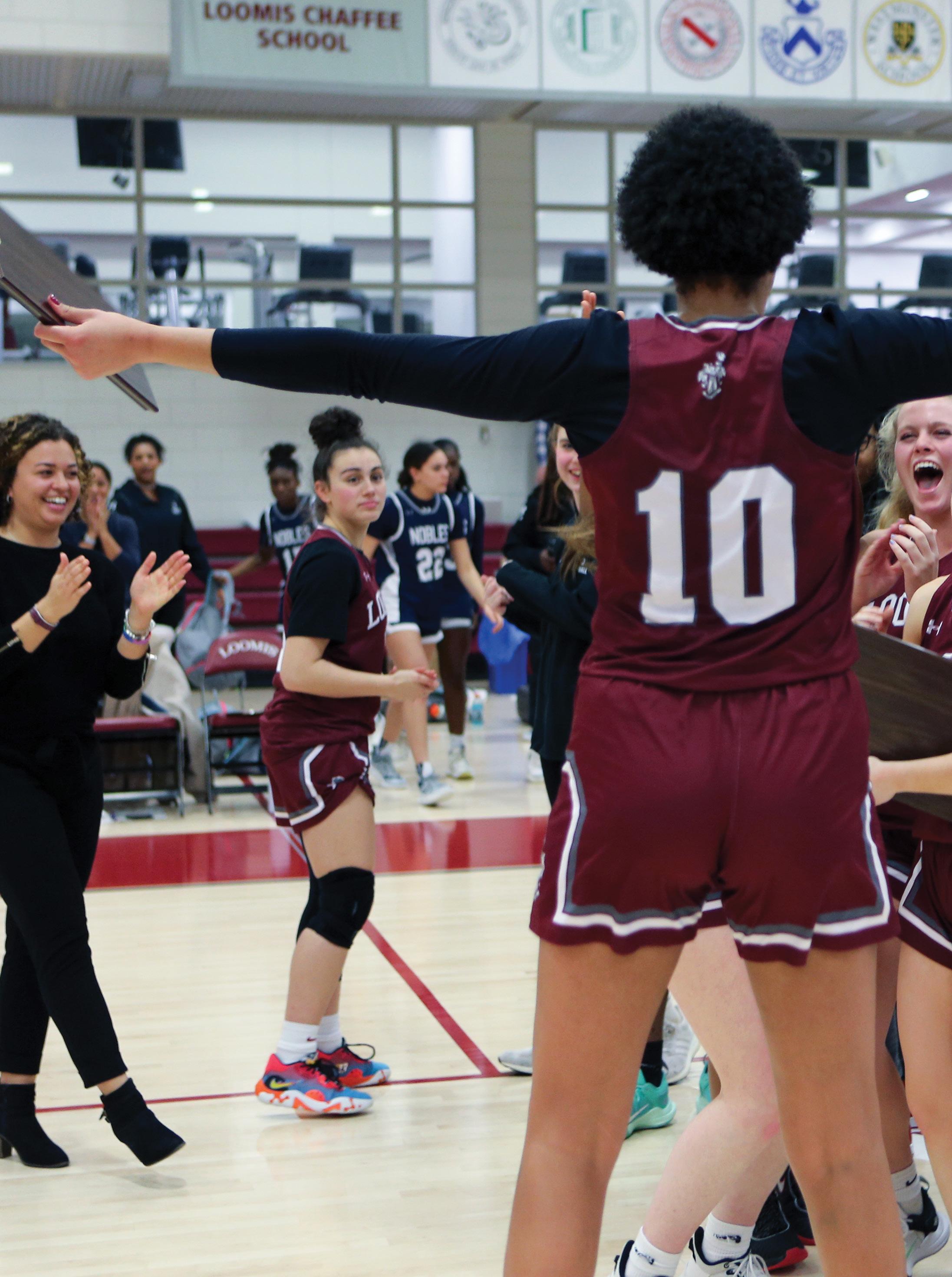
NEW ENGLAND CHAMPS
Back-to-Back!
For the second year in a row, and this time on the home court, the Loomis Chaffee girls basketball team won the New England Prep School Athletic Conference (NEPSAC) Class A title on March 5, coming from behind to defeat Hotchkiss in the championship game. The Pelicans overcame an 18-point deficit in the first quarter to win 64-60 in the final. They reached the title game with a 71-49 quarterfinal win over Taft and a 67-43 semifinal victory over Kent. Senior Carys Baker was the tournament Most Valuable Player, and head coach Adrian Stewart ’90 was named the NEPSAC Class A Coach of the Year.

loomischaffee.org 23
Left: Senior Carys Baker (No. 10) and her teammates celebrate their Class A New England championship in the Olcott Center. Shown are assistant coach Chloe Alexander ’12, sophomore Izzy Cruz, Carys, sophomore Jaime Patton-Martin, junior Jess Roy, manager junior Maddie Peter, sophomore Abby Congdon, freshman Skye Hunter, and sophomore Liv Westfort.
VARSITY RECORDS
BOYS BASKETBALL 14-11

GIRLS BASKETBALL 20-8
Founders League Champion
New England Class A Tournament Champion
CO-ED EQUESTRIAN

1st Place in 3 Shows
IEA Regional Finals Champion
BOYS ICE HOCKEY 13-9-4
Founders League Champion New England Martin/ Earl Tournament Quarterfinalist
GIRLS ICE HOCKEY 14-7-4
New England Chuck Vernon
Elite Eight Tournament Quarterfinalist
CO-ED SKIING
New England Class B, 10th in Girls Slalom and Giant Slalom, 11th in Boys Giant Slalom
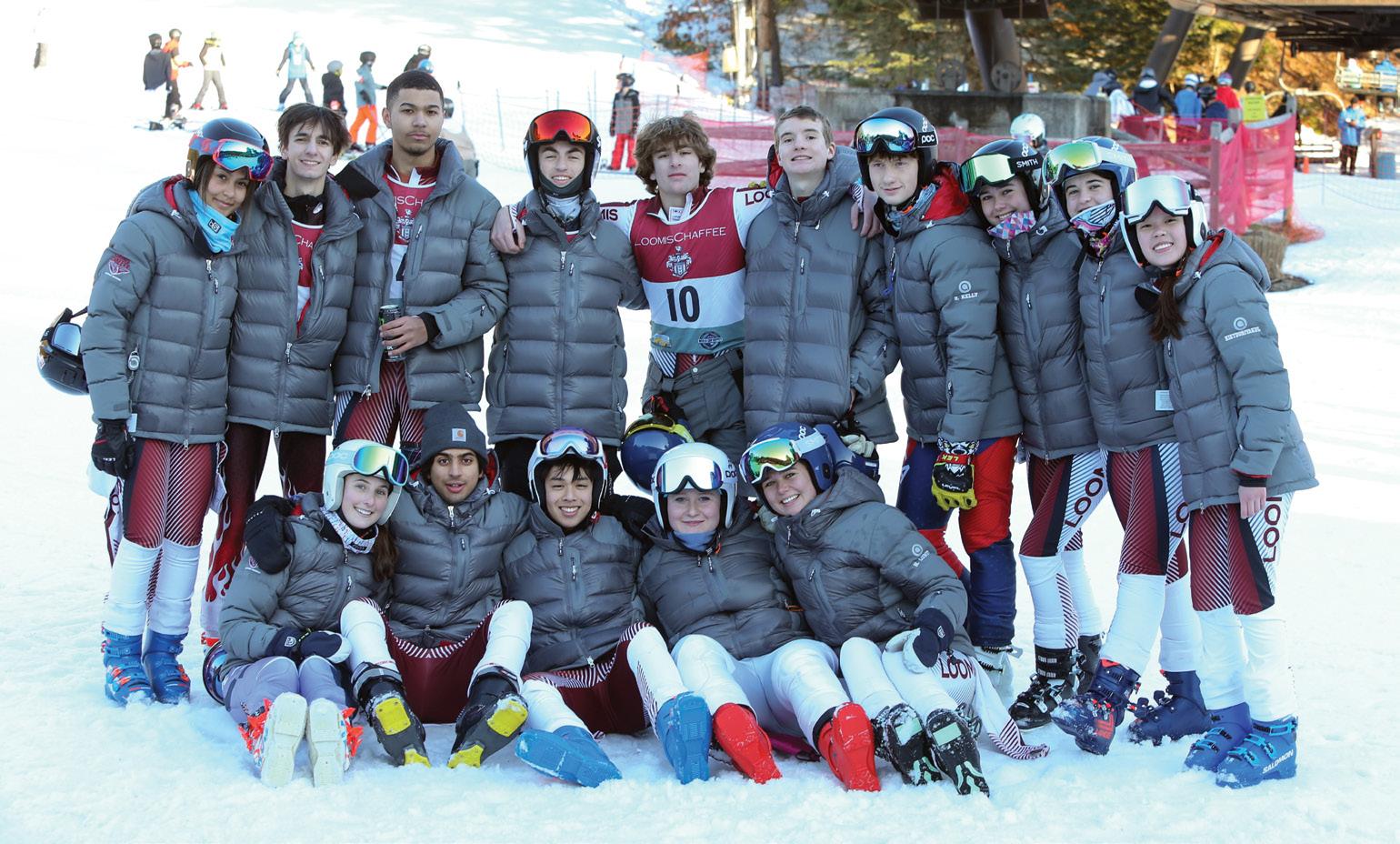
BOYS SQUASH 7-9
New England Class C Tournament, 2nd place
GIRLS SQUASH 9-7
New England Class B Tournament, tied for 4th place
BOYS SWIMMING & DIVING 5-4

Founders League Meet, 2nd place
GIRLS SWIMMING & DIVING 6-3
Founders League Meet Champion
24 Loomis Chaffee Magazine Spring 2023
1: The ski team
2: Senior Justas Bardauskas
3: Junior Elena Higgins
4: Sophomore Michaela Howe
5: Senior Maggie Johnson
6: Senior Angelina Amastal
7: Senior Carys Baker
8: Senior Everardo Lujan Lalieu
9: Senior Brandon Kim
1 4 2
10: Boys hockey players and fans
3

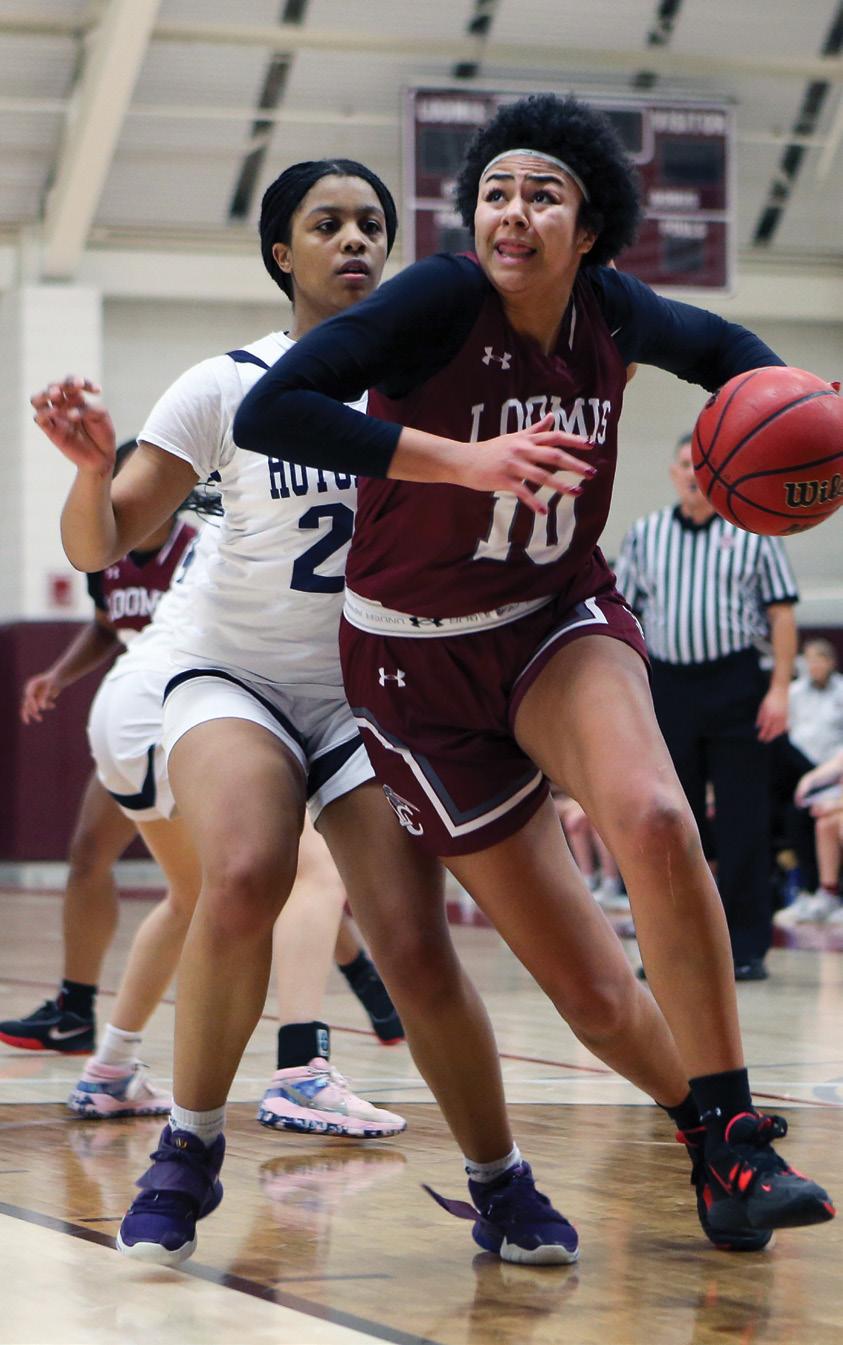




loomischaffee.org 25 7 6 5 8 9 10

Complete Game
Aaron Civale ’13 seeks to make his mark as top-shelf pitcher and first-class person
by Jeff Otterbein
We see the Major League Baseball players on our TV screens night after night, and we think we know who they are. But we do not. We know them by their statistics, and we often judge them that way, but they cannot simply be defined by the speed of their fastball or the quickness of their swing.
Aaron Civale ’13 is a major league pitcher for the Cleveland Guardians. Do not doubt for a moment that he enjoys the view from the pitching mound. Like so many before him and so many to come, this was his dream as a kid. Yet his vision for himself is to be more than just a major league pitcher.
He recalls his first spring training when Cleveland personnel asked him questions to get to know him. One he will never forget: When all is said and done, what do you want everyone to remember Aaron Civale by?
“I remember the answer I gave was that I do not want to be remembered as just a pitcher,” Aaron says on a winter day in

January from his home in Massachusetts, just weeks before he would leave for spring training in Arizona. “There are so many pitchers who have gone through this game. It is difficult to get to this position, but my goal is not to be just another right-handed pitcher to play in the big leagues. If I am not using the opportunity I have to do something for the greater good, then I am wasting the opportunity I worked so hard to get.”
“Above everything,” says his mother, Helen, “that makes me the proudest.”
Aaron was the Guardians’ nominee for the 2021 Roberto Clement Award, presented annually to one Major League Baseball player who “best represents the game through extraordinary character, community involvement, philanthropy and positive contributions on and off the field.”
Aaron was 26 years old and in just his third season. In his rookie season, 2019, Guardians pitcher Carlos Carrasco not only was the team’s nominee, but won the award. Aaron became close to Carrasco and says they

loomischaffee.org 27
Left: Francesca Civale’s artwork of her husband, Cleveland pitcher Aaron Civale. Don’t expect to see Aaron turn his back on who he is: a hard worker with passion for the game and compassion for people. Above: An Aaron Civale baseball card
simply bonded. The list of what Carrasco and his wife did was as long as it was meaningful. Carrasco was traded before the 2021 season. So Civale stepped up his game.
“I want to continue in the footsteps of those who came before me,” he says.
And right alongside him is a teammate, his wife Francesca, whom he met when both were students at Northeastern University in Boston. Their dog’s nickname is Stetty, short for Stetson West, a dorm on the Northeastern campus. When Aaron left for spring training in February, Stetty stared at the door for hours.
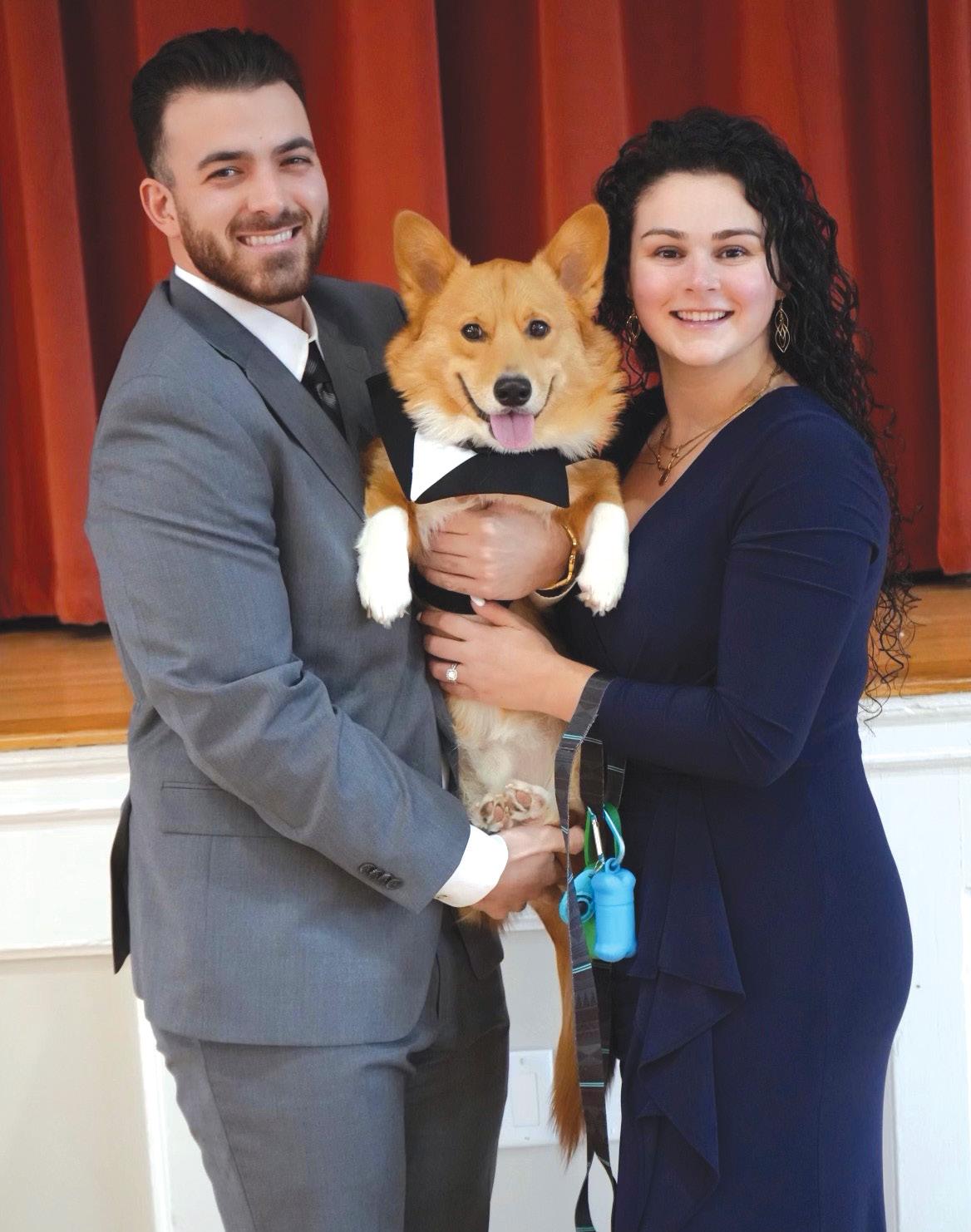
Aaron and Francesca have been involved in their Pearls for Perseverance player program the past few seasons.
“We always thought, what’s the purpose of having this platform and all the things that come with it if we don’t do something good for others with it?” Francesca says.
“I have always said Aaron is a great baseball player, but he’s an even better man. Watching others get to know him better as a person through our charity work and having them see all he has to offer outside of the baseball field has been so special for both of us.”
Aaron also has attended the Great Lakes Science Center’s STEM camp for youth in the Cleveland area. He has supported a few Guardians youth baseball/softball initiatives and participated in hospital visits at the Cleveland Clinic — both virtually and in-person. He had a personalized glove for sale through Wilson’s Glove of the Month program with $20 from each glove purchased going to LifeAct, whose mission is to provide mental health education guided by the goal of preventing suicide. The organization says it delivers in-school educational programs to more than 25,000 Ohio youths every year.
“The giving back that he has been doing in the Cleveland area does not surprise me at all,” says Jeff Ross, Aaron’s former baseball coach at Loomis Chaffee, who retired in 2016. “The whole Civale family is really a credit to the school. The fact that we had Aaron’s brother Nic for four years and that his parents were part of our community the entire time Nic and Aaron were at Loomis, they could not be nicer people, better parents,

people you wanted to know and whose kids you wanted to root for.”
Raising awareness of mental health issues is important to Aaron and Francesca. Both have known people who took their own lives at a young age.
“Up until the age of 18 is such a precious age,” Aaron says, “and there is so much going on around you and so much development happening. You’re supposed to pick what you want to do the rest of your life, pick the college you want to spend four years at. … It is tough figuring out things at that age. If there is any way to take that pressure off, it’s important for us as a society to learn how to handle that.”
You are not alone, is one message, says Aaron. “And we need to do our best to check in with those around us and just be kind to those around us. Try to go that one extra step as frequently as you can. It’s important.”
In the Pearls for Perseverance program, Aaron sets aside his warm-up baseball, which is signed and dated and given to pediatric patients at Cleveland Clinic Children’s. The child also receives a message of hope and encouragement. A pearl is a baseball term for a new ball that has been rubbed down and essentially is no longer bright white but pearl white. Perseverance is simply the message Aaron and Fran seek to convey.
“To be able to bring joy to someone else’s day can be so impactful and at times might not even be that much effort on one side and can mean so much to the other side,” Aaron says. “Everyone goes through things, and when someone goes out of the way to reach out and make you feel you’re being thought about, that is something that carries a lot of weight.”
So, too, did his time at Loomis.
“Mine was a friend who was becoming a better friend, and I’ll leave my wife’s privacy to her,” Aaron says. “Sometimes you really don’t know what someone is going through, and maybe it’s one little thing you can do. Maybe it is just letting someone know that someone else is thinking about them. Maybe that can be a difference-maker.”
There is a growing mental health crisis in the United States as youth have had to process so much between COVID-19 and wars, senseless murders and hate crimes.
“I didn’t know where baseball was going to take me,” Aaron says. “I grew up in a small town, East Windsor, grew up with family as a priority. And like most high schoolers, not too aware of what is going on outside where you are from.”
Loomis helped change that. Aaron speaks of having friends from all over the country and world.
“It was a unique opportunity to experience that diversity at a younger age than I would have, and that certainly helped prepare me for college and beyond,” Aaron says. “The group of people I interact with every year, there are constants, but it also is constantly changing.”
28 Loomis Chaffee Magazine Winter 2023 Spring 2023
Trades, free agency, players being called up to the Guardians or sent down to the minor leagues means you never quite know who will be in that locker room each day. “Learning how to communicate and work with many diverse types and groups of people, I don’t think I would have had that if I had not gone to Loomis,” Aaron says.
A teacher with whom Helen worked years ago had sent her children to Loomis and helped sell Helen and Aaron’s father, Kim, on the idea. Not that they needed much convincing. They were very familiar with the campus. Kim and Helen owned a Domino’s Pizza on Poquonock Avenue in Windsor from 1985 to 1994.
“I was pregnant with Nic delivering pizzas here,” Helen recalls. “So we knew Loomis before we had children.”
Kim remembers delivering about 120 pizzas to campus on a Super Bowl Sunday. He also
remembers thinking, “I wish our kids could come here some day.”
Once Nic went, there was no stopping Aaron.
“I think in Aaron’s application we wrote that Aaron has been bleeding maroon and gray since Nic walked through the doors,” Helen says. “Aaron really wanted to be here.”
Just like he really wanted to be a major league pitcher.
“I knew from when he was 10 or 11, the idea got in his mind,” Kim says, “and he was always determined no matter what. If you tell him no and he wants to do it, he will find a way.”
Aaron’s baseball career already has memories that will last long after he throws his last pitch. A no-hitter in 2013 at Loomis Chaffee, the first in 36 years, against rival KingswoodOxford. A start for Northeastern University in a 2015 spring training game versus the


Boston Red Sox in which he pitched two no-hit innings, striking out David Ortiz, Hanley Ramirez, Mike Napoli, and Xander Bogaerts.
“As a coach to have someone with Aaron’s focus and work ethic and leadership by example, you feel really blessed to have that as part of your team’s culture,” Jeff says. “It was very obvious, too, that included in all of that was that he was just a very nice guy. We had a lot of success in Aaron’s junior and senior years because so many of the boys on the team were good friends and felt being on the team was a valuable thing personally. No doubt Aaron was a big contributor to that, if not the biggest.”
Aaron was drafted in 2016 in the third round and received a $625,000 signing bonus. He told his brother to go buy a car. Nic was in grad school, driving one of his parents’ old cars. Aaron didn’t get a car for himself at that time. He was driving his grandfather Frank Civale’s car that had been given to him by his grandmother Lois Civale.
“He drove a 1997 Buick Regal until two years ago,” Kim says. “The other guys on the team were always busting him about driving that Buick.”
loomischaffee.org 29
Opposite page (Top left): Aaron signs a jersey for a lucky fan. (Bottom left): A photogenic trio, Aaron and Francesca pose with their dog Stetty, short for Stetson West, a dorm on the campus of Northeastern University in Boston, where the couple met. This Page (Top left): The 2013 Loomis Chaffee varsity baseball team. Aaron is in the middle row, fourth from left. (Top right): Aaron threw a no-hitter at Loomis in 2013, his senior season.
AARON CIVALE
Baseball Resume and Bio Baseball Resume and Bio
Born: June 12, 1995, in East Windsor, Connecticut
High School: Loomis Chaffee College: Northeastern University, Boston
Major League career record through 2022 season: 24-21, 4.08 ERA
Contract status: Signed through 2023, 1 year/$2.6 million
Highlights
2013
Throws a no-hitter as a senior vs. Kingswood-Oxford, the first for the Pelicans in 36 years.
2014
Gets first career save by recording a career-best three strikeouts in two no-hit innings at Villanova.
2015
Gets starting nod for Northeastern University in an annual spring training game versus the Boston Red Sox. Pitches two no-hit innings, striking out David Ortiz, Hanley Ramirez, Mike Napoli, and Xander Bogaerts. (See top right.)
Finishes 7-2 with a 3.24 ERA and six saves, named to All-CAA Third Team and CAA All-Academic Team.
2016
Finishes 9-3 with a 1.73 ERA and is selected in the MLB Draft by Cleveland in the third round (92nd overall pick).
2017
13-6 with a 3.28 ERA in first season in minor leagues.
2018
5-7 with a 3.89 ERA at Double A Akron.
2019
7-1, 2.35 ERA at Double A Akron and Triple A Columbus before being called up to Cleveland. In his first major league start
he strikes out the side in the first inning. He retires the first eight batters, striking out six, and allowing only two infield singles in six scoreless innings, getting the win as Cleveland beat the Tigers 2-0.
Records the lowest ERA (1.82) for any pitcher in his first nine starts with Cleveland and is the first MLB pitcher to work at least five innings and allow two or fewer runs in each of his first nine appearances.
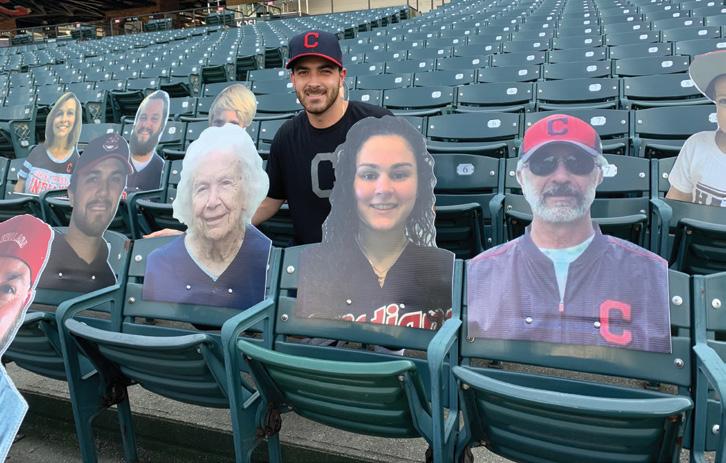
Finishes 3-4 with a 2.34 ERA.

30 Loomis Chaffee Magazine Spring 2023
2020
His 11 starts working at least six innings ties for first in MLB.
Finishes 4-6 with a 4.74 ERA in COVID-shortened season.
2021
Aaron is Cleveland’s nominee for the Roberto Clemente Award, given annually to the one Major League Baseball player in part for his work in the community.


2021
Starts season 10-2 with a 3.32 ERA in his first 15 starts and likely headed to the All-Star Game, but a sprained middle finger on his pitching hand causes him to miss more than two months. Led all major league pitchers in wins at the time of his injury. Finishes 12-5 with a 3.84 ERA.
2022
Injury-filled season in which he finishes 5-6 with a 4.92 ERA.
“We get to park in the players’ lot when we go to games,” Helen says.
Kim laughs: “And there are Ferraris and Mercedes and all those types of cars there, and Aaron with his Buick Regal.”
“He took great care of that car,” Helen says.
In his first major league start in 2019, Aaron struck out the side in the first inning. He retired the first eight batters and allowed only two infield singles in six scoreless innings, getting the win as Cleveland beat the Tigers 2-0. His parents and Nic, who flew in from Hawaii where he was working, were at the game. Francesca was there. An aunt and uncle flew in from Oklahoma. His godmother came. So, too, did the host family he lived with during his first year in professional baseball in Ohio.

xHis parents drove 573 miles from East Windsor to Cleveland.
“It was awesome; the whole experience was incredible,” Helen says.
Kim adds, laughing, “Then we found out later they would have flown us out there and paid for our hotel and everything. We didn’t know that.”
They also were among the many family and friends on the field after the Guardians clinched the American League Central Division title last September.


“It’s something you never expect to happen,” Helen says.
They met front office personnel and were told that Aaron was a gift to the team. “It was so great to hear that,” Kim says.
Through hundreds of games and thousands of miles, Aaron has taken his parents on quite a ride over the years. Now all eyes are on certain days.
“You get on that five-day rollercoaster,” Kim says of Aaron’s turn in the rotation. “Then you watch the game, decompress, and get ready again.”
Far left: Aaron and some cardboard cutouts of family members, a reminder of the 2020 COVID-19 shortened baseball season played without fans. Left: Aaron was Cleveland’s 2021 Roberto Clemente Award nominee. Above: Down went Ortiz, Ramirez, Napoli, and Bogaerts in a spring training game in 2015 and up went Civale’s stock as a major league prospect at Northeastern University.
loomischaffee.org 31 CIVALE
Ortiz Napoli
Ramirez Bogaerts
Or, as Francesca says, “Even after nine years of watching him, I still get nervous.”
Aaron and Francesca remain like-minded when it comes to the game.
“Aaron and I both try to take a ‘control what we can control’ approach,” Francesca says. “So I try my best to help him any way I can while understanding baseball has highs and lows, and in time, everything passes.”


Helen and Kim attend as many games as they can, but they also have the MLB TV package. So, too, does Lois, now 95 and quite possibly Aaron’s biggest fan. The MLB TV subscription is a birthday gift each year from Aaron and Nic. Family has always been important to the Civales. Helen has brothers and three sisters. Aaron and Nic have 21 cousins.
“On Sundays we went to Kim’s parents for lunch no matter what, and then we went to my mother’s after that,” says Helen, who is in her 25th year working in the East Windsor school system. “And the four of us. We were always together. Family had to come first.”
Aaron enters his fifth season with the Guardians with a 24-21 career record with close to a strikeout per inning. In the offseason he signed a one-year deal worth $2.6 million to avoid arbitration.


He has had a lot of injuries the past two seasons, so his offseason regimen was about being prepared for what is to come, a long season stretched over months with media scrutiny and intense fans being part of the deal.

“It’s finding the right balance and trusting
If we take care of business within our own team, we will be in a good spot. That is important to learn. You take care of business for yourself and for those around you, and everything else tends to take care of itself

32 Loomis Chaffee Magazine Spring 2023
1 2
opportunity to enjoy and appreciate the game versus them forcing me to do it. It has always been something I wanted to do, and it remains that way today.
“I’ve played with many along the years [whose] parents pushed them because it was the parents’ dream, or they thought their son was very good at it and wanted him to make the most of it. But the ones that I see enjoy themselves the most and last the longest are the ones who truly love the game themselves, and I was fortunate to have that. I think that concept continued to develop at Loomis.”
Aaron was a mechanical engineering major at Northeastern. That major involves creativity, innovation, and problem-solving, all learned at a young age as he was mastering his Lego skills. Kim worked at a Lego warehouse in Enfield from 2001 to 2007.

“The kids had tons of Legos,” Kim says, “and we still have buckets at home.”
Aaron was in his glory.
“I think for Aaron it was the idea that here was something that needed to be done, and he would not stop until it was finished,” Helen says. “Follow the directions, and it didn’t matter how many pieces. It could be hours, but he started it, he was going to finish it. He had to. It was that drive that he always had.”
through a process with that STEM type of mind. I was always fascinated with the idea of creating something from nothing. And there is still something about that today I enjoy. My wife and I built a Lego globe. We were looking for a globe for our house, and we stumbled upon a Lego one, so we built that together.”


He laughs. “That is probably the first one I built with someone else,” Aaron says. “I’m usually very particular, so I told her she was very fortunate that I shared that with her.”
She did have the credentials, though. Francesca is a civil/ environmental engineer.
Aaron can fall back on all his Lego training when it comes to baseball, too.
Left to Right: 1: Like many, Aaron dreamed of being a big leaguer even when he was little, playing for local teams. Aaron is front row, second from right in the Cubs team photo. 2: Aaron (left) followed older brother Nic ’10 (right), a very good player, to Loomis. 3: Kim and Helen Civale, proud parents, stopped by the Loomis campus this year with an Aaron bobblehead. 4: Aaron, around age 3. 5: Aaron (far right) and friends David Olio ’13 and Ben Alziari ’13 during their Loomis days. Right: Lego-building, still one of Aaron’s favorite hobbies, serves as a metaphor for Aaron’s systematic approach to baseball training. Aaron and Francesca built this Lego globe masterpiece together.
“Everything is prepared in a certain way and not that there is a formula for everything in life, but the more you prepare, the better off you’re going to be when trying to accomplish your goal.”
That systematic approach impresses Carl Willis, the Guardians’ pitching coach.

“Aaron is very dedicated to the analytical side of the game and is always open to feedback,” Willis says. “He has worked very hard to get where he is today. He also has done a really good job of using his platform to enrich the lives of those around him in areas that he is passionate about.”
There already has been an Aaron Civale Bobblehead Day. But an opportunity will be missed if Lego does not produce an Aaron Civale figure.
loomischaffee.org 33
3 4 5
Alumni Author
Heidi Erdmann Vance McCann ’93
 by Becky Purdy
by Becky Purdy
Ajournal-keeper since she was a little girl, Heidi Erdmann Vance McCann ’93 puts pen to paper journal, or fingers to keyboard, as often as she can to help bring clarity to her thoughts and process the small and big happenings in her life.
Journaling was especially important to Heidi when, at age 23, she and her then-boyfriend Curtis Vance simultaneously began their life together and shared the last year of his life. That year, when Curt lived with and ultimately died from ALS, or Lou Gehrig’s Disease, is a centerpiece to Heidi’s recently published book,

Whatever the Future Holds, which tells their heartbreaking and heartwarming love story.
“This is a book about learning to live while preparing to die,” according to the summary on the back cover. “It is beautiful, it will crack you wide open, and it will heal your heart in ways you do not expect.”
The book was published in May 2022 by Green Heart Living Press, a hybrid publishing firm, and is available in paperback and Kindle formats. The book won a Winter 2023 PenCraft Book Award in the category Best Book for Nonfiction–Memoir.
Heidi, who is an associate director of development at Loomis Chaffee, says she first knew she loved to write when she was in elementary
school in Hartford. At Loomis, her sophomore English teacher, Harriet Borriello, asked the class to compose personal narratives as part of almost every writing assignment, even as companions to more formal essays.
“She was the first one who taught me you could take your emotions and sort them out and share that through your written work,” Heidi says. Samuel Stevenson and Jane Archibald, her English teachers junior and senior year, helped her improve her technical writing.
After Loomis, Heidi attended Middlebury College, where she majored in English with a concentration in creative writing, graduating in 1997.
“This is a book about learning to live while preparing to die,” according to the summary on the back cover.
“It is beautiful, it will crack you wide open, and it will heal your heart in ways you do not expect.”
She began the book project shortly after Curt died in 1999, but the process didn’t feel right, she says. She needed a more structured approach. The project gained momentum when she enrolled in graduate school at Dartmouth College, where she earned a master of arts in liberal studies and received her degree in 2009. The middle chapters of the book, which are about Curt’s illness, were her graduate school thesis.
Heidi set the book project aside for the next seven years. Then in late 2016, when she was between jobs — a rare circumstance in Heidi’s life — she worked to put her thesis into book form. But it was the COVID-19 pandemic that prompted her to take the final steps toward publication. She says the surreal sense during the pandemic that the world had stopped took her back to the time when Curtis had become immobile from the disease and she stayed home to care for him. “I felt it was important to get this book out,” she says.
Heidi enlisted an independent developmental editor, Audra Garling Mika, whom she knew from years earlier when they both worked in the Loomis Alumni/Development Office. Audra connected Heidi to Green Heart and helped her fine-tune the book for publication.
34 Loomis Chaffee Magazine Spring 2023
Above: Heidi browses scrapbooks from her years with Curtis.
Whatever the Future Holds was more than 22 years in the making, and maybe the passage of time was necessary for the story to come together as it was meant to be told. Heidi says she is pleased that she was able to write the story the way she wanted.


Heidi still keeps a journal but not as consistently as she once did. With a busy life,


work, and family — Heidi and her husband, Paul McCann, have four active children, including two current Loomis students — finding time for journaling is a challenge. She maintained a journal steadily as she and Paul started their family, but by the time their third child was born 13 years ago, the practice became less consistent. “I feel sad that I missed documenting so many everyday
Recent Books by ALUMNI WRITERS






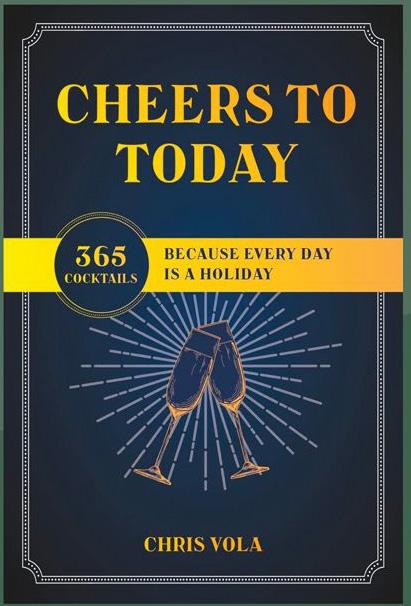


and precious moments of my kids’ lives over the past 13 years, but I’ve taken lots of photographs and videos,” she says.
She has an idea for another book, perhaps a novel, but she is not ready to write it yet. After a two-decade journey to bring Whatever the Future Holds to life, the next book can wait a while.
These books have been published or have been brought to our attention in the last year. The editors ask alumni to send updates and corrections to magazine@loomis.org for inclusion in this annual list.

loomischaffee.org 35
JOSH KURLANTZICK ’94 Beijing’s Global Media Offensive
• CHRIS VOLA ’03 Cheers to Today: 365 Cocktails Because Every Day Is a Holiday JULIA ALLAIN ’10 Everything I Got: 30 Lessons on What You Give, What You Get, and How You Grow Through Sports COLIN PHELAN ’16 The Local School
ANNIE SEYLER ’83 The Wisdom of Winter • TERRY JACOBS WALTERS ’84 Nourish: Plant-Based Recipes to Feed Body, Mind and Soul CALEB KENNA ’88 Art from Above Vermont • AIMEE HOBEN ’89 The Third Way (a novel) • HEIDI ERDMANN VANCE MCCANN ’ 93 Whatever the Future Holds
SIDNEY J.P. HOLLISTER ’54 Learning to Dance with French • RALPH D. SAWYER ’63 Lust and Assassination in Early China • KEITH E. BOMBARD ’73 TobaccoNet (First in the Jason Kraft Mystery Series) • The Red-Hooded League (Second in the Jason Kraft Mystery Series) • ANTHONY FLORENCE ’76 Hell’s Heaven: A Metamorphosis in Costa Rica • NICHOLAS FILLMORE ’80 The Gospel of Satan (a novella)
ARTIFICIAL INTELLIGENCE & EDUCATION
The Process Is the Product
by Sara Deveaux, Director of the Kravis Center for Excellence in Teaching and Matt Johnson, Assistant Director of Academic Technology

industrialrevolutionfourth sentence overview
It felt like it happened overnight. On the precipice of winter break, ChatGPT lit the education world ablaze. Colleagues within and around Loomis Chaffee passed articles back and forth, e-mail inboxes filled with screenshots containing explanations generated on the fly by ChatGPT, an artificial intelligence software that generates natural language, of concepts we teach in our courses. During a full faculty meeting upon our return from winter break, we collaboratively experimented with the tool, generating an e-mail to a colleague asking for coverage for a class. What followed was as hysterical as it was astounding; we turned that request into a sea shanty: “So hoist the sails and man the helm,/ I’ll provide all the materials you’ll need,/We’ll weather this storm together,/ And I’ll be forever in your debt, indeed,” it wrote.
36 Loomis Chaffee Magazine Spring 2023
The fourth industrial revolution is a fusion of digital, physical, and biological systems, characterized by the integration of advanced technologies such as AI, robotics, the Internet of Things, and 3D printing, leading to unprecedented levels of automation, efficiency, and productivity in various industries.
voice subject era
Lurking behind the amazement and the buzz, however, is an inconvenient truth: The emergence of generative artificial intelligence (AI) is poised to threaten the status quo of American education. While so much learning happens in the classroom, written work crafted out of class often demonstrates evidence of that learning.
As we saw in the faculty meeting, this tool is capable of creating whatever we ask it to in a fraction of the time that it would take to do outside of the classroom. So how do we counter the power of this tool and teach students how to use it productively? Given our reflective faculty and curious student body, Loomis is well positioned to do so. We are an academic community of students who earnestly want to learn. We have a dedicated faculty bent on creating relevant and meaningful learning opportunities. But the mere existence of the technology may mean that teachers now must make ever clearer the value of the work we do in order to learn — be it writing, speaking French, doing physics labs, or researching history.
Given the reality of this new technology and the fact that Loomis Chaffee is not an institution that is inclined to bury its head in the sand, it will come as no surprise that we have begun to tackle these larger philosophical and practical questions head on, and that we have transitioned from the reactionary phase to the discovery phase. Over the past two months, we have formed a generative AI working group, one that is considering everything from the potential possibilities of this technology to enhance our pedagogical practices as well as the student experience, to disciplinary reactions should the technology be used inappropriately. We
style
humor
have also held two “Coffee with Colleagues” sessions (time dedicated to pedagogical discussions every Thursday morning) in the Kravis Center, where a large group of teachers shared their thoughts on generative AI and the possible implications from both the student and teacher perspective. Teachers spoke of this technology helping them to craft discussion questions and fine-tune grading guidelines for particular writing assignments. Some Loomis teachers also have begun to experiment with using generative AI as a learning tool. For instance, some have asked students to use ChapGPT to help them edit their papers; others have had students ask ChapGPT to write a paragraph and then the students have edited the generated prose. Teachers also are talking with their students about the technology, identifying its limitations and discussing ways it can be used appropriately.
So what are the implications of generative AI such as ChatGPT in an academic setting? As Loomis Chaffee educators are grounded in reflection, we are used to refining our practices. We will continue to collaborate with one another formally and informally to determine if our teaching practices of the past (how we design lessons and assess students, for example), are still relevant. Although we have always valued the process through which our students learn, we often place more value on the products: out-ofclass essays, projects, tests, final exams. To what extent do we need to reconsider the way we assess our students, given that generative AI can deliver in seconds an answer to a writing prompt, or even write a surprisingly good poem? Often, learning happens from having done something, regardless of the quality of the end product.
With increased emphasis on the process over the product, many teachers have become more deliberate about the revision stage of paper-writing, for example. Ultimately, the emergence of this technology is an opportunity. We have no choice but to reflect deeply on what matters most in education, starting with the opportunity to rethink how we assess our students and how we ask students to demonstrate their learning. Those in the performing and visual arts have long understood and embraced this emphasis on process. “Even after the kids perform, they are never done. They are always going to want to do something more to enhance and build upon the success they experienced,” said Sue Chrzanowski, head of the Performing Arts Department. “The product is still an integral part of the process.” Still part of the process, but not the only thing.
Despite the myriad think pieces making broad declarations about the end of high school English or the future obsolescence of teachers, we know that the real value of education lies in learning in a community. As a residential school, in the shadow of the COVID-19 pandemic, we know now more than ever the value of the relationship forged between student and teacher. The arrival of generative AI is certainly a paradigm shift, one that will continue to bring change in the coming months and years, but it should not threaten our mission. Ultimately, there are more questions than answers right now. But we can sense that the classrooms of the not-too-distant future may look rather different than they do today. We are excited to get there using the best tool we have always had as teachers: each other.
loomischaffee.org 37
The Kravis Center and Pearse Hub for Innovation (PHI) are hosting a symposium for peer schools on generative AI on April 25.
Field investigative report on Vietnam, Laos, Cambodia, the Philippines, Greece, and nuclear weapons in Europe.




38 Loomis Chaffee Magazine Spring 2023
James G. Lowenstein ’45
Fact Finder James G. Lowenstein ’45 helped change the course of the Vietnam War
By Jeff Otterbein
Price Lowenstein grew up in the Georgetown section of Washington, D.C., in the 1960s. O “One of the first things I remember is that our phone was tapped,” Price says. “The phone in the house, you’d pick it up … I was 10 years old, you’d pick up the phone, and there would be two clicks and a five-second delay and dial tone. Occasionally you’d hear agents talking to one another over the phone, so it was not very subtle.” O “I remember saying, ‘Hey, mom, what’s going on with the phone?’ She said, ‘Ah, it’s that bastard J. Edgar Hoover.’’’ O “‘Who’s J. Edgar Hoover?’” O “‘Ah, he runs the FBI.’” O “‘Why does he want to listen to my phone calls?’” O “‘Well, it’s not you, but President Nixon doesn’t like what your dad is writing about the war.’”
Price’s dad, James G. Lowenstein ’45, died January 3, 2023, at the age of 95. He was a Foreign Service officer, went on many missions overseas as a staff consultant for the Senate Foreign Relations Committee, worked for the State Department, was ambassador to Luxembourg and co-founded the FrenchAmerican Foundation. James also helped bring to light that the American people were being misled on the Vietnam War by their own president. Nixon was known to have Hoover and the FBI conduct wiretaps on various people he perceived as domestic enemies.
Between 1969 and 1973, James and colleague Richard Moose went to Southeast Asia seven times on assignment for the Senate Foreign Relations Committee, headed by
Senator J. William Fulbright. They were sent to Vietnam for the first time in December 1969 to assess the situation on the ground, their report in early 1970 capturing the attention of virtually every major news outlet in the United States by contradicting what the government was telling the American people about how well the war was going.
In a conclusion section of the unclassified report, they wrote: “Dilemmas thus seem to lie ahead in Vietnam as they have throughout our involvement in this war that appears to be not only far from won but far from over.”
Years later, in a 1994 oral history project by the Association for Diplomatic Studies and
Training Foreign Affairs, James said, “This is an unexceptional sentence if you look at it on its own, but in the context of the mood in the United States at that time, it had extraordinary resonance and produced, as I say, this enormous rash of publicity.”
The headlines ranged from “Senate Study Questions Optimism on Viet War (Washington Post) to “Vietnamization: Policy Under Fire” (Time Magazine).
Vietnamization was a strategy to reduce American involvement in the Vietnam War by withdrawing troops and transferring military responsibility to South Vietnam in its fight against a North Vietnamese takeover. It would not work.

“In the summer of 1969, there were many statements by [Nixon and others in the administration] that Vietnamization would succeed, was in place and that the policy was going to permit the war to be ended on American terms. This position was more or less accepted as gospel by the public,” James said in the oral history project.
That one sentence in the report’s conclusion contradicted the administration’s argument in favor of Vietnamization, that it could bring the war to an end sooner.

“What this fact-finding mission in 1969 does for Congress is that it finally helps it get a handle on exactly what is going on because for a number of years the administrations of Lyndon Baines Johnson and then Richard
Nixon were not being transparent with Congress about what the United States was involved with militarily,” says Katherine Scott, associate historian, U.S. Senate Historical Office. “It’s huge, absolutely huge because what it does is document, concretely, that successive administrations had been lying to Congress about the progress being made in Vietnam. [Congress] realizes it has the information it needs to help reshape policy in Vietnam.”
James and Moose continued to uncover things wherever they went, including that the U.S. Embassy was secretly coordinating bombings against insurgents in Cambodia.


Before going on these special missions for the Senate Foreign Relations Committee, James
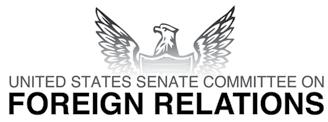
Between 1969 and 1973, James and colleague Richard Moose went to Southeast Asia seven times on assignment for the Senate Foreign Relations Committee, headed by Senator J. William Fulbright. They were sent to Vietnam for the first time in December 1969 to assess the situation on the ground, their report in early 1970 capturing the attention of virtually every major news outlet in the United States by contradicting what the government was telling the American people about how well the war was going.
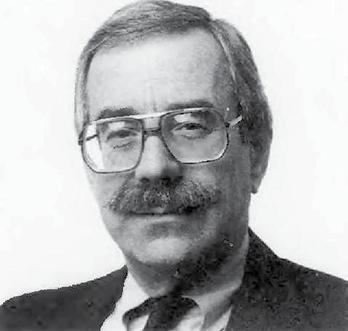
had honed his investigative techniques because of what he had seen when he was part of Congressional delegation visits. He worked on the Senate Foreign Relations staff from 1965 to 1974 and had gone overseas many times before he and Moose were sent on missions by Fulbright.
“He learned a lot about how the military tries to keep these [Congressional] members in the dark by booking them from the time they get up in the morning to the time their head hits the pillow at night, so they don’t have time to go out and gather information in an unmanaged way,” Ms. Scott says. “That experience was helpful for him.”
James and Moose gathered as many documents as they could before leaving on these missions
This page, above: Richard Moose, James’s co-investigator for the Senate Committee on Foreign Relations. Opposite page, top: James, third from right, speaks at a Senate committee hearing. Right: President Lyndon B. Johnson signs the Gulf of Tonkin Resolution in 1964. The legislation in effect empowered the president to wage war with U.S. troops in Vietnam without further Congressional approval. Other photographs on these two pages are news images from the Vietnam War.

40 Loomis Chaffee Magazine Spring 2023
and then spent time on the ground talking to as many people as possible, using interpreters to ask questions of villagers.
“There had been a fairly small group of senators questioning Vietnam,” Ms. Scott says, “and what they gathered helped grow that minority into a larger group. Still a minority but larger, and I think what that group did was put a lot more pressure on the Nixon administration.”

Congress had lost power when it passed the 1964 Gulf of Tonkin resolution, which gave power to President Johnson to authorize conventional military force in Southeast Asia without a formal declaration of war by Congress. That allowed the war to continue to escalate. The Lowenstein-Moose investigations helped take back some of that power, holding the executive branch accountable. The United States would reduce its number of military personnel in the early 1970s before finally pulling out all troops by late March of 1973. A peace accord was signed, but it failed, and by 1975 South Vietnam fell to communist forces. Nixon had resigned by then, leaving office August 9, 1974, amid the Watergate scandal.
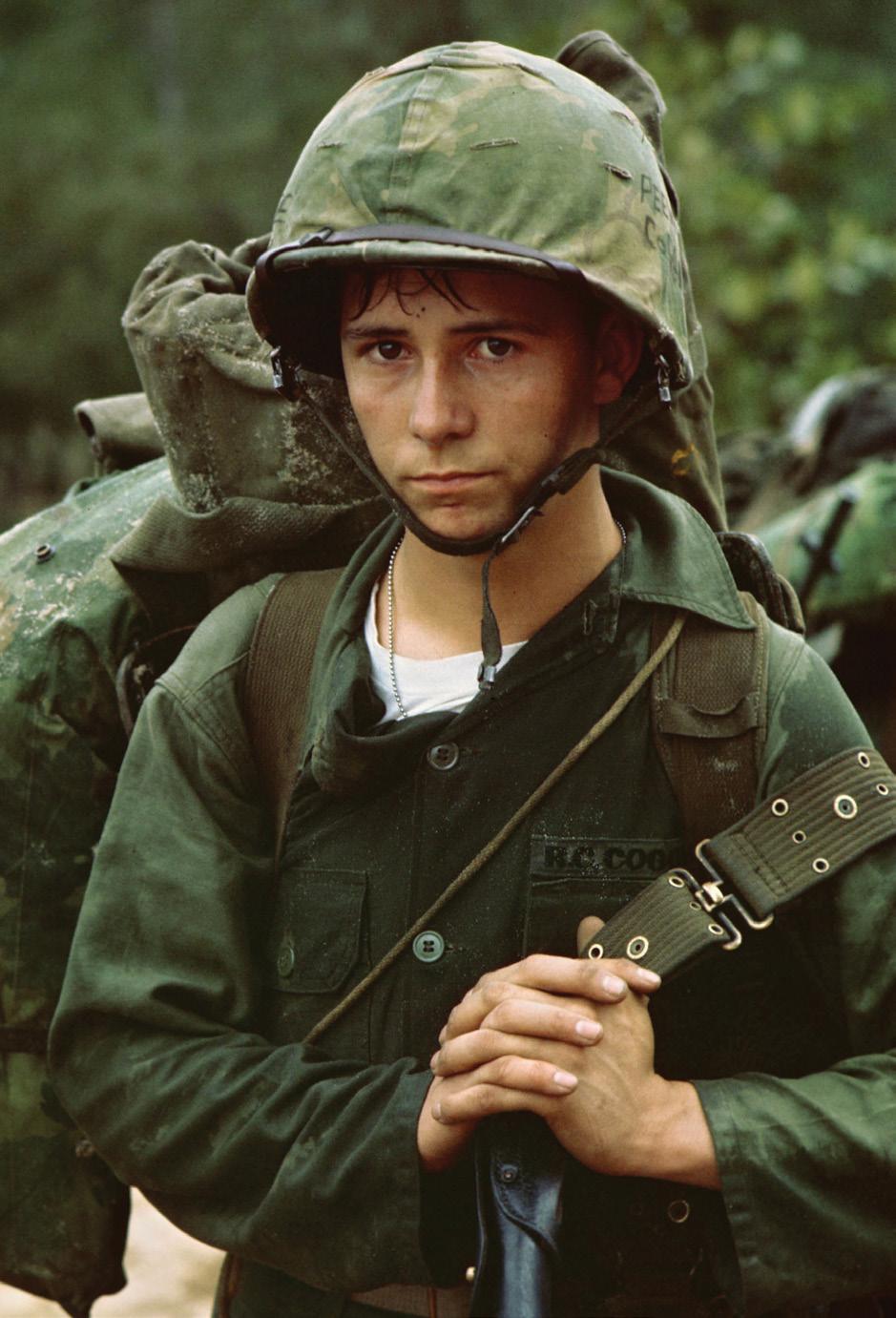

James and Moose, while not household names, were featured in a national news magazine on June 25, 1973.
“These reports got so much publicity that a few Senators began to complain that the ‘staff’ was getting more attention than the members of the committee,” James said in the oral history project. “Dick and I were often asked to join Sunday morning talk shows and be interviewed. We were always asked not to do so, which was perfectly OK as far as we were concerned. But we couldn’t control the press coverage. We had a half page in Newsweek with pictures of the two of us, for example.”
That 1973 Newsweek article opened with: “Their plots don’t titillate, and their writing doesn’t swing. They have never been at the bottom of the bestseller list, much less the top. But co-authors James Lowenstein and Richard Moose have an impressive audience. As globe-trotting fact finders for the Senate Foreign Relations Committee, their studies have become must reading for anyone seriously interested in American foreign policy.”
One senator was quoted in the article as saying, “They have a nose for facts, and they have been able to find out a lot we do not know.” There also was high praise from a member of the media: “They cut through the government cover-up and get the real story.”
That Newsweek story from 50 years ago describes James and Moose as somewhat opposites who came together to get the job done: “The balding, cigar-smoking Lowenstein exudes the quiet capability of a Park Avenue psychiatrist, and his diplomatic, Ivy League manner puts high-level officials at ease. The 41-year-old, Arkansas-bred Moose, by contrast, looks like a slightly mod Civil War cavalry officer — and by his own admission is a might more blunt.” Moose had thick sideburns to the bottom of his ears and a bushy mustache.
loomischaffee.org 41
James was born August 6, 1927. His father, Melvyn, was a New York lawyer who once had Babe Ruth as a client. Melvyn served as an executor of Babe Ruth’s will and as secretary and a director of the Babe Ruth Foundation for underprivileged youth. James’s mother loved to travel, perhaps giving him that desire. His great grandparents bought President Ulysses Grant’s summer home from Grant’s widow in 1893, which became his family’s summer home until it was sold during World War II.
James arrived at Loomis in 1942 with World War II raging. With some faculty and local workers serving in the military, students were doing new types of work, from proctoring study halls to tutoring to taking care of the
school grounds. He wrote and edited for various school publications, was in the Press Club, Political Club, Ski Club, and Tennis Club, among other extracurricular activities. He would play tennis his entire life, competing in the 90-and-over National Clay Court singles championships in 2017.
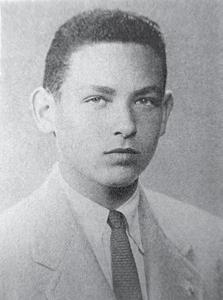

James G. Lowenstein 1927–2023
1927 Born August 6, Long Branch, New Jersey
1945 Graduates from The Loomis School
1949 Graduates from Yale University
1950 Enters government service in February as a Foreign Service staff officer at Marshall Plan European Head quarters in Paris
1950–51 Detailed to Sarajevo from December 1950 to June 1951 with the U.S. Special Mission to Yugoslavia and from October to December 1951 as a staff aide on the U.S. Delegation to the Temporary Council Committee of NATO
1952 Enters Naval Officer Candidate School in January, commissioned as ensign in May and for the next three years serves on the USS Coral Sea and subsequently on the staff of the Naval War College. Completes Naval Reserve Service with the rank of lieutenant.
1956 Commissioned as Foreign Service officer. Assignments follow in the Department of State and the American embassies in Colombo and Belgrade.


1965–73 On the staff of the Senate Foreign Relations Committee then led by Senator J. William Fulbright. The field investigative reports he and a colleague, Richard Moose, produce on Vietnam, Laos, Cambodia, the Philippines, Greece, and nuclear weapons in Europe attract considerable press attention.
1974 Returns to the State Department as principal deputy assistant secretary of state for European affairs under Secretary of State Henry Kissinger

1976 Co-founds the French American Foundations in Paris and New York
1977 Appointed ambassador to Luxembourg, where he remains until 1981

1982 Retires from the Foreign Service
Source: Lowenstein obituary

“He was always very fond of Loomis, and being there during the wartime years, it was a formative time in his life,” Price says.
James didn’t give up skiing until he was 83, according to a biography, From the Marshall Plan to COVID-19: James G. Lowenstein at 94, written by John Seaman in 2021. After he retired from the Foreign Service in 1982, James founded a small consulting firm. He also remained active in foreign affairs. And his love of travel never waned as he visited nearly 50 countries. On March 12, 2020, wrote Mr. Seaman in the biography, James was in London when he was told a travel ban would soon go into effect because of COVID-19. James booked a flight to the United States that afternoon.
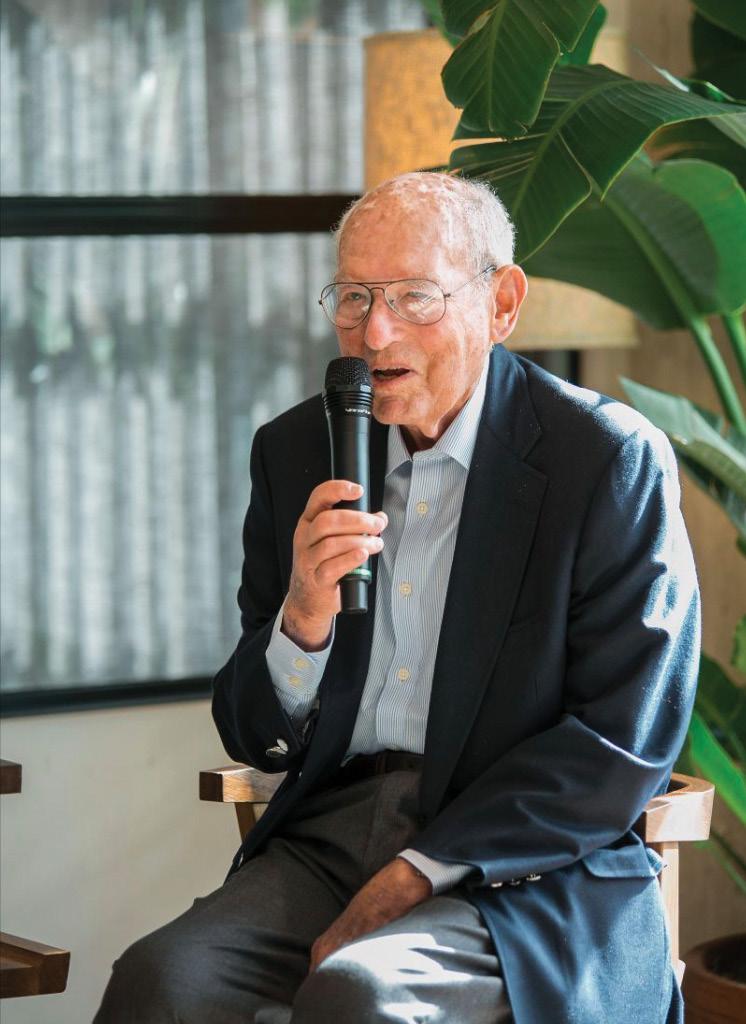
42 Loomis Chaffee Magazine Spring 2023
Price remembers his childhood home as a “hotbed of intellectualism,” in which he was invited to sit and listen at times to the conversation.

“There was a constant stream of diplomats and professors and foreign policy people coming in and out, and my mother also was an anti-war intellectual,” Price says.
“I was very politically aware at a young age and started going to anti-war marches when I was 11. I couldn’t help but be interested in foreign policy and foreign affairs and curious about the world. I am hugely appreciative of growing up in that environment and always wanted to travel and learn more about other places and other people.”
Price recently retired as the president of
Sovereign Risk Insurance Limited, one of the world’s leading underwriters of political risk and sovereign credit insurance. He helped create the company in 1997 as its first employee.
One can only imagine being in the presence of James, with all his historical knowledge.
“He was a fantastic human, with a great life story,” says Matt Siegel ’84, who is the godfather of Price’s daughter Haley. “Our families go back seven decades. He was a great character, full of wit, charm, and insight. He is missed by friends and family in our heated discussions of the world and regular debates around the dining table. I do miss talking with him, especially as the global climate — both politically and environmentally — is so heated at this point.”

“He was always very fond of Loomis, and being there during the wartime years, it was a formative time in his life.”
— PRICE LOWENSTEIN
Opposite page, top to bottom: The greatgrandparents of James once owned President Ulysses S. Grant’s summer home in Long Branch, New Jersey. • James, with his daughter Laurinda holding the Bible, takes the oath of office as ambassador to Luxembourg in 1977. • James’s portrait from the 1945 Loomiscellany, the Loomis yearbook. James later in his life. • This page, above: James, at left, meets at the White House with Deputy CIA Director Frank Carlucci, National Security Advisor Zbigniew Brzezinski, and President Jimmy Carter in 1977. Left: Tennis was always a passion. James is pictured here (on the right) at the 90-and-over U.S. Tennis Association nationals.

loomischaffee.org 43
Read an obituary for James Lowenstein ’45 on page 55.





















OBJECT LESSON
Stamp of Approval
By Karen Parsons
Loomis Chaffee History Teacher & School Archivist
Fifty years ago, the Loomis Stamp Club met on Sunday afternoons in Huntington Lounge. Long admired across America as an “everyman” hobby (all one needed to get started was access to delivered mail), by the 1970s, stamp collecting at Loomis Chaffee included a “multitude of glassine envelopes and cigar boxes” holding donated stamps and several albums into which students sorted and posted the club’s collection while also growing their own personal collections. Samuel Cutler, faculty advisor to the group and now curator of the Mequon River Postal Museum in Wisconsin, described these meetings in a 1972 Loomis Bulletin article. A donation of 1930s stamps by Samuel Title ’43 was a highlight that year.
Samuel Cutler followed history teacher Bud Porter as club advisor and recalled English teacher Adrian Bronk’s guest appearance at a meeting. “He was a great fellow, quite unassuming. … Adrian had ‘dabbled’ in stamp collecting and still had a few stamps, so I asked him to show the boys what he had. To my surprise and the amazement of everyone, he had … the first two U.S. stamps issued in 1847. These were the ‘Holy Grail’ for U.S. stamp collectors. For Adrian it was ‘no big deal,’ but for the rest of us, we had eyes big as saucers.” During the 1940s, when Samuel Title was a three-year member, the club met at the home of advisor Howard Morse for many of the same activities as their later counterparts in Ammidon.
Loomis students may have known they shared a hobby with President Franklin D.
Roosevelt. FDR began stamp collecting at age 8, and, according to the National Postal Museum, spent time every day with his collection even while serving in the Oval Office from 1933 to 1945. During his first presidential campaign, The Wall Street Journal described FDR as a “voracious stamp collector,” and later White House-issued photographs of the president working on his stamp albums helped to popularized the hobby. Sheila Brennan’s detailed history Stamping American Memory examines FDR’s efforts to use limited-issue postal stamps to market his New Deal programs to the American public and build national pride, in part, with the sublime beauty of the American landscape. He worked closely with Postmaster General James Farley to design a stamp to support Admiral Richard Byrd’s second expedition to Antarctica in 1933 and, during the next year, suggested the idea of a series depicting national parks to encourage tourism. These, according to Ms. Brennan, subtly endorsed the Civilian
Conservation Corps, supported by New Deal legislation and integral to building trails, shelters, and infrastructure at national parks. Samuel Title’s gift included the 1935 stamp reissue for collectors only — one unperforated and ungummed full sheet for each of 10 parks in the series — and full sheets celebrating the Chicago World’s Fair, Mothers Day, Byrd’s Expedition, and others.
In 1932, working in her Loomis studio, sculptor Evelyn Longman completed her frieze design for Hartford’s Federal Building, a stylized depiction of the Pony Express as its centerpiece and celebration of the U.S. Postal Service. Throughout the 1930s, The Loomis Log carried ads for Hartford’s Hobby Shop where “postage stamps and all the accessories” could be purchased. And in 1933, The Loomis Institute embarked on its own project of making images of its beautiful landscape. Artist Donald Witherstine created etchings of well-known views: Loomis Homestead, Chaffee House, William H. Loomis Hall, Warham Hall from the Senior Path, the chapel’s Palladian window, and a view of Founders Cupola seen through the Head’s Garden. These were available for purchase and used as gifts to alumni and friends of the school.
Opposite: Postage stamps, including many highlighting U.S. national parks, in the Loomis Chaffee Archives. Above: President Franklin Delano Roosevelt maintains his lifelong stamp collection in this historical photo from his time in office. Photo courtesy of Franklin D. Roosevelt Presidential Library & Museum

loomischaffee.org 45
History teacher Rachel Engelke sets up a work nest in the Brush classroom where she teaches College-Level Comparative Government & Politics, College-Level European History, and Germany and the Holocaust. A comfortable, familiar setting with everything she needs at arm’s length, her work space is on one side of a rectangle of tables — an arrangement conducive to the discussions that are central to Rachel’s courses. Rachel has taught at Loomis Chaffee since 2000 and has served
as a department head, tennis coach, dorm faculty, and an advisor to Model United Nations delegations, student publications, and other activities. Although she has an office in Brush, she prefers working in the classroom even when she’s grading, preparing lessons, or conversing with students and colleagues between classes. “I like to sprawl out and lay things out in piles, which is harder to do in my office,” she says. She makes sure she can easily pack up when she shares the classroom with other teachers.
Faculty Desks
 RACHEL ENGELKE
RACHEL ENGELKE
A one-a-day history calendar. Each day Rachel reads out the event, and her students try to guess the year it happened. Guess correctly, and you get to keep the slip of paper.
Books and readings for the Germany and the Holocaust course

A mug from the George W. Bush Presidential Center in Dallas, given to Rachel 10 years ago by two of her students who visited the center during a college visit and thought it would be funny to bring back some Bush-related gifts.

Rachel’s Comparative Government students read articles throughout the year from Foreign Affairs, a journal to which Rachel has subscribed for more than 25 years.

A custom mousepad, a birthday gift from one of her European History classes this year

The insightful observation about government and efficiency came from a fortune cookie Rachel received in a take-out order.

46 Loomis Chaffee Magazine Spring 2023
NEWS FROM THE ALUMNI/ DEVELOPMENT OFFICE

FEBRUARY 2, 2023 • NEW YORK CITY



Head’s Holiday
48 Loomis Chaffee Magazine Spring 2023
ALUMNI GATHERING NEWS FROM ALUMNI / DEVELOPMENT
Top: Alumni gathering at Stout to celebrate the tradition of Head’s Holiday Below
Left: Stephanie Niles ’11 and Fred McNulty ’11 Right: Benjamin Rosenblatt ’16, Anita Richmond Schulman ’16, Bryce Loomis ’16, and Isabella Epstein ’16
ALUMNI GATHERING
Leadership Reception


OMAR ZAKARIA ’02
It’s not an overstatement to say that my experiences at Loomis Chaffee were some of the most foundational and formative of my life. One commonly hears alumni talk about the quality of the education, the caliber of the relationships, and the degree of support from the faculty, and it’s all true; Loomis is peerless when I recount my experiences to people who’ve gone to similar schools. But even more valuable — to me, at any rate — was the diversity in experience, in people, and in opportunities available, and an environment that was willing to nurture not just one or two aspects of a growing teen, but all aspects, even the ones unknown to the teen themselves. From robotics to wrestling to theater to astronomy, and through all the rigorous academics, I found teachers willing to support and encourage me in every way, even when I was frankly quite lousy, starting off. But you need not be good at something to learn to love it, and becoming one’s best self requires being in a place that encourages love in the face of the difficult. Loomis was that place for me, and I hope to grant future students that same place and that same chance by including the school in my estate plans. Ne Cede Malis, after all.
For more information about planned gifts and the John Metcalf Taylor Society, please contact Associate Director of Development Heidi E.V. McCann ’93, P ’23, ’25 at 860.687.6273 or heidi_mccann@loomis.org.
www.loomischaffee.giftplans.org
JANUARY
26, 2023

• NEW YORK CITY
loomischaffee.org 49 Submit a Class Note Send your news to us! Email the Class Notes Editor at magazine@loomis.org to share news with classmates and friends. High-resolution photographs are welcome; please clearly identify all people. Class Notes appear on the school website and social media channels.
Top: Sarah Lutz ’85, Associate Head for External Relations Nat Follansbee, Kimberly Kravis ’93, and Head of School Sheila Culbert Bottom: Barnaby Horton ’87; Trustee Mary Bucksbaum Scanlan ’87; Andrew Kurian ’87, P ’23, ’25; and John Bussel ’87, P ’21
Above: Omar with his wife, Malissa, and their little one, Samir
ALUMNI GATHERING
Washington, D.C. Reception
DECEMBER 6, 2022
Top: Associate Head for External Relations Nat Follansbee, Stevie Gillespie P ’93, Head of School Sheila Culbert, Gardy Gillespie ’63, P ’93 Top Right: Kelly Williams P ’26, Monifa Tarjamo P ’23, and Mary Agboli P ’26 Right: Josh Singh ’16, Simone Singh ’13, Nat, and Rachel Walsh ’17


ALUMNI GATHERING

Chicago Reception
DECEMBER 8, 2022
Top: Reception hosts Harvey Struthers ’60, P ’85, ’96; Mary Struthers P ’85, ’96; Duncan MacLean ’90, P ’24; Susan Lyons P ’16, ’19; Doug Lyons ’82, P ’16, ’19; and Kendra Wallace ’91, P ’24 with Head of School Sheila Culbert and Associate Head for External Relations Nat Follansbee Top Right: Jamie Kopp ’11, Lily Potter ’21, Milton Lee ’18, Grace Lyons ’19, Audrey Zhang ’21, and Arman Pannu ’20
Right: John Rutledge P ’21, Amanda Rutledge P ’21, Jenny Ames P ’24, and Paul Lazarre P ’24



50 Loomis Chaffee Magazine Spring 2023
NEWS
FROM ALUMNI / DEVELOPMENT
Vero Beach Reception
FEBRUARY 21, 2023
11th Annual Philanthropy Day

February 23, 2023
Thank you to everyone who supported our 11th Philanthropy Day. This year’s campaign secured a gift of $150,000 from a generous group of trustees.
1,260 Donors $680,294 New Philanthropy Day Record
Donors by Affiliation
51% Alumni
20% Parents
18% Students
9% Parents of Alumni
8% Faculty and Staff
5% Grandparents and Friends
*Many of our donors enjoy more than one affiliation to the school.

Top 4 Areas of Support
Greatest Need Financial Aid Athletics
Diversity, Equity & Inclusion Initiatives
REGISTRATION IS NOW OPEN!
Alumni Classes with the most Donors by Decade
1950s Loomis Class of 1952
1960s Loomis Class of 1969
1970s Class of 1977
1980s Class of 1982
1990s Class of 1998 – 25th Reunion

2000s Class of 2001
2010s Class of 2017
2020s Class of 2022
Gifts from Around the Globe Brazil, Canada, China, Czech Republic, France, Hong Kong, India, Nigeria, South Korea, Thailand, Ukraine, United Kingdom, and 42 U.S. states
June 9–11, 2023 | Register Today!
The countdown to Reunion is on! Classes ending in 3s and 8s — this is your year! Return to the Island and reconnect with classmates, faculty, and friends, and see what is happening at Loomis Chaffee.
Make your plans today! To register and find out more about the weekend, visit https://www.loomischaffee.org/alumni/reunion
Questions? Contact Michelle Carr at michelle_carr@loomis.org or 860.687.6815.
loomischaffee.org 51
ALUMNI GATHERING
Top: Caroline Reese ’10, Head of School Sheila Culbert, and Katherine Reese ’17 Bottom: Max Laverty ’03, Kristin Ludington Zammit ’81, and Caroline George ’10
ALUMNI / DEVELOPMENT
JOIN LC Connect
Loomis Chaffee’s alumni engagement platform
LC Connect is an online community and resource for alumni that makes it easier than ever for Pelicans to stay connected to each other and with the school. LC Connect is an opt-in networking platform, powered by Graduway, that enables alumni to:
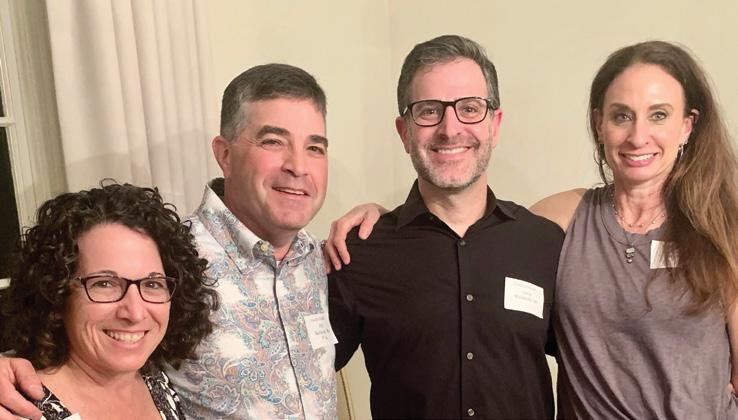

• Find and re-engage with fellow alumni through the online directory and groups
• Expand professional connections through mentorship opportunities and a job board
• Stay up to date with Loomis Chaffee news and activities through an alumni events board and the school’s social media channels
• Have on-the-go access through the LC Connect mobile app
Register at www.loomischaffeealumni.org
LC Connect replaces Loomis Chaffee’s Evertrue app and Career Network, upgrading the alumni experience by providing several resources in one platform.


ALUMNI GATHERING
Pelicans at the Ballpark
Join Loomis Chaffee alumni at Dunkin’ Park in Hartford and at Boston’s Fenway Park to root on your favorite team.

Saturday, June 17 • 7:15 p.m.
Boston Red Sox vs. New York Yankees
Fenway Park
Saturday, June 24 • 7 p.m.
Hartford Yard Goats vs. Erie Seawolves
Dunkin’ Park
For more information and to register online, visit www.loomischaffee.org/alumni
Questions? Contact Michelle Carr at michelle_carr@loomis.org or 860.687.6815.
Atlanta Reception
FEBRUARY 23, 2023
52 Loomis Chaffee Magazine Spring 2023
Above: Director of Development Tim Struthers ’85, Chris Demko ’96, and Colin Ingersoll ’85
Right (Top): Kerith Rudnicki P ’15, Phil Rudnicki ’86, P ’15, Eliot Rudnicki ’90, and Susan Rudnicki
Right: Head of School Sheila Culbert, hosts Kimberly and Keith Cowan ’74, and Associate Head for External Relations Nat Follansbee
Winter Brunch for Young Alumni
WAYS TO GIVE
Credit Card
JANUARY 11, 2023 SCANLAN CAMPUS CENTER, LOOMIS CHAFFEE
Top: Mariapaula Gonzalez ’22, Gavin Anderson ’22, and faculty member Lauren Williams
Bottom: Madison Carr ’21 and Simone Moales ’21
Did you know that you can donate to Loomis Chaffee in a variety of ways? Thank you, as always, for your support and please let us know if you have any questions about making your gift this year. You can reach us at 860.687.6276 or annualfund@loomis.org.
Reconnect with fellow alumni at regional receptions across the country. Visit www.loomischaffee.org/alumni for event information.
We look forward to seeing you soon at one of the upcoming gatherings.
Recurring Gifts
The fastest way to support Loomis Chaffee is by credit or digital wallet online at www.loomischaffee.org/give. You can also make your gift by calling 860.687.6276 to provide your credit card information.
Recurring gifts are a great option for donors who want to maximize their gift, with the convenience of automatic renewal. Donors can give to Loomis Chaffee in monthly or yearly installments at www.loomischaffee.org/give.
Stock Transfers Gifts of securities offer significant tax advantages and are easy to make. Donors avoid capital gains tax on the appreciation and receive a deduction for the fair market value of the stock. Please refer to our website for transfer instructions.
IRA Transfers If you are 70 ½ or older and own a traditional or Roth IRA, you can transfer up to $100,000 in a given tax year to a public charity of your choice, including Loomis Chaffee.
Donor-Advised Funds
A donor-advised fund (DAF) is a type of giving vehicle that allows donors to easily support their favorite charities. Donors may also be eligible for certain tax benefits. An increasingly popular charitable option, DAFs are an excellent way to both simplify charitable giving and facilitate your strategic philanthropic goals.
Wire Transfers Donors may support the school by making their gift via domestic or international wire transfer. Electronically transferred funds should be payable in U.S. dollars. Please notify our office in advance of your intent to wire funds.
Check Donors can make checks payable to:
“The Loomis Chaffee School.”
Further details on how to support Loomis Chaffee can be found on our Ways to Give site at www.loomischaffee.org/giving/ways-to-give.
Support of Loomis Chaffee is always appreciated and will continue to make a direct and positive impact on the lives of our students, faculty, and staff.


STAY IN TOUCH
CONNECT WITH US ON SOCIAL MEDIA
loomischaffee.org 53
Linked In–Search for Loomis Chaffee Alumni
Page Name Loomis Chaffee Alumni
Tweet to and follow @loomischaffee
ALUMNI GATHERING
The 2022-23 Loomis Chaffee Annual Fund closes on Friday, June 30, 2023.
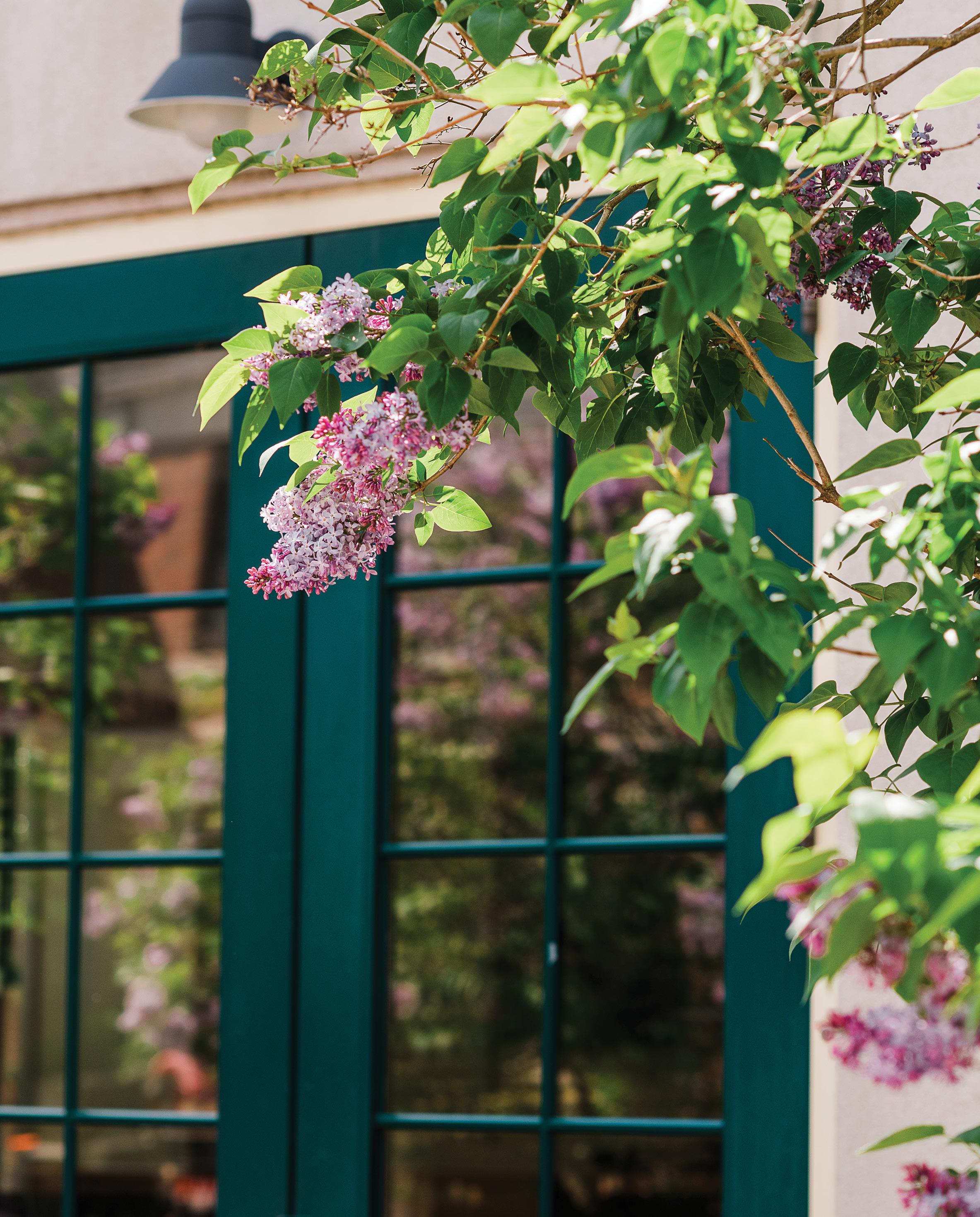
1938
Elizabeth Stoughton Kelly, of Farmington, Conn., on December 17, 2022. A four-year student, Elizabeth was president of the Athletic Association. After graduating from Smith College in Northampton, Mass., she served as an officer in the WAVES in World War II. Married to John W. Kelly in 1944, she then lived in Philadelphia; Richmond, Va.; Oklahoma City, Okla.; Stockholm, Sweden; and Lexington, Mass., following her husband’s career as a medical school faculty member. After their divorce, she earned a master’s degree in library science and worked in the Farmington Public Schools, retiring in 1985. A member of First Church in Farmington, she played in the bell choir, sang in the senior choir, and was church historian for many years. In 1979 she was a founder of the Association of Traditional Hooking Artists, now numbering more than 4,000 members worldwide. Predeceased by her son, John; and her sister, Jean Stoughton Carlson ’36, she was survived by her daughter and son-in-law, Susan and Leslie Robinson; John’s wife, Susan, and her son, Peter; four grandchildren; and five great-grandchildren.
1941
Betsy Fuller Bissell Olmsted Walsh, of Glastonbury, Mystic, and Groton Long Point, Conn., on January 22. She attended Chaffee and graduated from the Walnut Hill School. Betsy lived much of her early life in Suffield, where the family has deep roots extending back to its founding in the mid 1600s. She attended Connecticut College for two years, majoring in chemistry. She married Dexter Coffin, from whom she was divorced after the war. She married Theodore D. Olmsted Jr. ’39 in 1949 and was happily married until his death in 1987. She married Richard Walsh in 1997 and was also happily married until
OBITUARIES
his death in 2014. Betsy was a longtime resident of Glastonbury, where she raised her family and was active in the community. Betsy was an avid collector of antiques and loved researching her genealogy back many generations. She combined her passions for Connecticut history and antiques and became very active in the Antiquarian and Landmarks Society of Connecticut, where she served on the board and loved being a docent at The Phelps-Hatheway House in Suffield; the Glastonbury Historical Society; and Wadsworth Atheneum. She was a longtime member of the Congregational Church in South Glastonbury, where she taught Sunday school. She also was a member of the Junior League, volunteered at the Newington Children’s Hospital, and was frequently a den or scout mother for her kids. She loved her family and playing bridge, tennis, and the piano, particularly “Rhapsody in Blue.” She also loved chocolate. In addition to her husbands Ted and Richard, Betsy was predeceased by her sister Emily Loomis and her brother, Charles “Bud” Bissell Jr. She was survived by her sister Sumner F. Bissell; three children, Dorothy “Dede” Olmsted Mensel ’71 and her husband, P.J.;Theodore D. “Dwight” Olmsted ’74 and his wife, Mary; and Bob Olmsted; four grandchildren; seven great-grandchildren; extended Walsh family members; and many nieces and nephews.
1945
James Gordon Lowenstein, of Washington, D.C., and Paris, on January 3. He was a four-year student, lettered in soccer, played various other sports, and was in multiple clubs, including the Political Club and the Press Club. James was born in Long Branch, N.J. After Loomis he received a bachelor’s degree from Yale in 1949. He entered government service in February 1950 as a
Foreign Service staff officer at Marshall Plan European Headquarters in Paris. He was detailed to Sarajevo from December 1950 to June 1951 with the U.S. Special Mission to Yugoslavia and from October to December 1951 as a staff aide on the U.S. delegation to the Temporary Council Committee of NATO. He entered naval officer candidate school in January 1952, was commissioned as ensign in May, and for the next three years served first on the USS Coral Sea and subsequently on the staff of the Naval War College. He completed his naval reserve service with the rank of lieutenant. In 1956, after completing the written and oral examinations, James was commissioned as a Foreign Service officer. Assignments followed in the Department of State and the American embassies in Colombo and Belgrade. From 1965 to 1973 he was on the staff of the Senate Foreign Relations Committee then led by Senator J. William Fulbright. The field investigative reports he and a colleague, Richard Moose, produced on Vietnam, Laos, Cambodia, the Philippines, Greece, and nuclear weapons in Europe attracted considerable press attention. He returned to the State Department in 1974 as principal deputy assistant secretary of state for European affairs under Secretary of State Henry Kissinger. In 1977 he was appointed ambassador to Luxembourg, where he remained until 1981. He retired from the Foreign Service in 1982. He then began a consulting practice, first with the IRC group and then APCO Associates. Concurrently he served on a number of European and American investment fund boards, including the chairmanship of the Ukraine Fund and Baltic Investments. In 1976, with the late Professor Nicholas Wahl, then at Princeton, he founded the French American Foundations in Paris and New York. His memberships include the Council on Foreign Relations, the American Society of the French Legion of Honor, the Metropolitan Club in Washington, the Knickerbocker, Century and River Clubs
loomischaffee.org 55
in New York, the Travelers and Polo Clubs in Paris as well as the Harbor Club in Seal Harbor, Maine, where he spent 50 summers. He held the rank of officer in the French Legion of Honor and was decorated with the Luxembourg Grand Croix of the Couronne de Chene. His two marriages, to the late Eudora Richardson of Washington and Anne de la Selle of Paris, both ended in divorce. He is survived by his longtime companion, Audrey Wolf, and two children from his first marriage, daughter Laurinda Douglas, and son Price; three grandchildren, James and Haley Lowenstein and Alex Douglas; as well as a brother, Peter D. Lowenstein. Another brother, Hugh P. Lowenstein, predeceased him.
1946
Donald McCord Lynn Jr., on January 13, in Southern Pines, N.C. A two-year student, Don played multiple sports and was a member of many clubs, including the Glee Club and the Chess Club. Don was born in Cleveland, Ohio. After spending several years in Cleveland and later in Elmira, N.Y., as a child, Don and his younger brother Richard Lynn ’51 left home to attend Loomis in order to escape a polio outbreak. Don graduated from Loomis at age 16, attended Hamilton College in Clinton, N.Y., and went on to medical school in Cincinnati, Ohio. It was there that he met an intelligent and lovely nursing student, Coralie, who became his faithful companion and partner in marriage for more than 70 years. Don was a dedicated, caring, and compassionate physician for seven decades. He began his career as a pediatrician, completed his residency in Denver, Colo., and served two years as a physician in the Air Force at Tinker Air Force Base in Oklahoma. After several years in private practice as a pediatrician, Don worked to achieve additional training in psychiatry in the mid 1960s. He switched his primary focus to mental health and went on to care for and advocate for special needs children for 30 years at the Elmira Psychiatric Center, part of New York State mental health and disability services. After retiring to North Carolina, Don continued working well into his 80s as a medical consultant to group homes that served adults with intellectual disabilities throughout Eastern North Carolina. Never one to back down from asking questions or doing what he believed in, Don happily remembered that his colleagues saluted his retirement with Frank Sinatra’s
lyrics “I did it my way.” As a person, Don was both an impressive intellectual and a connoisseur of joyful living. He and Coralie traveled extensively in all 50 states, in Canada, as well as on several trips to Europe, Southeast Asia, and the Caribbean. He loved to golf, ski, and be outside. He was an avid historian and loved reading, especially about his two favorite topics: Mark Twain and the Civil War. Don was a lifelong gardener and applied his appreciation of chemistry to soil, even taking the family station wagon to shovel fresh horse manure from a friend’s pasture, much to the chagrin of his children. Don and Coralie loved to visit art museums throughout the world, were patrons of classical music and the opera, and treated each trip with their family as an opportunity to learn and expand their horizons. He enjoyed adding his resonant bass voice to school and church choirs, and even took up painting later in life. Don and Coralie also shared a passion for healthy food, and he was an accomplished home chef. Nothing gave him more pleasure than sharing a meal and a bottle of wine with friends and family. Don was survived by his wife, Coralie; and five of their children, Cheryl McKay, Catherine Procaccini, David Lynn, Daniel Lynn, and Carol Lynn Blackwelder ’88. He will be remembered as “Opa” to 12 grandchildren and seven great-grandchildren. He was preceded in death by their first-born daughter, Rebecca; as well as by his brother, Richard Lynn.
1947
Robert Emmett Mullen Jr., of Roanoke, Va., on October 23, 2022. Bob was a three-year student and played multiple sports, lettering in soccer. He was born in Charleston, W.Va., and was raised in Hartford, Conn., where he earned a bachelor’s degree in science/engineering from Trinity College in 1951. He began his professional career with Aetna Insurance Company in Hartford in July 1951 but moved to Richmond, Va., later that year before moving to Roanoke, Va., in May 1955 to open the field office there and manage all of Aetna’s operations in southwestern Virginia. In 1962, Bob joined Davis & Stephenson Inc. in Roanoke as a producer, and eventually worked his way up to president in 1980, serving in that capacity until January 1995, when the firm was sold. He continued to work with the acquiring firm, McDonough-Caperton, until his retirement in 2000. Bob served
as president of the Independent Insurance Agents of the Roanoke Valley and on the Board of Directors, and subsequently as president, for the Independent Insurance Agents of Virginia. He also served on the National Agents Advisory Council and was its southeast chairman in 1979. Bob loved Roanoke Valley and devoted much of his life to serving his community. He was a member of the Roanoke Jaycees and served on its Board of Directors. He was active in the United Way of Roanoke Valley for many years, serving as campaign chairman in 1973 and as president in 1974. He also served as president of the Roanoke Rotary Club in 1974. He served on the Board of Directors and as president of Hidden Valley Country Club. Bob served the Roanoke Valley Regional Chamber of Commerce for many years, on the Backbone Club, on the Legislative Committee (chairman in 1993), and on its general Board of Directors. He served on the Board of Directors of the Roanoke Red Cross, and on the Board of Directors of the Shenandoah Club. He also was on the Board of Directors of the Juvenile Diabetes Foundation, serving as its president in 1991. He was awarded the Distinguished Service Award from the Roanoke Jaycees in 1987. Bob was a member of Raleigh Court United Methodist Church for more than 68 years, during which time he served as a senior high Sunday school teacher, as lay leader, and as chairman of the church’s Administrative Board. For eight years, Bob served on the Board of Pensions for the Virginia Conference of the United Methodist Church. He also served as a scout leader for Boy Scout Troop 2 for nine years. After retirement, Bob served as a volunteer counselor for SCORE, advising and working with entrepreneurs trying to start new businesses. Bob leaves behind his wife of 72 years, Virginia Lee “Ginny” Mullen; son David and his wife, Joanne; son Rick and his wife, Aliss; daughter Sara Cleland and her husband, Scott; six grandchildren; and four great-grandchildren.
1948
Nicholas Norton, of the North Westchester section of Colchester, Conn., on February 28. He lived his entire life on the land where his ancestors helped found this small New England town. Nick graduated from Bacon Academy in 1947 at age 16 before attending Loomis Chaffee. An Honor Roll student at Loomis, Nick was a member of the debate
56 Loomis Chaffee Magazine Spring 2023
team, the Glee Club, the Maroons, the Political Club, the Ping Pong Club, the Pelicans, Le Cercle Français, and the Dining Hall Committee, and he was in the cast of Seventeen. He played first-team tennis as well as Ludlow intermediate football, Ludlow junior basketball, and Ludlow soccer. After Loomis, Nick graduated from Haverford College in 1952. When he was at Haverford, Edward Murrow visited the college to interview a number of students and he chose Nick’s spoken essay to broadcast on his national radio program, “This I Believe.” After college, Nick served four years as a communications officer in the U.S. Naval Reserve at Sangley Point in the Philippines; Norfolk, Va.; and London. He then began work at the C.H. Norton Company, the family’s shoe board mill in North Westchester. After the passing of his father, he served as president from 1958 until its sale in 1966. During this time Nick also served a decade on the Colchester Board of Finance and was elected chair under both Democrat and Republican majorities. Nick went on to serve as Gov. Tom Meskill’s deputy commissioner and commissioner of welfare. While there, Nick noticed that many people regularly called the state with various questions. He decided to organize a dedicated bank of employees to field questions from the public across a range of topics — an effort that survives today as 211. Nick then went to Washington to serve as commissioner of welfare in the Department of Health, Education and Welfare (HEW) under President Ford. After that, he consulted on these matters with the U.S. Senate Finance Committee. Later, Nick served as a founder and chair of Grassroots East, the Republican organization for eastern Connecticut. He also served both as finance director and executive director of the Connecticut Republican Party during the 1980s. For 15 years he served as a member and chair of the Colchester Wetlands Commission. He also chaired the Open Space Commission, the Republican Town Committee, and the Bacon Academy Board of Trustees. He served as town moderator many times from the 1950s through the 2000s. Nick was kind, quiet, bright, honest, gentlemanly, and decent. He was a very good cook and a very good father. Most of all, he admired and adored the former Lynn Kilbourne, the woman he loved for more than 74 years. Nick was survived by Lynn, his wife of 69 years; his sons, Christopher ’76 and his wife, Carter; Andrew ’80 and his husband, Tom Fredette;
Jeremy and his wife, Jane; son-in-law Greg Giles; grandchildren Katie NortonMagovern ’04, Alexandra Norton ’05, Kiley Norton ’07, Oliver Norton ’10, and Sara Norton; three great-grandchildren; and, at the time of his death, two more great-grandchildren on the way. He was also survived by his sister Nan Wasniewski. He was predeceased by his daughter, Diana Giles, and his sister Pat Engel.
1950
Marianne Morrell-Schumann, on April 24, 2022, in Naples, Fla. She was a two-year student who was the junior class president as well as the president of the Glee Club. Born in Greenport, N.Y., she lived in Windsor, Conn.; Boston; and western Massachusetts from 1960 to 2019, when she moved to Jersey City, N.J. Marianne was a teacher, a teacher of the deaf, and an educator, having received a bachelor’s degree from Mount Holyoke College and master’s degrees in teaching and education of the deaf from Smith College in Northampton, Mass. She taught at Smith College Day School, Clarke School, and Willie Ross School for the Deaf for more than 20 years. She was a member of several Congregational churches in Connecticut and Massachusetts. She was also a member of the Fortnightly Reading Group in Northampton and Phi Beta Kappa. She was survived by her son, Steven Simpkin Sr., and his wife, Judy; three stepchildren, Monica Schumann, Bill Schumann, and Thomas Schumann; a
sister, Margaret Morrell Smith ’57, and her husband, Jim; three grandchildren; three great grandchildren; two nephews; a niece; and their families. Marianne was predeceased by two husbands, Jack W. Simpkin and Willy Schumann.
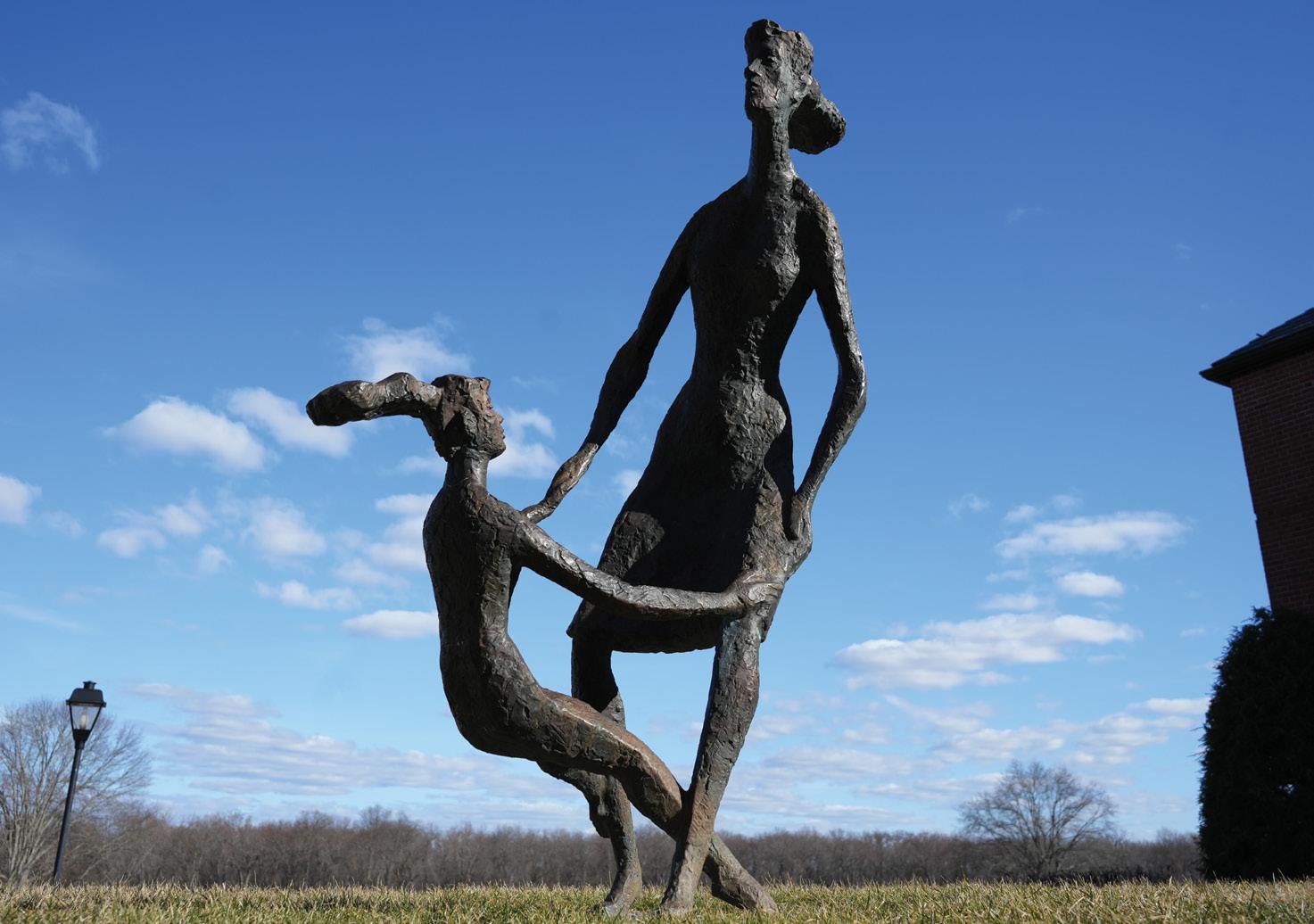
William John Pragluski, of Newington, Conn., on December 31, 2022. He was a four-year student who lettered in track and was in the Jazz Club and Radio Club as well as on numerous committees. Born in Hartford, he graduated from Massachusetts Institute of Technology in Boston with a bachelor’s degree in aerospace engineering, physics, and mathematics. Bill was a nationally respected aerospace engineer and was key to the success of all the Apollo space missions, the Mars Viking craft, and the International Space Station. His career accomplishments included work with Martin Marietta
Aerospace and the Gemini Space Program. As early as 1970, he was awarded NASA’s Engineer of the Year for design of the Viking Spacecraft mission and systems analysis. Bill was an avid reader and loved the ocean and boating. He had a great interest in all aspects of aviation. He enjoyed traveling anywhere, at any time, to do activities with his family. He was known as a caring, quiet, uncomplaining, wise, and generous person, always steadfast and honorable. He was not overtly emotional, but always had an uncanny sensitivity to others’ needs and would go above and beyond to meet anyone’s needs at any time. A loving father and grandfather, he was survived by his son, William F.
loomischaffee.org 57
Pragluski, and his wife, Carol Conley; his daughter, Donna M. Marks; brother-in-law Paul Martinook; his three grandsons; and a grandson-in-law. Bill was predeceased by his wife, Barbara Pragluski; his sister, Elinor Martinook; and a granddaughter, Sandra Catherine Porras.
Brooks George Dodd, on January 10, in Golden Valley, Minn., surrounded by his three sons. Brooks was a three-year student, played multiple sports, and was involved in committees and clubs. He was born in Orange, N.J., and spent his early years in West Orange before attending and graduating from Loomis. His summers were spent at Camp Calumet, a seven-week camp in Maine, first as a camper, and later as a cabin counselor. He attended Middlebury College, where he ran cross country and graduated with a degree in chemistry in 1955. After college, Brooks spent two years in the Navy as a medical corpsman assigned to the Marines. He then went to Harvard Business School, where he did a group project on the paper industry, graduating in 1959. Upon graduation, he set out on a career in the paper industry, a career which ultimately brought him to the Fox Valley. He started as a foreman on a paper pulp line in Longview, Wash. He
developed a love of mountaineering and climbed many ice-covered peaks, including the pre-eruption Mount St. Helens. Longview was also where he met his first wife, Anna Faye Gustafson, whom he married in 1962. They had two sons, David and Jeffrey, before moving to East Orange, N.J., in 1965, when he took a job selling paper pulp all over the world. In 1968 they moved to Appleton, Wis., where their third son, Paul, was born, and Brooks sold products used by the paper industry throughout the upper Midwest. In addition to traveling for work, Brooks traveled with his family all over North America, camping on the way. When his sons were out of the house, he and Anna Faye expanded their travels, visiting family members in Latin America, Asia, Africa, and Europe. Brooks retired in 2000 to take care of Anna Faye, who passed away in 2001. In 2003, Brooks married Betty Leisering. Together they prepared taxes for senior citizens and traveled all over the United States visiting family. Betty passed away in 2018. Brooks lived alone for a few years before moving to Minnesota to live with his son Paul and his family. Brooks’s ties to the paper industry led him to an early interest in recycling, something of which he was always proud. When working for a pulp manufacturer in the 1960s, he found a way of marketing a waste product from the production process that generated more income for the company
than the sale of pulp. And in the 1970s Brooks saved the family’s cardboard and scrap paper in an old playpen, dropping it off at a paper mill for recycling, until the city of Appleton started its own recycling program. Brooks was an active volunteer, as a Boy Scout leader, a Sunday school teacher and council member of his church, a host parent for A Better Chance, and a Loomis Chaffee class agent. After retirement he prepared taxes for seniors and served free lunches at a local church. Brooks was survived by his three sons: David and his partner, Catherine Sickle; Jeffrey and his wife, Mary; and Paul and his wife, Brooke; and four grandchildren.
1952
William Mancoll, on January 27. He was a four-year student who played football, tennis, and golf and wrestled. He was in the Photography Club and shot photographs for school publications. Bill was born in Hartford and lived his entire life in West Hartford. He was a graduate of Cornell University and Jefferson Medical College. He interned at Hartford Hospital and completed his residency at Johns Hopkins. When he retired in 1998, he was chief of otolaryngology at Hartford Hospital. Bill was known for his great kindness and exceptional intelligence. His family and friends cherished his great

58 Loomis Chaffee Magazine Spring 2023
1951
modesty, wonderful sense of humor, and extreme generosity. He enjoyed golf, bridge, and reading with his warm circle of friends. Bill was survived by his wife, Anita; two daughters: Rebecca Mancoll ’86 and her husband, Nick Petesch, and Rachel Mancoll Stam ’89 and her husband, Wendell; his son, Peter Mancoll ’93 and his wife, Sarah; and four grandchildren. Bill was predeceased by his twin brother Harry and was survived by his sisters Tovia Siegel and Isadora Safner.
1953
Thomas Alden Barber, on August 1, 2022, in Pacific Grove, Calif., surrounded by loving family. Tom was a four-year student who played three sports and was in the orchestra and Glee Club. Tom was born in Hartford, and he and his older sister, Didi, were raised in Connecticut. An artist and a scientist, he also enjoyed singing at weddings and loved cars and the hot rod club, where he became a pit boss. He worked in the Connecticut River Valley tobacco fields and on a dairy farm to earn money for college. He graduated in 1957 from Trinity College in Hartford, with a bachelor’s degree in physics and electrical engineering. He was a member of the Brownell Club, sang in the Trinity Pipes, and claimed he was the only man to be “depledged” from a fraternity “for fixing a broken window.” Tom married Edda Suzanne Wicks and went to work at United Aircraft in research and development. In 1959, he and Edda moved to Pasadena, Calif. The call of the “space business,” warmer winters, and a job offer with California Institute of Technology’s Jet Propulsion Laboratory (JPL) were too much to pass up. He worked for the next 34 years in many areas at JPL and continued his education, studying public administration at University of Southern California and receiving a master’s degree in engineering from UCLA in 1973. While at JPL, he worked with Detroit car companies and Congress, relating to the catalytic converter; he worked with the City of Pasadena, consulting in conceptual design and implementation of planning information systems; he was a project manager for electric car studies in the 1970s; and he was strategic planning office manager until his retirement in 1992. He was heard to say, “It’s not rocket science. … Oh, wait, yes it is.” His NASA baseball hat echoes the phrase. On the side, he became a noted handicapper and spent many happy hours with friends at the Santa Anita racetrack, played tennis, played guitar,
and sang at Neighborhood Church. In 1986, he married Ida Scherer at the Atheneum at Cal Tech. In 1992, they retired to Pacific Grove. Tom also said, “You must retire to something!” He chose many “somethings,” from watercolor to music to golf and traveling. He gave his grandchildren golf and watercolor lessons and told them about Richard Feinman and quantum physics. He enjoyed visiting with old and new friends — even strangers — engaging in lively repartee and double entendre to the end. Tom was survived by his loving wife, Ida; his daughters, Christine and Catherine; his granddaughter, Rebecca; his first wife, Edda; stepdaughter Debra and her husband, Bill; stepson Steve and his wife, Andi; seven step-grandchildren; a great grandchild; and several special friends.
Manny Myerson, on October 31, 2022, in Florida. He was a four-year student involved in multiple sports and in many clubs and on various committees. He also was assistant editor of Loomiscellany. Manny was an ear, nose & throat specialist in Connecticut for more than 30 years. He was proud of his military service in the Army as a captain and chief of otolaryngology at Bassett Army Hospital in Fairbanks, Alaska, from 1966 to 1968. He was awarded an Army Commendation Medal for meritorious service. He retired to Florida in 1999. Predeceased by his brother Paul Myerson, Manny was survived by his loving wife, Thelma; two children; three grandchildren; and his brother Daniel Myerson.
Nelson H. White Jr., of Vernon, Conn., on December 1, 2021. A four-year student from New Hartford, Conn., Nelson played multiple sports, including football and wrestling. He received his bachelor’s degree in math and physics from Trinity College and earned his master’s degree in computer science from Rensselaer Polytechnic Institute. Nelson was hired as a computer systems specialist at Pratt & Whitney as a representative to IBM for several years, and for 10 years taught computer science at RPI. He then returned to Vernon and worked for Travelers Insurance Company as the associate director of Commercial Systems, retiring after 25 years of service. He will be remembered as a loving and giving man. Nelson was an integral part of the Connecticut Science Fair, which showcased science projects for high school students. He spent 17 years as the president and presented and defended student projects, enabling the winners to participate in the International Science Fair. He was also an
advocate for the children who participated to receive awards and gifts for their projects to help further their education. In his retirement, Nelson supported his community of Quail Hollow and was the first secretary and president of the Quail Hollow Condo Association. Nelson loved to bowl and was an avid fan of little league baseball, and high school and college basketball and soccer. He and his wife, Patricia Candlin White, were huge fans of the UConn women’s basketball team and spent 17 years traveling all over the United States to support the program. In addition to Patricia, his loving wife of 64 years, Nelson was survived by his son, Keith White; his brother Kenneth White; his sister Patricia McDonough; several nieces and nephews and their families; his sister-inlaw Gail Wnuk; and other family and dear friends. Nelson was predeceased by two brothers, Donald and Robert White, and his sister Sandra White.
1955
Gerald Lawrence Mackler, on January 5, following a long illness. Recently of Ellicott City, Md., Jerry lived most of his adult life in Athens, Pa. He was a four-year student from West Hartford, Conn., who graduated as the top scholar. He played five sports, including football and basketball, and was in multiple clubs as well as contributing to school publications. After Loomis, he attended Harvard University, where he was elected to Phi Beta Kappa, and then received his medical degree from Columbia College of Physicians and Surgeons. He specialized in hematology and oncology during a residency at the University of Pennsylvania and a research fellowship at the National Cancer Institute in Washington, D.C., before moving to Athens, Pa., where he practiced medicine for many years. Jerry took special pride and pleasure in training medical students, mentoring many young doctors as part of his medical practice and through teaching at SUNY Binghamton. With his wife as partner, Jerry enjoyed many pursuits in his free time. The couple played doubles tennis and bridge and took their family on numerous cross-country ski adventures. A lover of classical music, he played the piano his entire life and participated in a trio with friends. Another joy was literature, with interests ranging from mysteries to the translation of Greek classics. He treasured his family above all. He will be remembered with great affection by all who knew him and all those
loomischaffee.org 59
whose lives he touched over his long career in medicine. Jerry was survived by his loving wife of 53 years, Birgitta; his four children: Niklas and his wife, Emily; Kirsten; Sasha and his wife, Ana; and Mattias and his wife, Karley; his sister, Karen Mackler ’65; and his seven grandchildren. He was predeceased by his brother, Richard Mackler ’57.
David Lawrence Wilkinson, December 10, 2022, in Provo, Utah. He was a one-year student and lettered in football, basketball, and track. For most of his childhood, David grew up in Washington, D.C., until his family moved to Provo in 1951. He served as a missionary for The Church of Jesus Christ of Latter-day Saints from 1957 to 1959 in the East German Mission. David earned degrees from Brigham Young University; Oxford University, where he was a Rhodes Scholar; and the University of California at Berkeley. He practiced law in California, Utah, and Washington, D.C., and served two terms as the attorney general of Utah (1981–1989). David met Tricia Thomas in the summer of 1976, and they married in the Salt Lake Temple in December of that year. They were foster parents to two teenagers and subsequently had four children, whom they raised in Utah and Northern Virginia. His family will remember him most for his curiosity and love of learning, his gift of conversation, and his witty sense of humor. He loved researching family history, reading the newspaper, ice cream, tennis, and BYU football. His children describe him as a wonderful father who supported them in their varied interests. He was survived by his wife, Tricia; his four children: Andrew and his wife, Brooke; Samuel and his wife, Sara;, Margaret and her husband, Tyler Cloutier; and Katherine and her husband, Frank Bright; his sister, Alice Anderson; and 17 grandchildren. He was preceded in death by siblings Ernest, Marian Jensen, and Douglas.
1960
William Daniel “Bill” Cutler, on February 14. Bill was a four-year student who played football, basketball, and baseball and was active in various clubs. Bill was born in Bloomfield, Conn., and he attended elementary and middle schools there. Bloomfield was more rural then; he walked the trolley tracks to school, briefly had a pet lamb, and fed pigs for his part-time job at Copaco. He graduated with a bachelor’s degree in American
civilization from Brown University, received a master’s degree in psychology from Wesleyan University in Middletown, Conn., and earned a doctorate in psychology from the University of Connecticut. He settled in Gales Ferry, Conn., in 1977. He and his wife, Mary, married in 1978, and they remained in Gales Ferry until 2018, when they moved to Mystic, Conn. He was a licensed clinical psychologist in private practice until his retirement. His passion was helping people through talk therapy. Bill walked two miles every single day for more than 30 years, beginning in 1989. Bill also enjoyed computers, playing trumpet, studying French, and visiting Sturbridge Village. He was survived by his wife, Mary; daughter Cara; and sisters Joyce and Mimi Cutler Willard ’71.
Richard J. Kilpatrick Jr., of Manchesterby-the-Sea, Mass., on December 14, 2022. He was a four-year student involved in multiple sports as well as the Debate Club, the Press Club, the Astronomy Club, and the school newspaper, The Log. Dick spent his early years in the home of his grandparents on Union Street in Manchester-by-the-Sea as World War II raged and all the young men in the family were away. A curious young lad, he snuck out and climbed to the top of a rock ledge behind their house and promptly plummeted into the “clothes” yard behind it, landing without injury in a large snow drift. This set a pattern for the rest of his years. After the war, a new business took the family to Hartford, and for many years the house in Manchester-by-the-Sea was the family homestead only when school was out in Connecticut. Dick was fortunate to
attend Loomis and then Boston College, experiences he treasured and gifts he used well. After three years as a U.S. Army officer during the Vietnam era, he joined his father (and later his brothers) in business with Hartford Office Supply Company. When his father retired, Dick was named president and chief executive officer of the firm and served in that capacity until the company merged with Staples Corp. in 2004. Shortly thereafter, Dick and his wife, Jackie, left Glastonbury, Conn., and returned full-time to their home in Manchester-by-the-Sea, escaping to Longboat Key, Fla., when the snows arrived on Cape Ann. Dick, his brothers, and their wives raised seven cousins who became and remain as close as siblings. Dick enjoyed every moment with every one of them. Once, on a whim, he hopped a plane to Ireland and upon return, announced that he had found and rented a house in Killarney’s Gap of Dunloe for six weeks. So, for a few years when the cousins were all at just the right ages, each family (sometimes with grandma Anita) enjoyed two emerald-green summer weeks in The Gap House. Dick was survived by his wife of 45 years, Jacqueline Booth Kilpatrick; son Scott Richard Kilpatrick ’98 and his wife, Lindsay; daughter Kara Kilpatrick Aardal ’99 and her husband, Christopher; five (soon to be six) grandchildren; brother Robert Gavin Kilpatrick and his wife, Rosemary; brother Kevin John Kilpatrick and his wife, Mary Sue; and many beloved cousins, nieces, and nephews. For Dick, a life well-lived was lived in the embrace of family, steeped in all its laughter and joys. His enduring kindness, gentle soul, and quiet example will be missed.

60 Loomis Chaffee Magazine Spring 2023
1963
Thomas Engel, on November 15, 2022, in an automobile accident near his home in New York’s Beaverkill Valley. Tom was a four-year student who lettered in football and lacrosse and was president of the Student Council, co-president of the Press Club, associate editor of Loomiscellany, and a reporter for and co-editor of The Log. He was co-chair of his 50th Reunion. Born in New York Hospital in 1945, Tom remained a longtime New York City resident, where he raised three children with his wife, Suzanne Gallaudet. He graduated from Harvard in 1967, where he was a devoted member of the Fly Club. After Columbia Law School, Tom practiced law as an assistant U.S. attorney in Manhattan and as founding partner of Engel & McCarney. He was a member of the Knickerbocker Club and the Board of the Academy of American Poets. A memorial service was held at St. Thomas Church Fifth Avenue in New York City on January 12. Tom was survived by his wife, Suzanne Gallaudet; his three children, Montgomery Engel, Phoebe Lindsay, and Alice Vartan, and their spouses; and seven grandchildren.
1967
Phillip Andrew Busby, on October 28, 2022, in Sunshine Beach, Queensland, Australia. He was a one-year student and lettered in track and field. He was a man with unwavering loyalty, deep integrity, and a wicked sense of humor. Phillip was survived by his wife, Susannah; his former wife Pam; his children and their spouses: Elizabeth, Matthew and Fiona, and Richard and Toni; stepchildren Simon, Robbie, and Claire; siblings Laraine and Geoffrey; and other cherished family and friends. He was predeceased by his stepdaughter Lucy and his former wife Gail.
1968
John “Moke” Mokotoff, on November 14, 2022, in Hudson, N.Y. He was a four-year student and member of the Photography Club, Religious Life Committee, and Political Debate Society. After Loomis, Moke attended and graduated from the University of California, Berkeley, where he studied expressive art and photography. For more than 40 years, Moke studied, collected, and dealt in the art of South and Central Asia,
including Tibetan art and ritual artifacts, ancient and imperial Chinese textiles, and Indian and Nepalese art. It was far more than an appreciation of the visual appeal; as a practitioner of Buddhism, he also understood the doctrinal content and devotional significance of the objects he handled. Moke maintained his own Asian art gallery in New York City from 1980 to 2003. As a collector and art dealer, Moke brought his knowledge of the history behind the art and its creators to museums and private collections around the world. Moke married Huiyun Wang in 1985, and together they raised their beloved daughter, Sophia, in New York City. In 2015 he married Claudia Coenen, adding to his family children, sisters, brothers, and, much to his delight, grandchildren. Among his many other qualities, Moke was a compassionate eccentric. He delighted in the unusual and the arcane, both philosophical and material. He always helped underdogs and was a generous, silent patron of monks, monasteries, nunneries, and causes near to his ideals. A scholar, entrepreneur, father, husband, and friend, he leaves behind his loving wife, Claudia; his cherished daughter, Sophia Sha Mokotoff; his sister and brotherin-law, Steffi and Bob Berne; a niece and nephew; and countless friends and relations he considered his sisters and brothers.
1969
Lee Virginia Fleming, on July 8, 2021, in Windsor, Conn., at her family home. She was a four-year student who was president of Chaffers drama club, had major roles in plays, was a reporter for the school newspaper, and was active in multiple sports. Lee was survived by her 14 cousins, her five beloved cats and faithful companions, and many other relatives and friends.
Read the obituary for Suzanne Nolan under Former Faculty and Staff.
1971
Ann Kenney, peacefully, surrounded by family, at her home in Hillsborough, N.C., on January 24, of cancer. She was a four-year student and president of the Current Affairs Club. Born in Cincinnati, Ohio, to John Robert Kenney and Joan Elizabeth Tilton ’45, Ann grew up in North Canton, Conn., with her four sisters. She attended McGill University, where she earned her bachelor’s degree, and
the University of Toronto Medical School, where she received her medical degree. Her 30-year career in family medicine included Parliament Health Associates in Toronto (1988–1997), the Family Medicine Residency Center in Tupelo, Miss. (1997–2002), and the Family Care Center in Tewksbury, Mass. (2003–2015). Ann was committed to social justice, for example, volunteering at free clinics and creating a college scholarship fund at her church. She created beauty and community around her: playing cello, hooking rugs, and cooking. She was survived by her husband, John Christian Elstad; her daughters, Emily and Rebecca, and their husbands, Josh and David; four grandchildren; her nephew Charles Kenney ’15; and her niece Zayneb Kenney-Shawa ’17.
1972
Ellen Katherine Kennedy, of Chestnut Ridge, N.Y., on November 14, 2022. Ellen had perfect attendance in her four years of high school and was later a Common Good Society member and class agent. After graduating from Chaffee, Ellen attended Mount Holyoke College, from which she graduated in 1976 as a theatre arts major. She worked at the Mount Holyoke Summer Theatre program and after graduation worked in management at several regional theaters in the Northeast. In 1982, she moved to Ithaca, N.Y., to become the managing director of Cornell University’s Theatre Department. In Ithaca, she met Chris Freitag, a graduate student in the Music Department, while playing tennis, and they married in 1991. Ellen’s professional focus shifted to fundraising. She worked for a time at Cornell’s Development Office in New York before she and Chris moved to Madison, Wis., where she had other fundraising and public relations roles with nonprofit organizations, including the Girl Scouts of America. They relocated to Chestnut Ridge in 2001. In addition to her family, Ellen had a rich and wide circle of friends dating back to her grammar school days, and she treasured those relationships. Family and friends alike admired her warmth, generosity, humor, and, in recent years, the courage, strength, and grit she displayed in dealing with her health issues. She was an avid tennis player and golfer. Ever her mother’s daughter, she loved the Connecticut shore, a lobster dinner, Christmas Eve, and the Kentucky
loomischaffee.org 61
Derby. She and Chris treasured travel, walking with their dogs, and spending time together. She loved cooking, the beach, a challenging crossword puzzle, and the company of books. Her grace, wit, and strength will be missed. Ellen was survived by her husband, Chris; a brother, John Kennedy III, and his wife, Carol; two sisters, Kate Doemland and her husband, Jeff, and Ruth-Anne Kennedy; and seven nieces and nephews. She was predeceased by her parents, John Kennedy and Anne King Kennedy ’39.
1978

Benjamin Edward Adam Phelps II, of Hebron, Conn., on February 16, at the West Hartford Rehab Center. Ben was a one-year postgraduate student. Born in Hartford, he grew up in East Hartford and graduated from high school there, where he lettered in football, baseball, and track. After his year at Loomis Chaffee, he attended Eastern Connecticut State College. He married his beloved wife, Candace Blasko, in 1982. The couple settled in Hebron, where they made their home and raised their family. Ben was a communicant at Church of the Holy Family, where he was also a member of the Knights of Columbus. He retired several years ago due to his declining health. During his career he was a successful sales representative for a building supply company. In his spare time, Ben was an avid bowler and loved to spend time with his family. He was survived by his wife, Candace; a son, Adam; a brother, Lawrence, and his wife, Joanne; three sisters, Catherine Phelps and her partner, Christine Neurath; Susan McAuliffe; and Priscilla and her husband, Jim Madden; his two beloved dogs, Holly and Haley; and numerous extended family members and friends. He was predeceased by his daughter, Melissa
Phelps; a brother, Leewood Shaw; and a brother-in-law, Donald McAuliffe.
2001

Christopher A. Vincent, on November 12, 2022, in Tampa, Fla. Christopher was a four-year student who was on the ultimate frisbee, cross country and soccer teams. Born in Rome, Italy, Christopher grew up in Italy, Massachusetts, Hawaii, Connecticut, and Arizona. He studied English, philosophy, and Italian and graduated magna cum laude in 2007 from the University of Arizona in Tucson. Christopher was an enthusiastic traveler and lover of food from his early childhood. During college, he apprenticed in the kitchens of the Arizona Inn, Soleil, and Terra Cotta in Tucson and decided to pursue a career as a chef. He studied at the Culinary Institute of America in Hyde Park N.Y., graduating in 2009. He worked at La Cachette and Tavern in Los Angeles before taking a position with Canlis and relocating to Seattle. While in Seattle, he expanded his restaurant business skills and broadened his expertise in food science with a focus on food as medicine. In Tampa, Christopher pursued healthy eating ventures, including juicing and whole foods, and most recently worked for Louis Pappas restaurants. Christopher was predeceased by his paternal grandparents, Norman Vincent and Sally Vincent, and his uncle, Joe Sweet, with whom he had been very close. He was survived by his mother, Jennifer Sweet ’78; his father and stepmother, Peter and Cathy Vincent; his siblings, Matthew, David, and Sarah Vincent; his maternal grandparents, Mark and Julia Sweet; another dear uncle, James P. Sweet; his aunt, Susan Sweet; his cousins, Ted and Gus Warmington; and considerable extended family and friends in New England, Rome, Seattle, and Tucson.
Faculty and Staff
Debbie Hicks, on January 26. Debbie joined the housekeeping team at Loomis Chaffee in 2020 and was a regular housekeeper for the Communications Office and Howe Hall. “Debbie had the biggest heart,” Ms. Tracy Cycenas, a member of the housekeeping team, told The Log, the school newspaper. “She was a second mom to many and knew everyone’s name.” Howe Hall resident senior Julie Kang said, “She always called us her ‘darlings’ and would leave us with positivity to power through the day.” Debbie’s service was held in Founders Chapel on campus with remembrances by family, faculty members, and students. When Head of School Sheila Culbert announced her death in an all-school email, she wrote that Debbie “was always a cheerful presence around campus with an infectious and joyful optimism.” Debbie is survived by her husband, Vincent, and her children, Dawn, Matthew, Victoria, and Elizabeth.
Ewen Alexander Watson Ross, on January 25, surrounded by his family after a brave, three-year fight against cancer. Ewen leaves a legacy of devoted love, caring friendship, joy in teaching and learning, and awe for the natural world. Ewen was born on January 11, 1972, in Northampton, England, and he lived in England and Scotland until he was 7 years old, when he moved to Connecticut. He graduated from Canton High School in 1990, where he played soccer and golf and participated in theater tech, and he continued his education at Worcester Polytechnic Institute in Worcester, Mass., graduating with honors with a bachelor’s degree in mechanical design
62 Loomis Chaffee Magazine Spring 2023
engineering in 1994. During his junior year in college, Ewen participated in a professional development project for engineers in London as part of the International Brotherhood of Foundry Workers. A member of Theta Chi fraternity, Ewen remained connected to the organization after graduating by playing in a fraternity golf tournament every summer. Ewen’s work in a co-operative program as a student engineer led to a job at Wiremold in West Hartford, Conn., where he was a rotation engineer and ultimately became a mechanical design engineer. He later worked at U.S. Filter in Chelmsford, Mass., then Cooper Instruments in Middlefield, Conn. While at Cooper Instruments, he volunteered as a mentor to the robotics team at Loomis Chaffee, and he discovered he loved mentoring, teaching, and working with students. The following year, he was offered and accepted a full-time faculty position at Loomis, where he was a member of the Science Department, teaching physics, advanced physics, astronomy, an interdisciplinary course on the Model T, and courses in engineering design and robotics. During his 22 years as a faculty member, Ewen also grew the robotics team into the thriving and successful program that it is today. As part of his faculty responsibilities, Ewen also served as a dormitory affiliate, academic advisor, coach of JV boys golf and ultimate frisbee, class advisor, Penn Fellow mentor, and assistant head of the Science Department. In each of these roles, Ewen enriched the lives of his students and colleagues, who were swept up by his infectious enthusiasm for learning and discovery. In February at the 2023 Connecticut FIRST Robotics Championships, Ewen was awarded posthumously

with the Compass Award, based on a video nomination by his robotics students. The award is given to a “beacon and leader on the journey of FIRST Tech challenge … an adult coach or mentor who has given outstanding guidance and support and demonstrates to the team what it means to be a gracious professional.” Ewen also worked in the Loomis Chaffee Summer Program for three years introducing young students to robotics, physics, and engineering. Ewen’s interests outside of work reflected his bottomless curiosity and his sense of wonder. He shared many a clear, starry evening gazing at the constellations and planets through telescopes and sharing this activity with friends and students. He was a skilled astrophotographer and a talented stained glass artist, and he took a keen interest in 3D art and fabrication. He also enjoyed metal detecting, golfing, and fishing. Early in his tenure at Loomis, Ewen met and fell in love with faculty member Lisa Salinetti, who is now the school’s director of alumni and parent relations, and the couple married in July 2004. Described by friends as “two peas in a pod,” Ewen and Lisa built a life together and raised their children, senior Elizabeth “Ellie” and sophomore Tyler, on the Loomis campus. Ewen and Lisa could always be found cheering on the sidelines of their children’s sporting events and other activities. Ewen was tremendously proud of Ellie and Tyler, and his deep love for them and for Lisa endures. Ewen was predeceased by his father, Eric Ross of Duns, Scotland, and his brother Duncan Ross of Duns, Scotland. In addition to his wife, Lisa Salinetti Ross, and their children, Ellie and Tyler, Ewen was survived by his parents, Sandra and Jonathan Festa;
his siblings Elizabeth Griffiths and her husband, Keith, and Alistair Ross and his wife, Theresa; sister-in-law Carol Ross; his parents-in-law, Dick and Judy Salinetti; his sister-in-law, Terri Salinetti Labrecque and her husband, Craig; his brother-in-law, Jim Salinetti and his wife, Hillary; many beloved nieces and nephews; and his comforting and much-loved pets, Linus and Pepper. Funeral services were held on February 1 at Saint Damien of Molokai Parish, St. Gabriel Church, in Windsor, followed by burial at Elm Grove Cemetery in Windsor.
Former Faculty and Staff
Marilyn A. Fatzinger Eaton, on December 1, 2022, in Norway, Maine. Marilyn was born in Springfield, Mass., and attended Springfield College, where she met her husband William “Bill” Eaton, who later became a coach and director of athletics at Loomis Chaffee. They married in 1955 and enjoyed nearly 61 years together. After many years of work as an educational consultant and tutor as well as track and field coach at Loomis Chaffee, Marilyn joined Bill in retiring to Norway, Maine, in 1997. She continued her work in public service, volunteering as a trustee of the Norway Public Library and as a member of the Heywood Club. Marilyn also loved to tend to her many perennial gardens, watch her beloved birds and deer in her backyard, and paddle her kayak in the many area ponds and lakes. She was survived by her children, Donna Eaton ’75, Deborah Eaton Lumbert ’76 and husband Jay, Dianne Eaton ’78, former faculty member Henry “Hank” Eaton ’81 and wife Mo; 10 grandchildren; and four great-grandchildren. Marilyn was a beloved wife, mother, grandmother, greatgrandmother, sister, aunt, cousin, and friend, and will be missed by all.

loomischaffee.org 63
Suzanne Nolan ’69 of Windsor, Conn., on February 21, after a brief illness. Suzanne was a four-year student who was president of the junior and senior classes and described in the yearbook as a super athlete and great leader. She won the Sellers Prize for leadership; the Spirit, Service, Sportsmanship Award for athletics; and the Outstanding Athlete prize. Suzanne played field hockey, basketball, and lacrosse. Suzanne taught in the Philosophy and Religion Department at Loomis Chaffee from 1977 to 1983. She started the school’s girls ice hockey program and was the varsity head coach. She also was an assistant coach of girls varsity lacrosse and an associate director of admissions. Several classmates emailed Loomis Chaffee with reflections on Suzanne. Alison Myers, whose photo is next to Suzanne’s in the yearbook, summed up what so many felt: “Suzanne embodied what the human spirit can be at its best: intelligent, capacious, kind, humble, brave. It’s heartbreaking that she has left the planet far, far too soon.” Suzanne graduated from Brown University, where she played varsity ice hockey and made history in 1973: She was a senior orator at the university Commencement, the first time both orators were women. In 1982, she earned a master’s degree in counseling from the University of St. Joseph in West Hartford. For almost a decade, Suzanne taught English and coached female athletes at Connecticut secondary schools. Her career aspirations evolved in these years, leading her to nonprofit work at Covenant House in New York and H.O.M.E. in Maine. Later, she explored hospital ministry, an expanding discipline that combined her faith, her natural gifts for connecting with people, and her commitment to offering compassionate care and counsel
to patients and families, often in the most difficult moments of their lives. From 1990 to 1996, Suzanne worked as a pastoral associate on Saint Bridget’s Church Collaborative Pastoral Team in Manchester. She then served as a chaplain at Manchester Memorial Hospital and Mercy Hospital in Springfield, Mass. In 2007, she was named director of pastoral care at Saint Francis Hospital in Hartford. An inspired leader, Suzanne was instrumental in developing and implementing a Certified Pastoral Education program and a one-year resident program for chaplains. After retirement, Suzanne continued her longtime participation as a Mercy associate. Mercy associates are men and women who make a covenant of service with the Sisters of Mercy to live mercy in their lives. She expanded her active engagement with St. Patrick–St. Anthony Church in Hartford, which she cherished for its unwavering commitment to building and supporting the diverse parish community. She also found more time to devote to her many interests, including golf, sailing, and gardening. Suzanne was survived by her husband, Christopher Wagner, with whom she shared a loving marriage and many adventures, particularly sailing the Cape Cod waters off Provincetown and Buzzards Bay; her brothers, John ’61, and David and his wife, Carol; and a large and loving extended family, including her nieces Suzanne H. Nolan ’91, Caroline Nolan ’94, and Danielle Nolan ’94.

Barbara Louise Davis Snow, of Windsor Locks, Conn., on February 19, at her home with her family by her side. Barbara spent 29 years as the bookstore manager at Loomis Chaffee, retiring in 2002, beloved by faculty and students alike.
Barbara was born in Hartford, and her family lived in a 12-room farmhouse in Coventry where her father, mother, sisters, her mother’s grandparents, and her aunt lived together. She attended a one-room school for first through third grade before moving to Windsor to live in the house her father’s parents built. She graduated from Windsor High School in 1955 and worked for the Phoenix Mutual Life Insurance Company, after which she moved to Aberdeen, Md., for six months and El Paso,
Texas, for a year and a half before settling in Windsor Locks in December of 1959. Barbara was a faithful member for more than 50 years of the First Church in Windsor and a member of the Windsor Historical Society. A dedicated daughter, mom, grammy, and great-grammy, Barbara was known for her love of family, far and near. Passionate about genealogy, she researched her family’s history by hand and digitized it in her retirement. She was proud to have documented her family lineage back to the Mayflower through multiple family lines. Barbara was a former Girl Scout in her mother’s troop and a cadette Girl Scout leader for her daughter’s troop. She loved to travel and explore. Her adventures started in 1949 when the Davis family took a five-week cross-country trip to California, camping along the way. Barbara took amazing trips to Ecuador, the Galapagos, and through the Panama Canal to Costa Rica with her daughter and family, and traveled to England with her sister, Marion, and her husband, Harry. Other trips included traveling with her in-laws through Germany to France, all over South Africa with her father and daughter, in Alaska with sisters Charlotte and Marion and brother-in-law Harry, to Hawaii with her best friend, Pat Kupstitus, and on many business trips all over the United States. She spent every summer tent camping, enjoying clam fritters, chowder, fried dough, and lime-aid with her family at Burlingame State Park in Rhode Island and reading on the sand at East Beach in Charlestown, R.I., which she continued to visit until the time of her illness. During the winters, Barbara was an avid puzzler and enjoyed UConn women’s basketball and feeding the birds outside her picture window. She was survived by her daughter, Robbin Willard, and her husband, Bruce; her two grandchildren and their spouses; three great-grandchildren; two sisters, Charlotte Mulligan and Marion Nelson and her husband, Harry; numerous nieces and nephews and their families; and her dedicated caregiver of the last two years, Joyce Boahen.
More News
The Alumni Office has learned of the passing of David P. Famiglietti ’96 on March 11, 2023; Elliott B. Sweet ’39 on February 28, 2023; Gloria Hanes Sinclair ’42 in the fall of 2022; and Kathleen Lennon ’07 on March 13, 2023. More information, as available, will be printed in future magazines.

64 Loomis Chaffee Magazine Spring 2023
REFLECTIONS
The Tale of Willow Cottage
Once upon a time, in the year 1929, a little house was built near some willow trees on a dirt road in Windsor, Connecticut. The house, known as Willow Cottage, was constructed as a “master’s cottage,” a home for a teacher at a school then known as The Loomis Institute. The house stood next to the school’s infirmary, Gwendolen Hall. Just across the lawn stood the school’s dining hall, where students and teachers ate their meals morning, noon, and night. Agriculture and biology teacher John Wolf and his family were the first to live in Willow Cottage.
Through the years, the school grew up around Willow Cottage, and when the little house was nearly 70 years old, the school (which had come to be called The Loomis Chaffee School) decided it needed to construct a new building on the knoll where Willow

Cottage stood. The new building, which would be named Sellers Hall, would welcome young scholars interested in attending the school and provide space for the school’s admissions and communications offices. Willow Cottage, however, was sweet and still in good shape, and Loomis Chaffee’s Trustees decided to move it rather than tear it down.
So on a fine summer day in 1998, Willow Cottage was hoisted onto a trailer. Pulled by a tractor, the house traveled happily along
the now-paved road and resettled on a quiet part of campus among other houses for teachers, a street known as Faculty Row. Compared to the often bustling corner where the cottage had previously stood, Willow Cottage’s new, quieter location suited the little house. Longtime science teacher Julie Hinchman; her husband, Pete Gwyn; and their dog, Ruby, live in the house, which looks out over the wetlands and hayfields at the southern end of the campus and goes to sleep at this time of year to the sound of spring peepers.
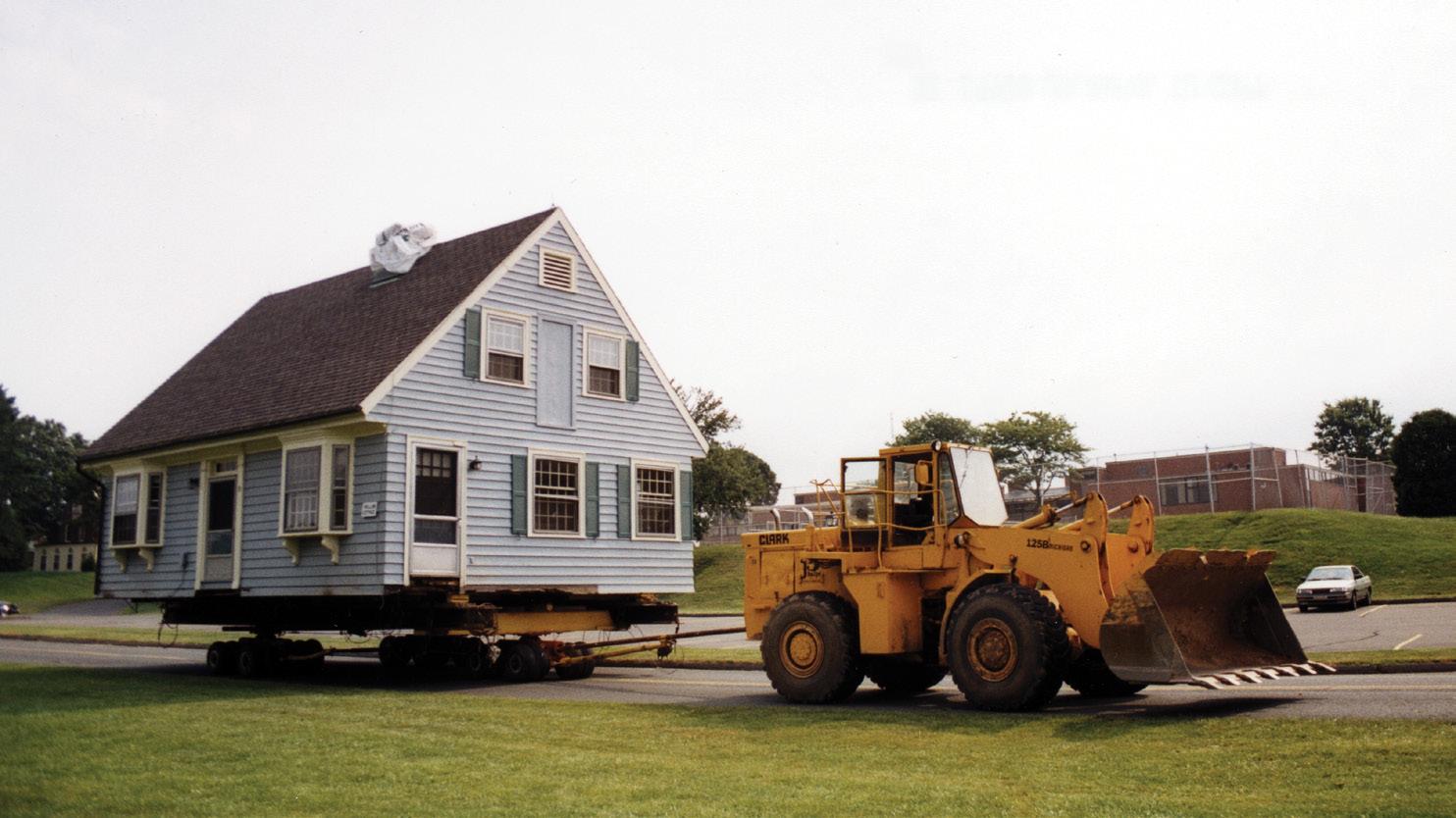
loomischaffee.org 65
Willow Cottage in its original location
Gwendolen Hall
Willow Cottage on the move to Faculty Row in 1998
The Loomis Chaffee School
4 Batchelder Road
Windsor, Connecticut 06095
CHANGE SERVICE REQUESTED
Performing to Taylor Swift’s “I Knew You Were Trouble,” the Dean Dream Team competes in the Faculty Lip Sync Battle in February in the Olcott Center. Pictured are Administrative Assistant Hannah Hayes; Deans of Students Mike Donegan, Stephanie Bissett, and Nick Barker; and Dean of Student Life and Wellness Jessica Matzkin.

Nonprofit Org. U.S. Postage PAID Loomis Chaffee School









 Photo by Cassandra Hamer
Photo by Cassandra Hamer



































































 by Becky Purdy
by Becky Purdy






























































 RACHEL ENGELKE
RACHEL ENGELKE








































